History of surgery HISTORICAL RELATIONSHIP BETWEEN SURGERY

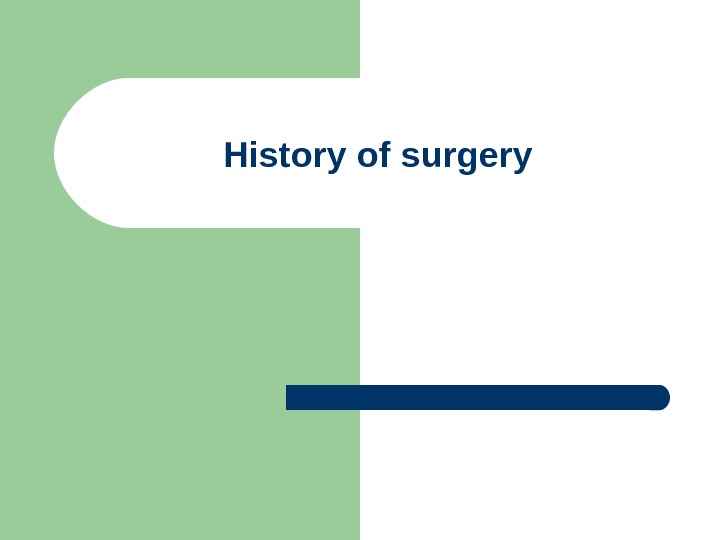
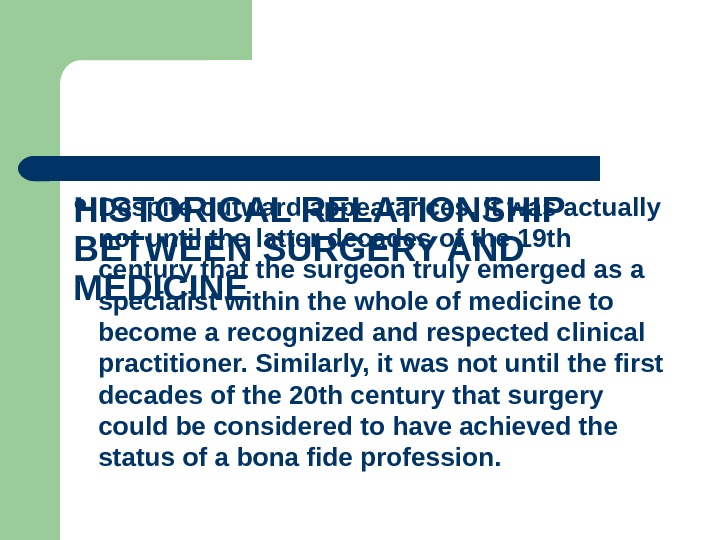

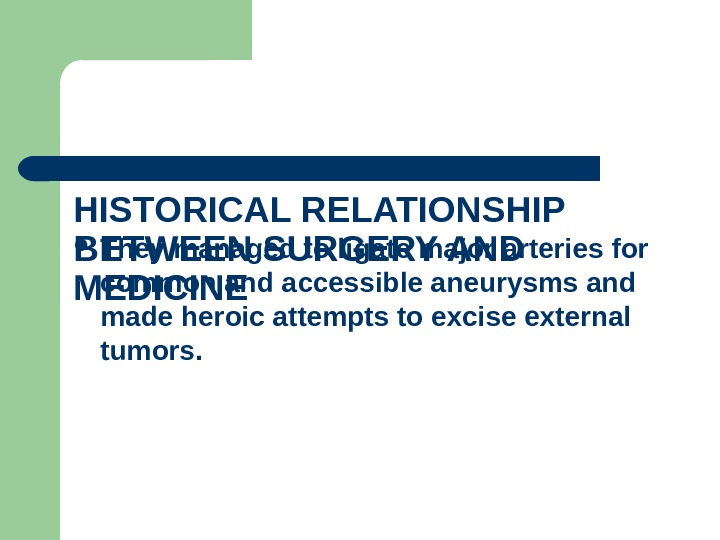
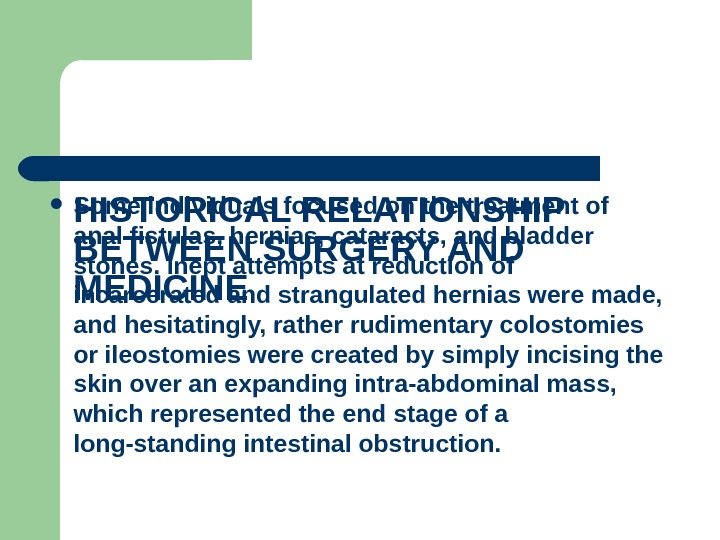
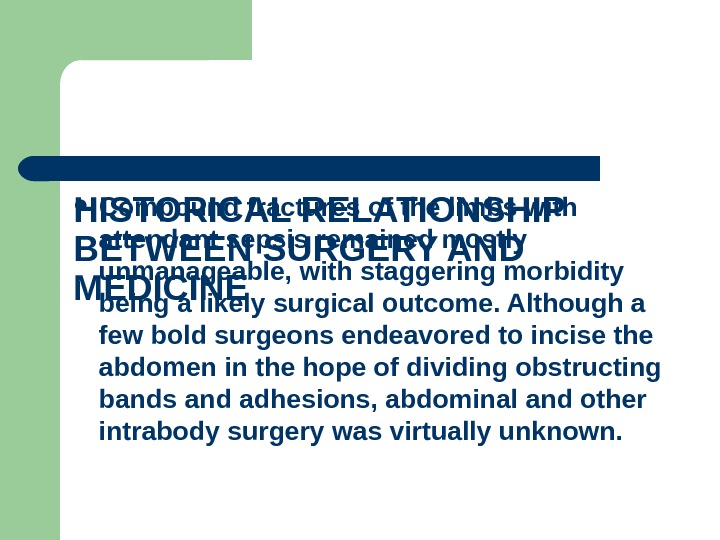
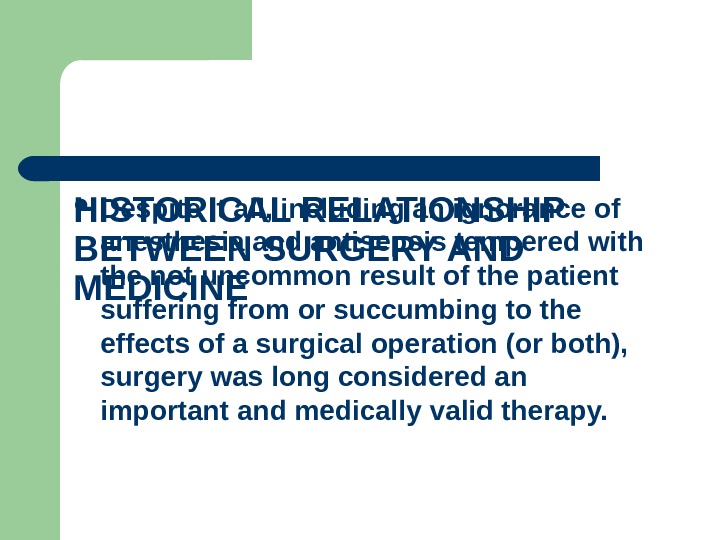
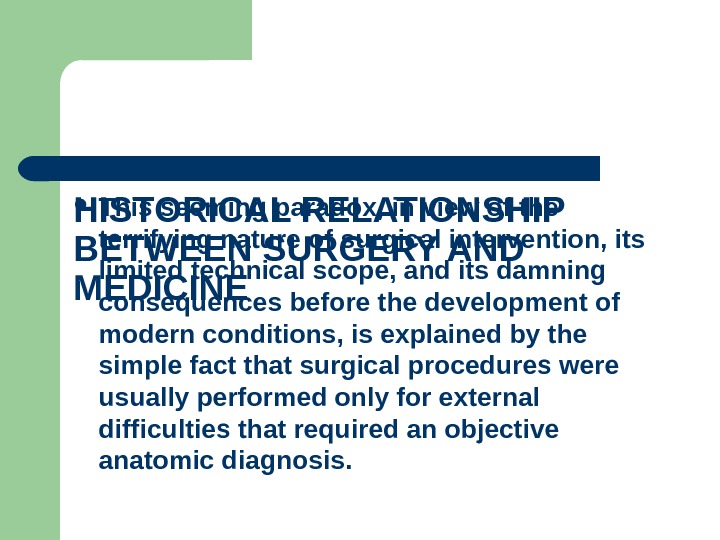
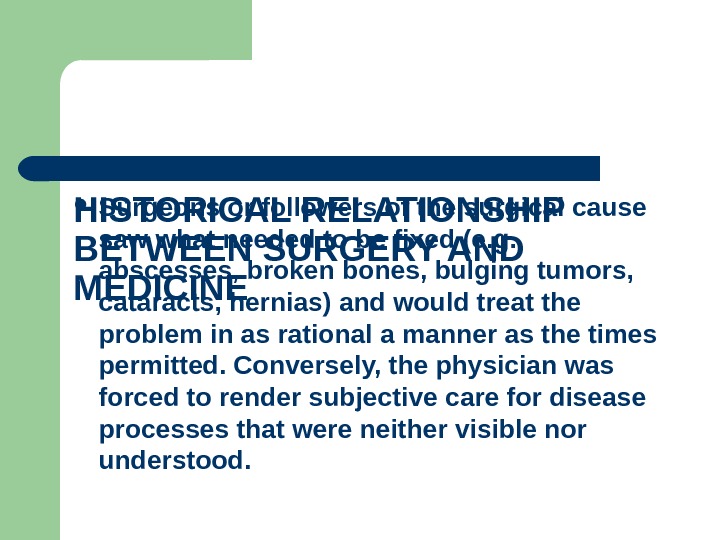
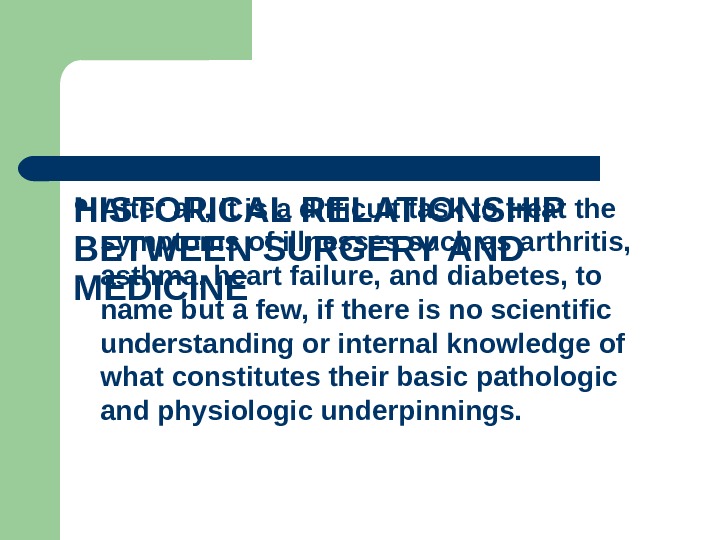
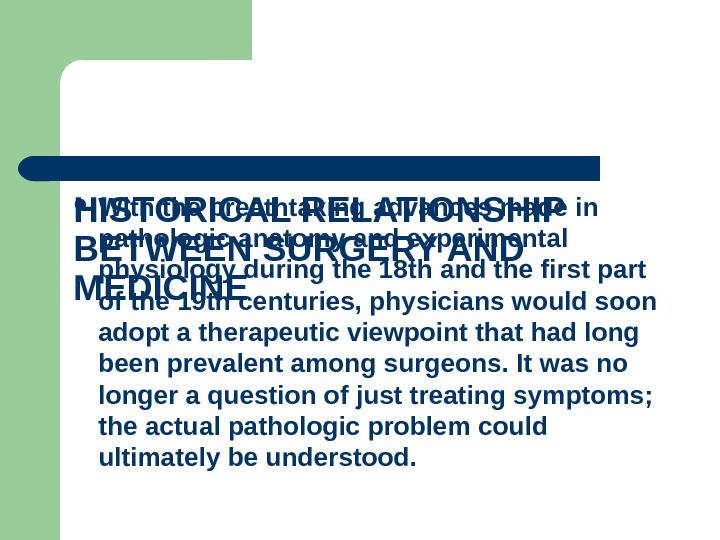
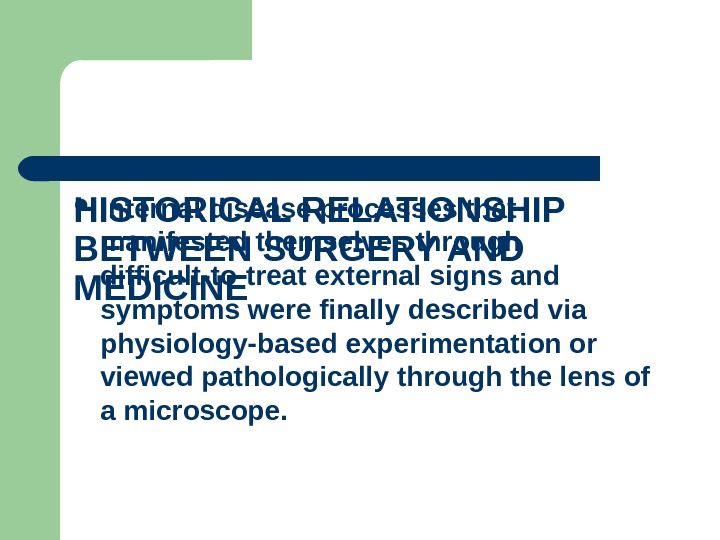
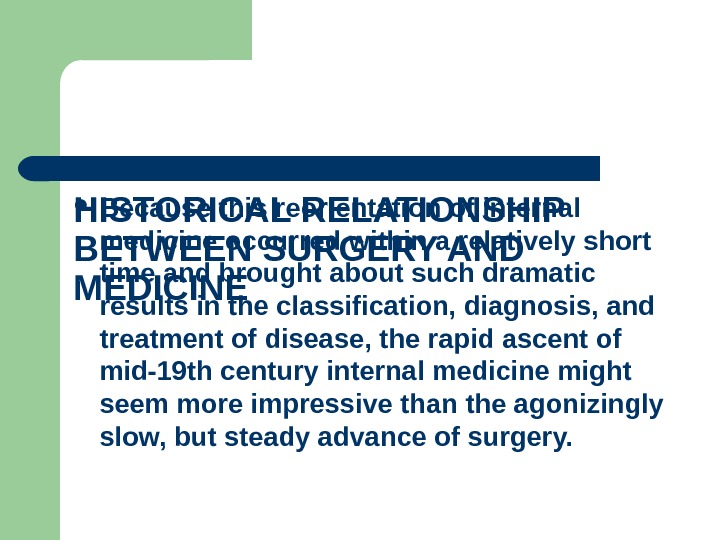
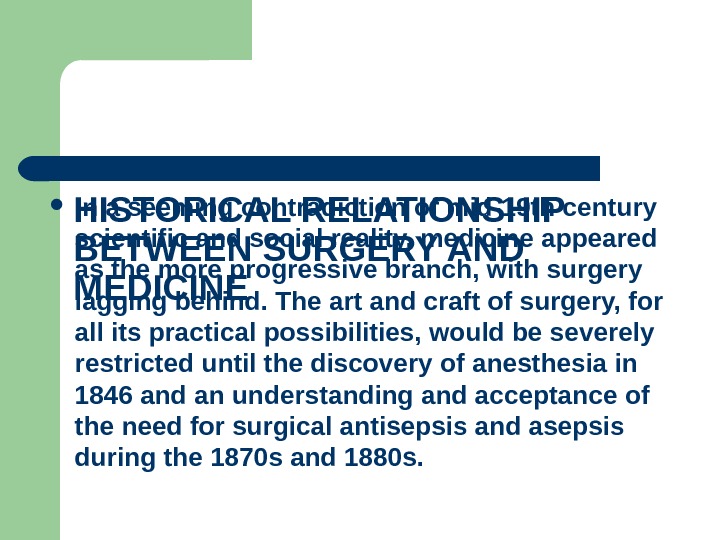
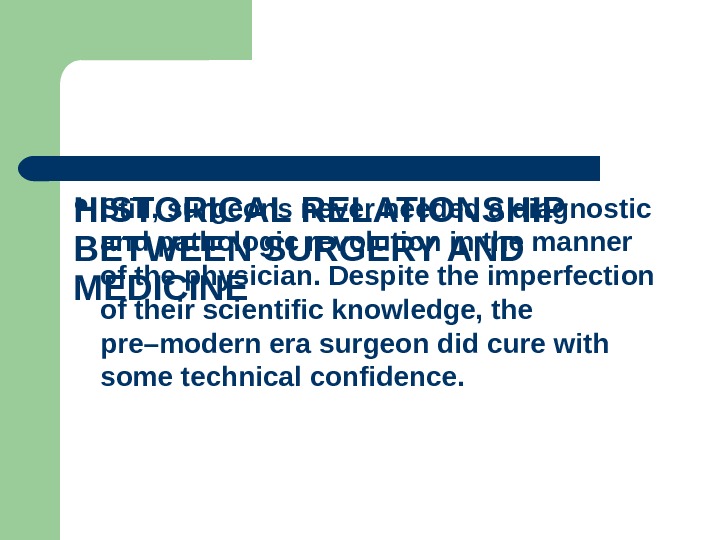
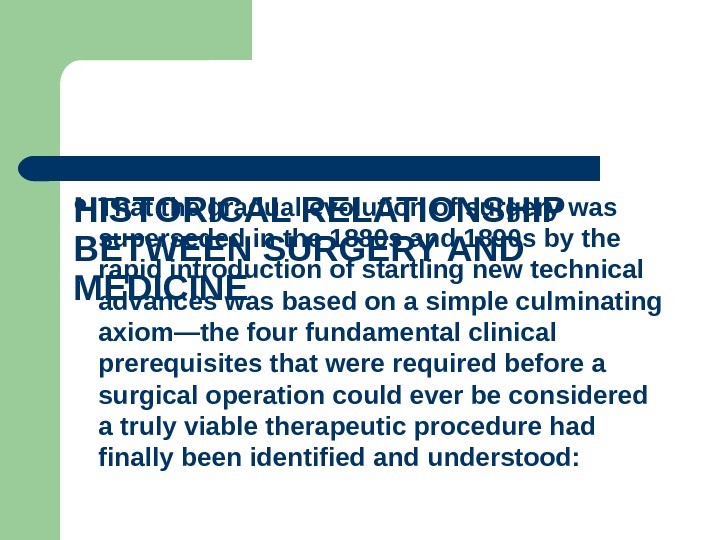
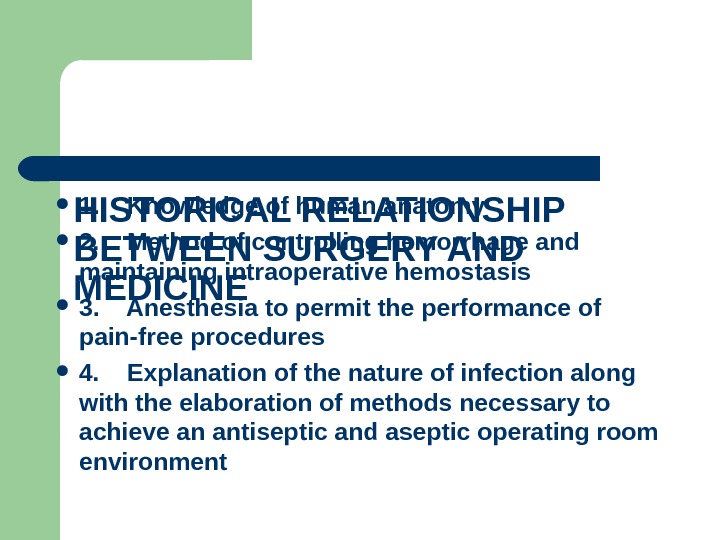
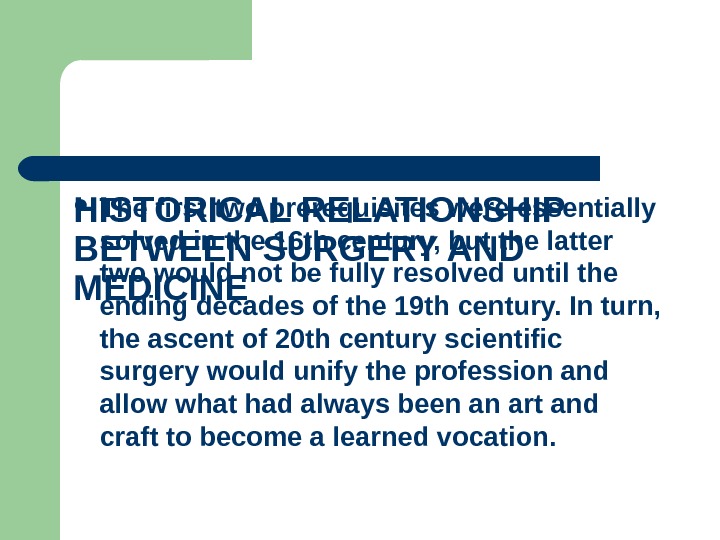
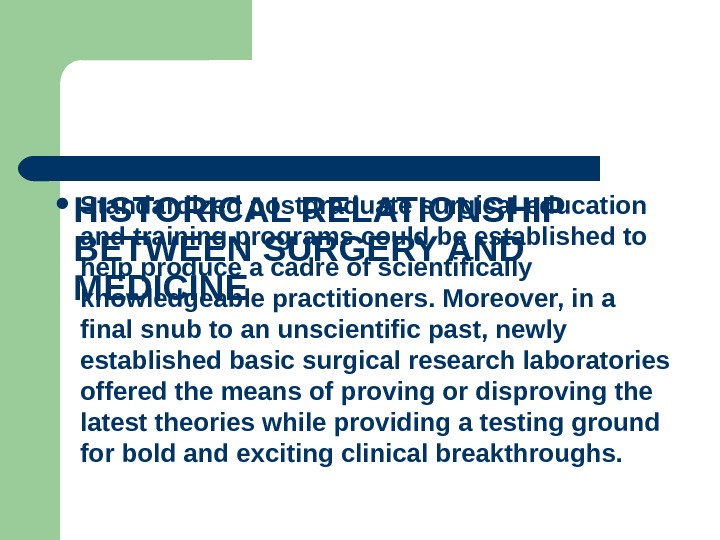
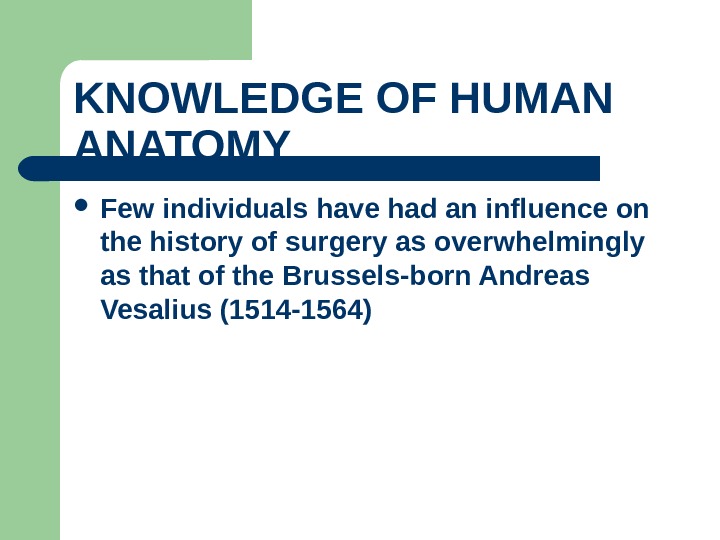
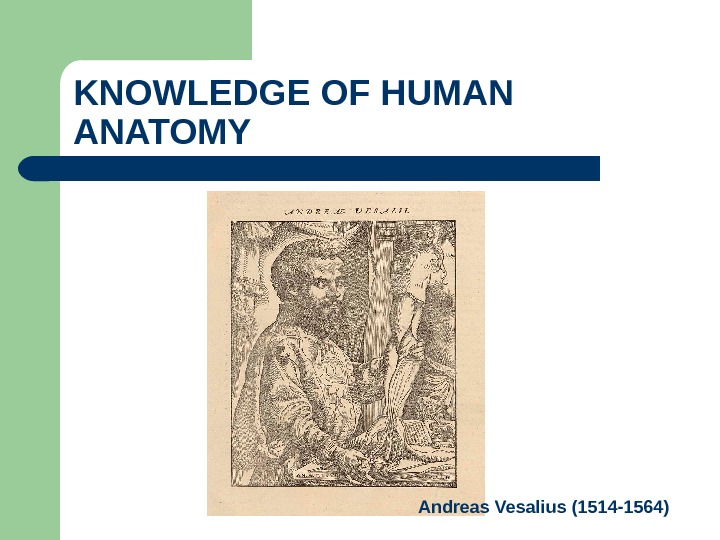

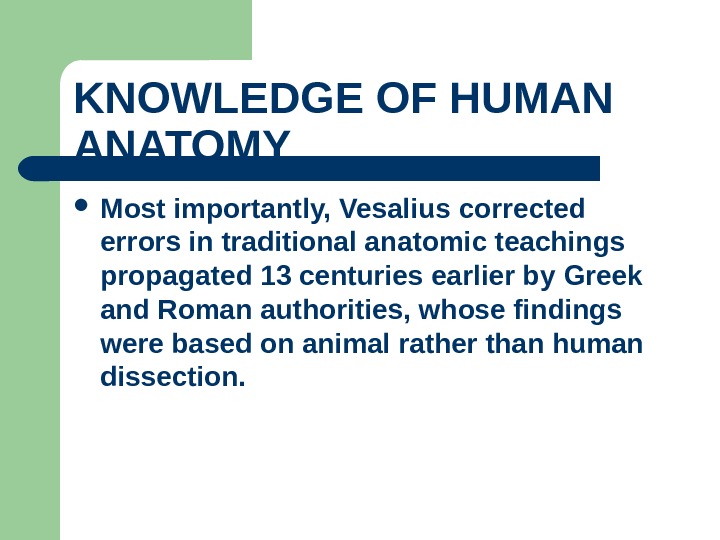
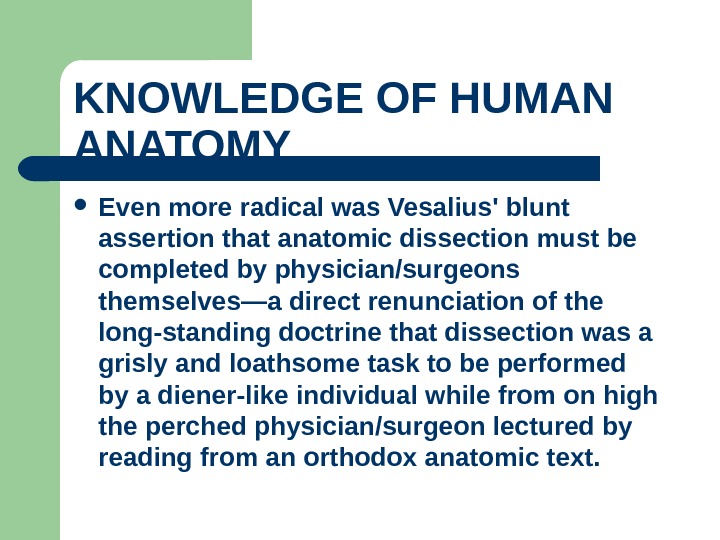
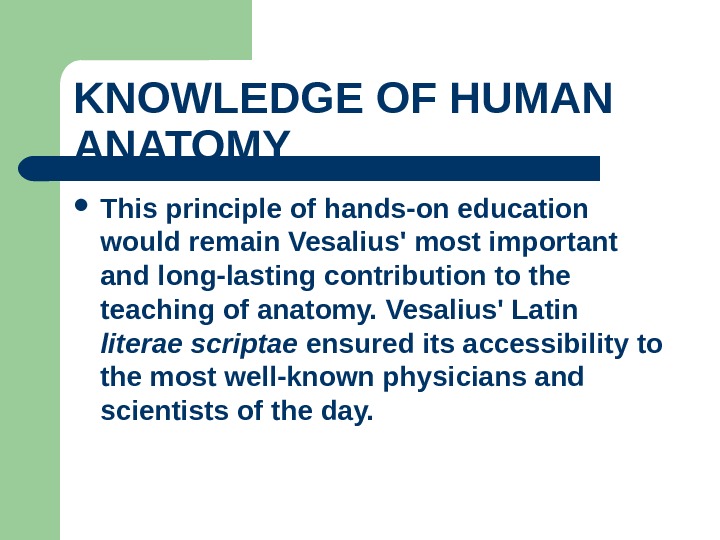
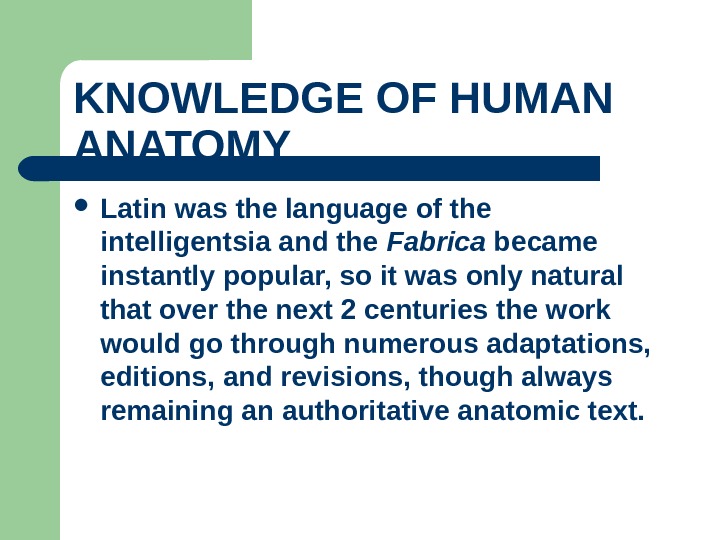
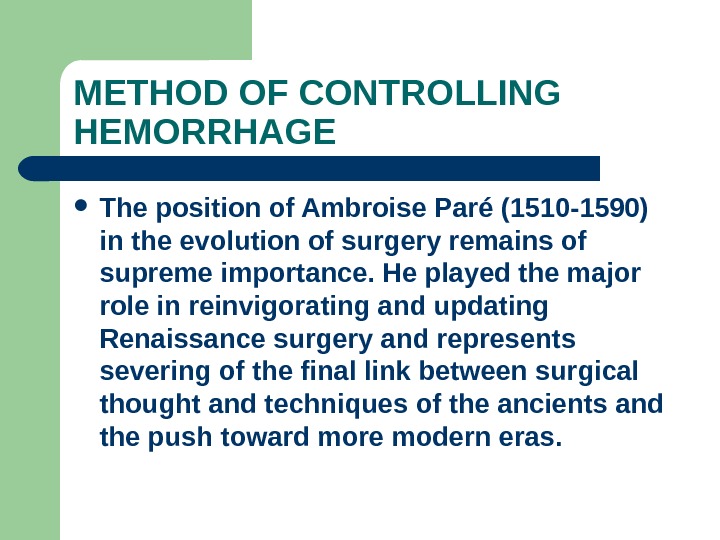
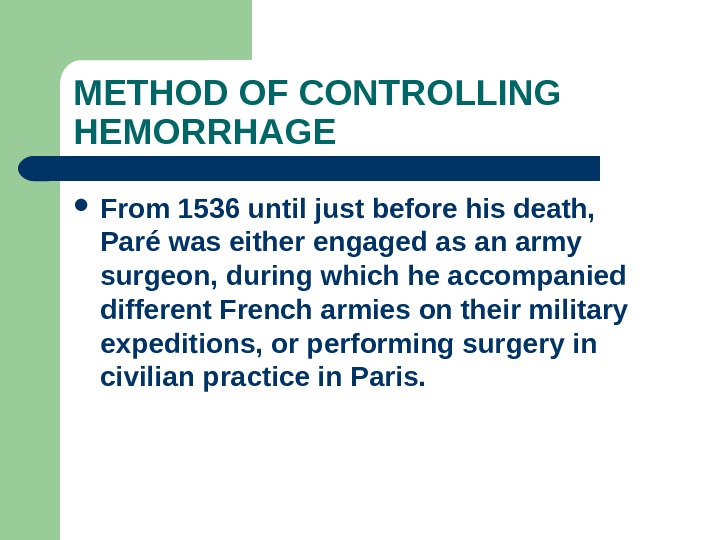
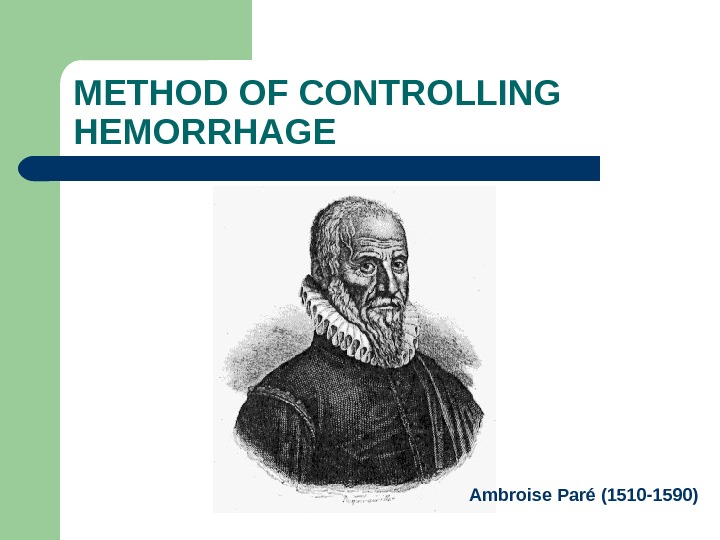
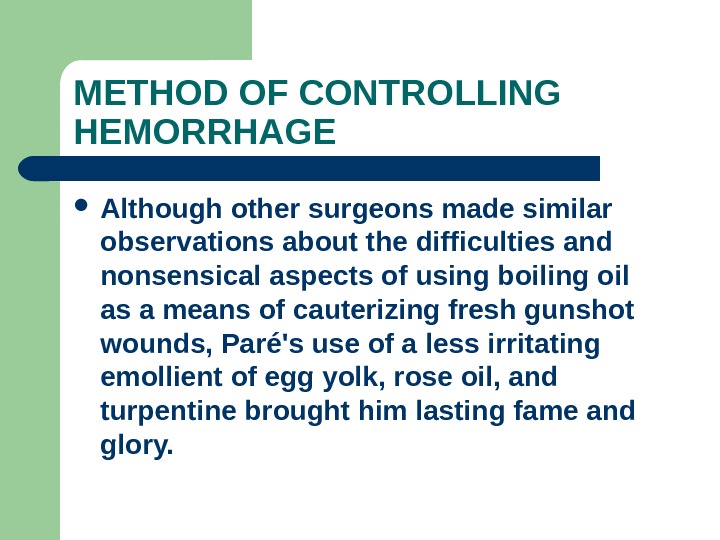
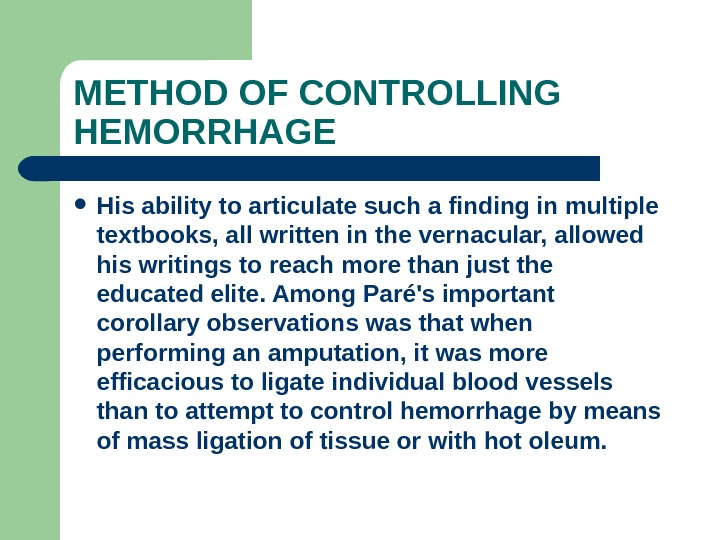
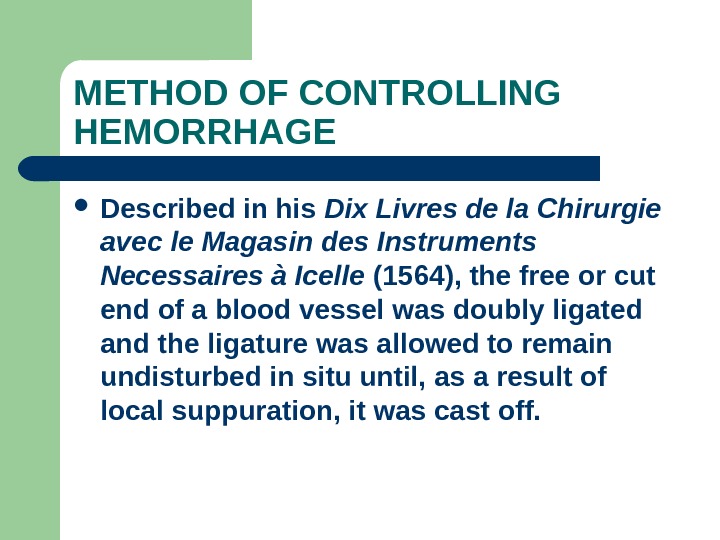
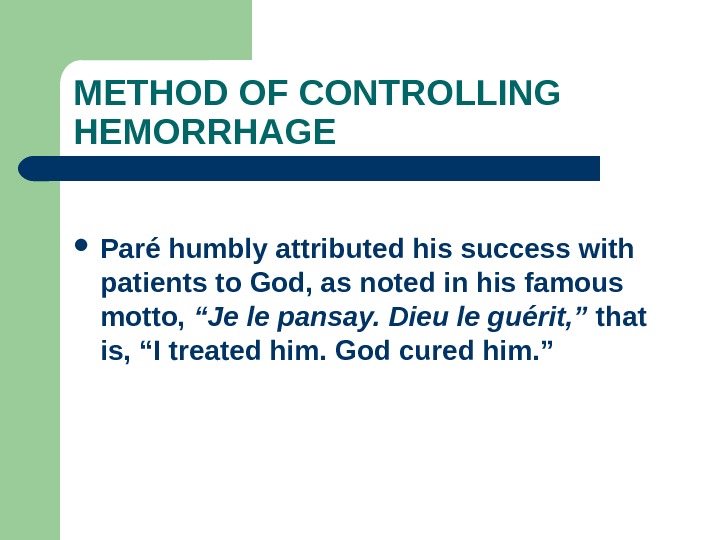
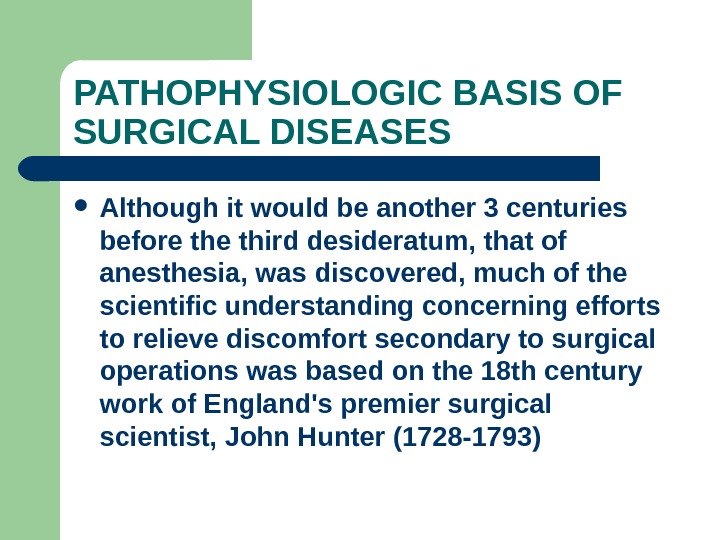
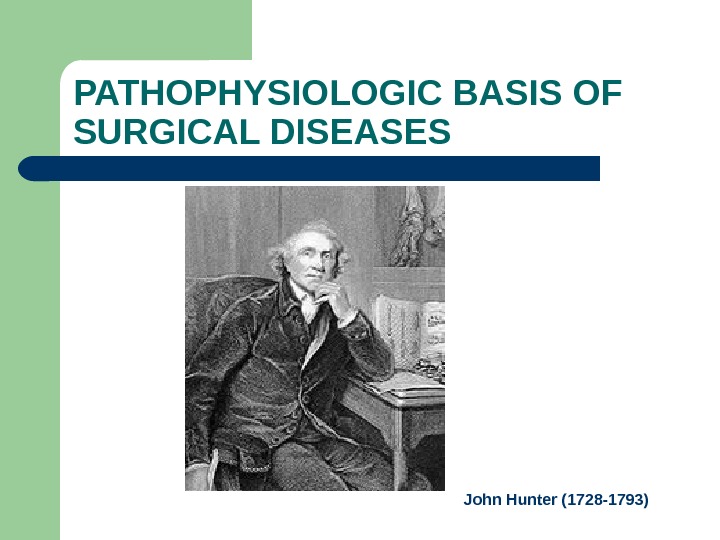
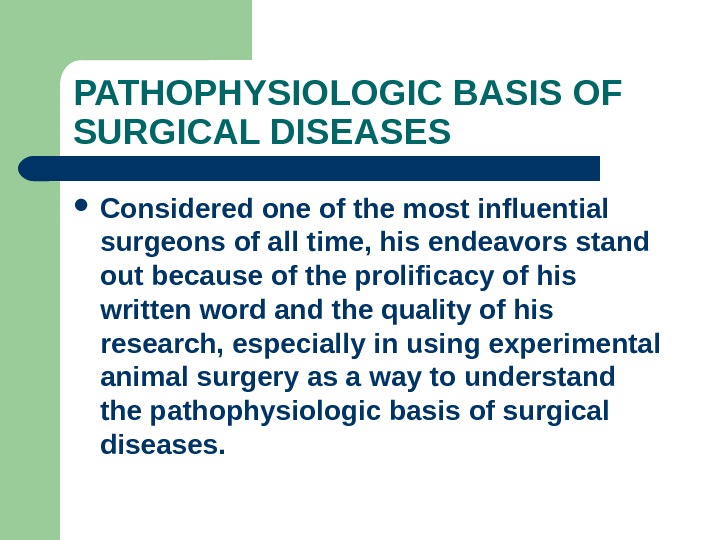
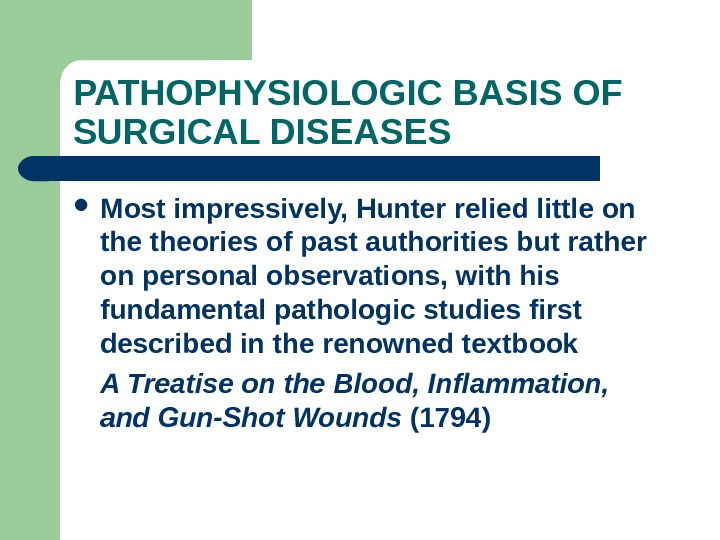

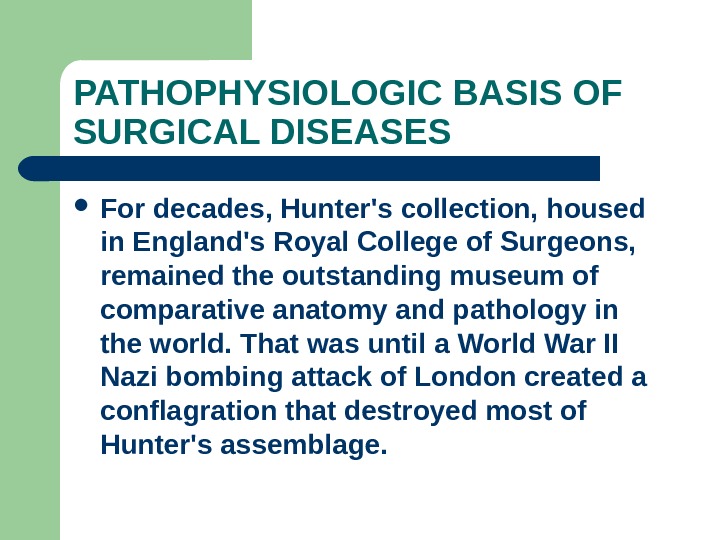
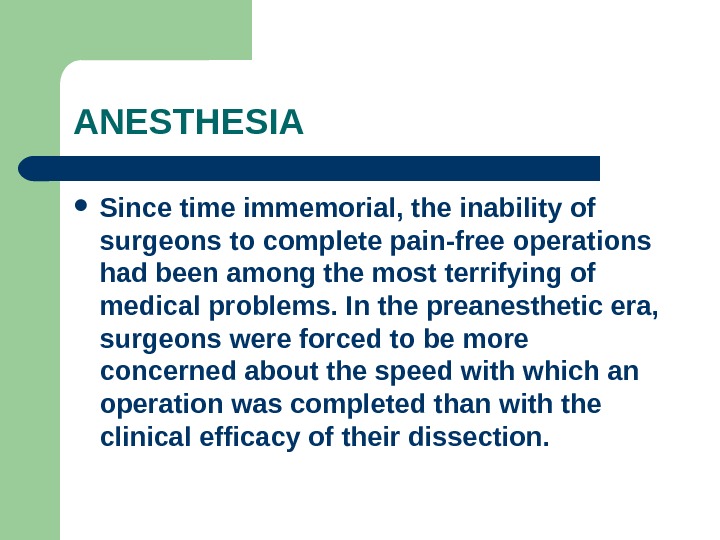
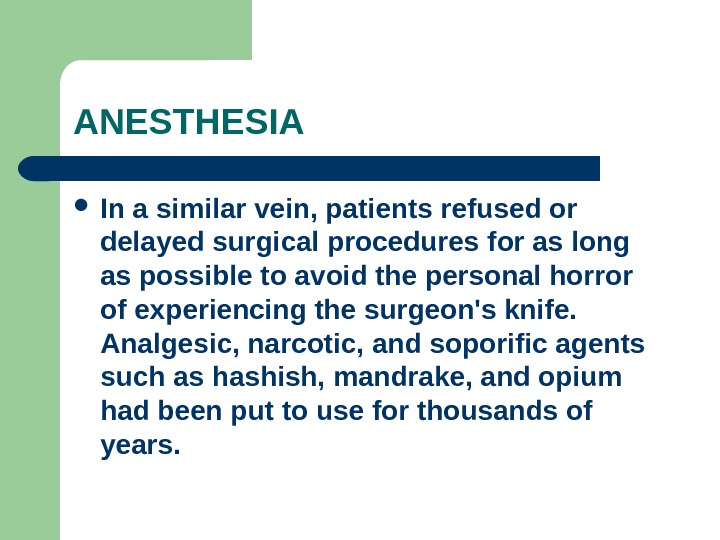
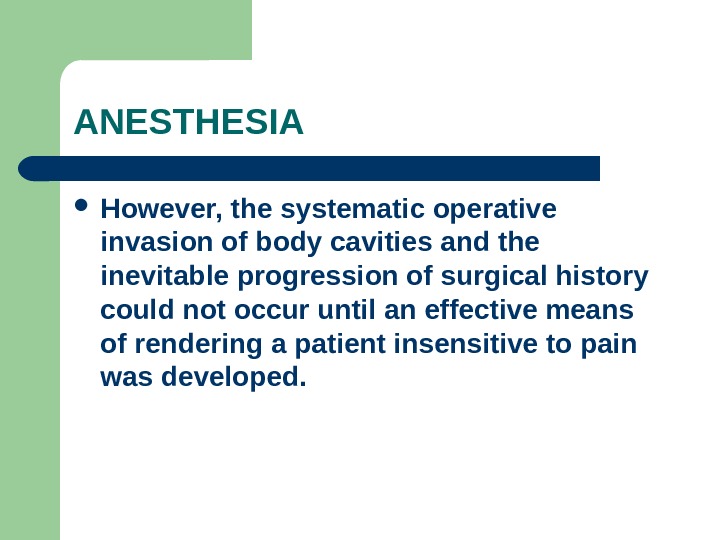
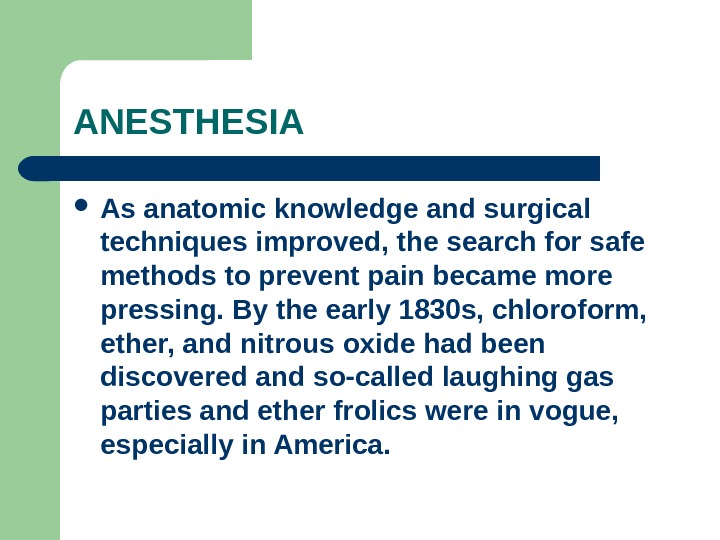
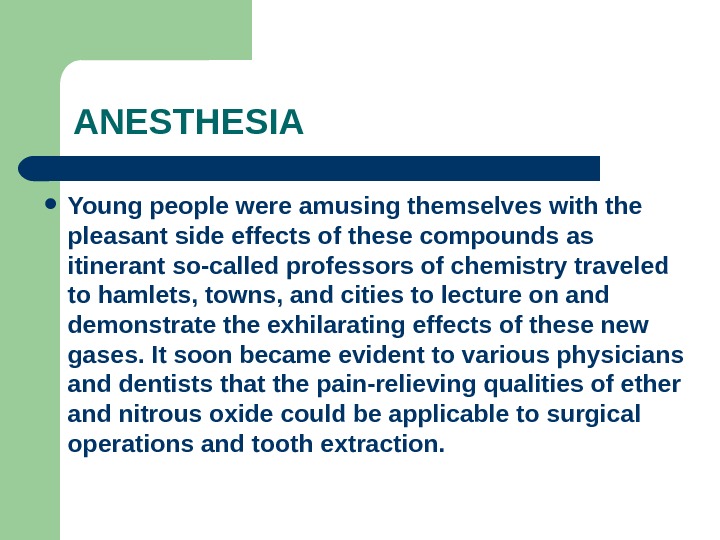
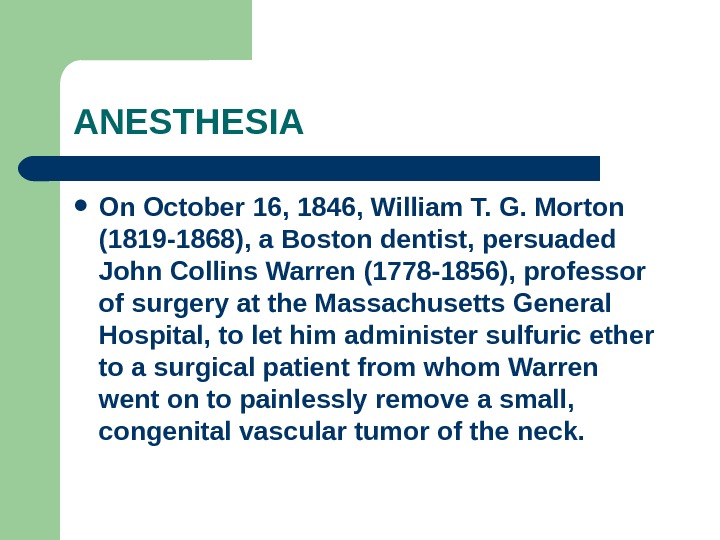
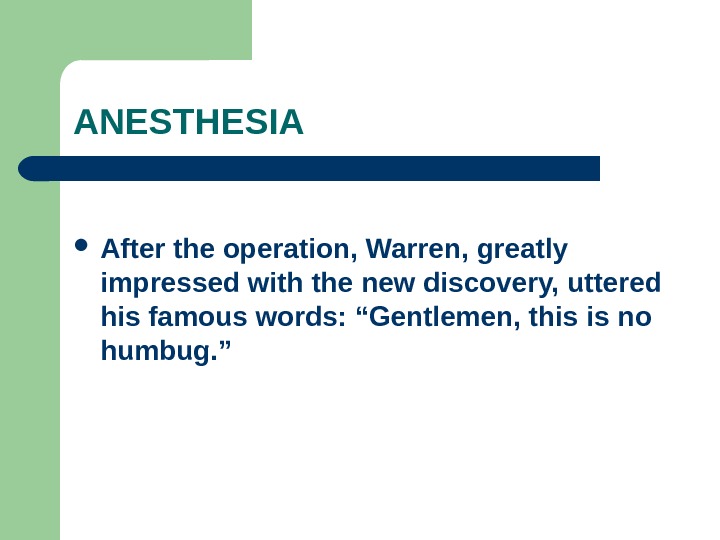
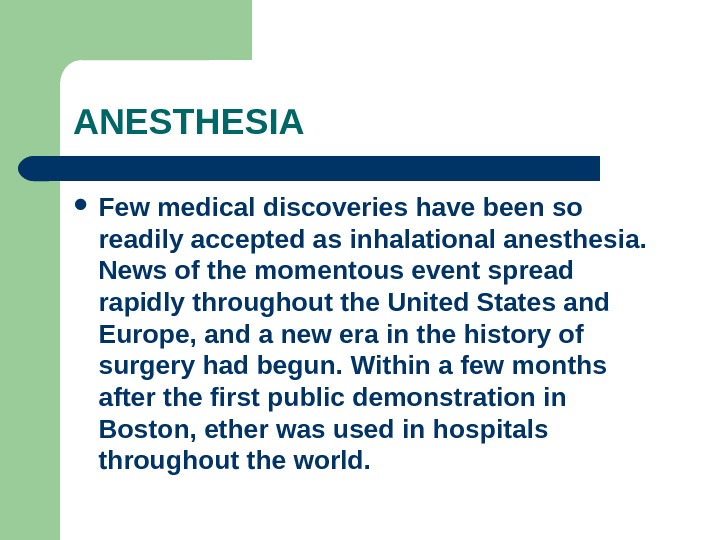
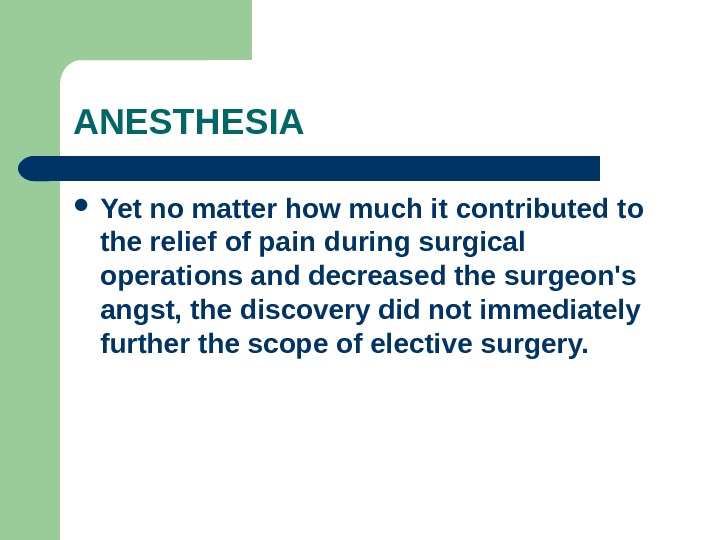

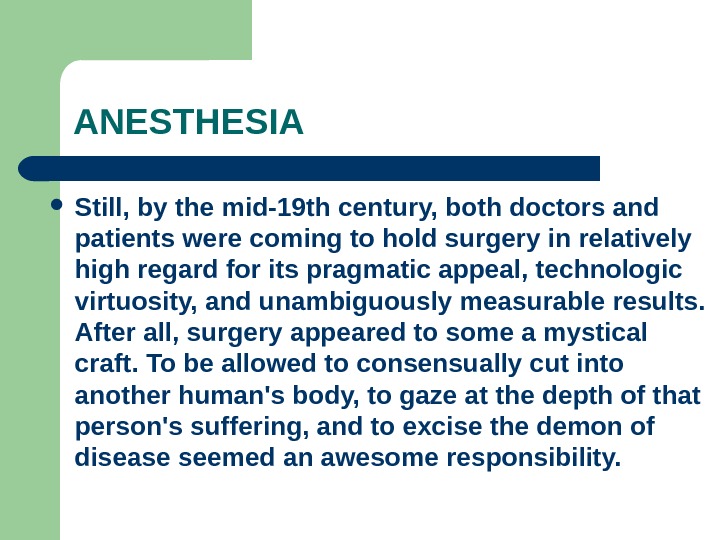
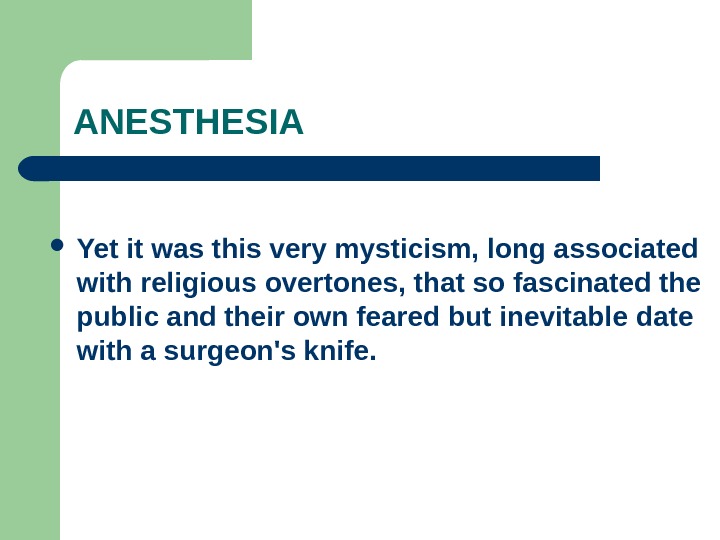
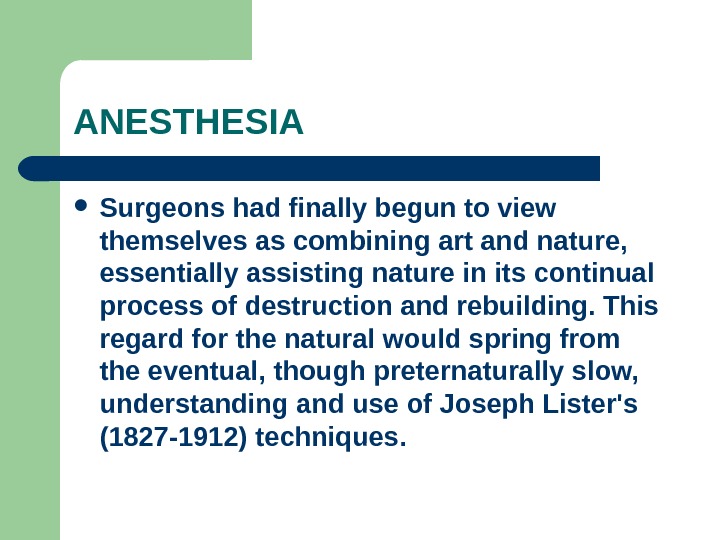
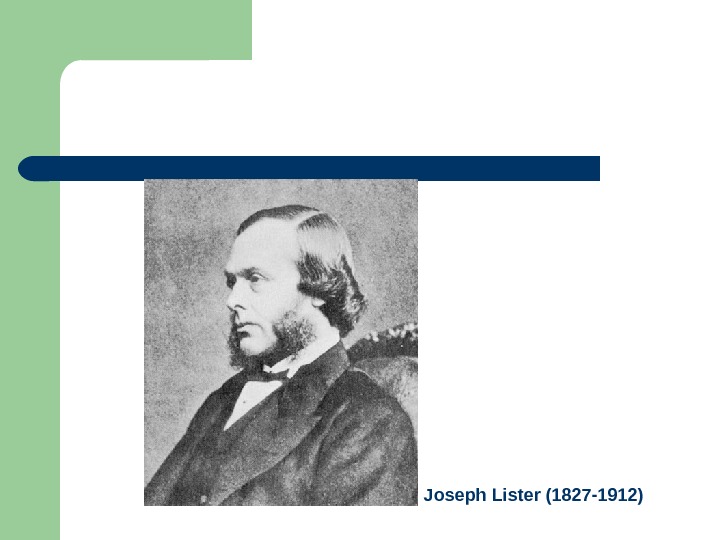
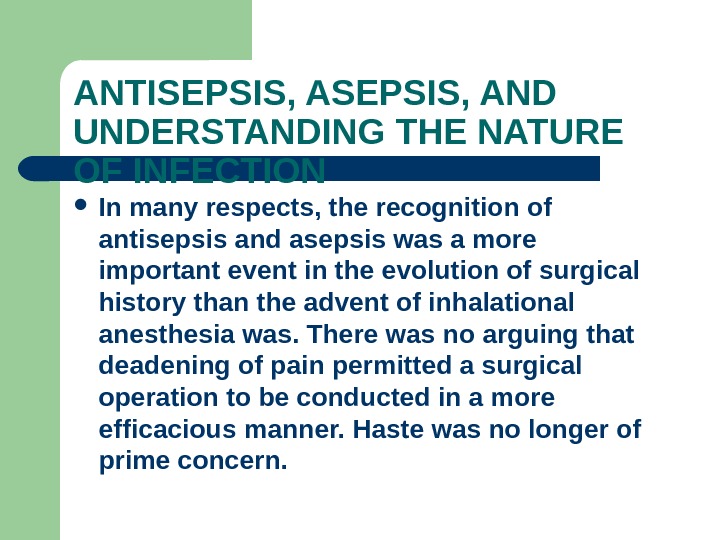
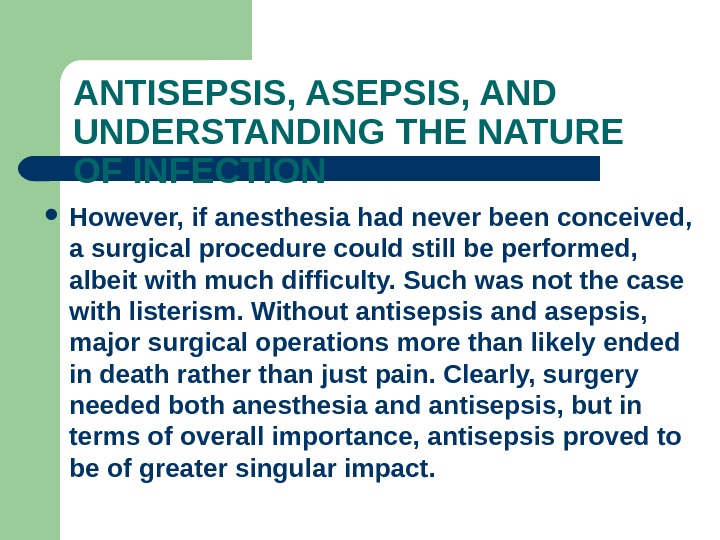
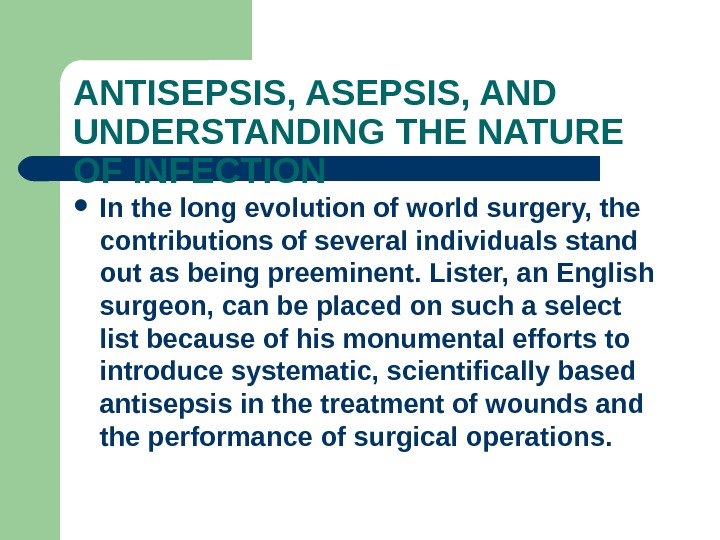
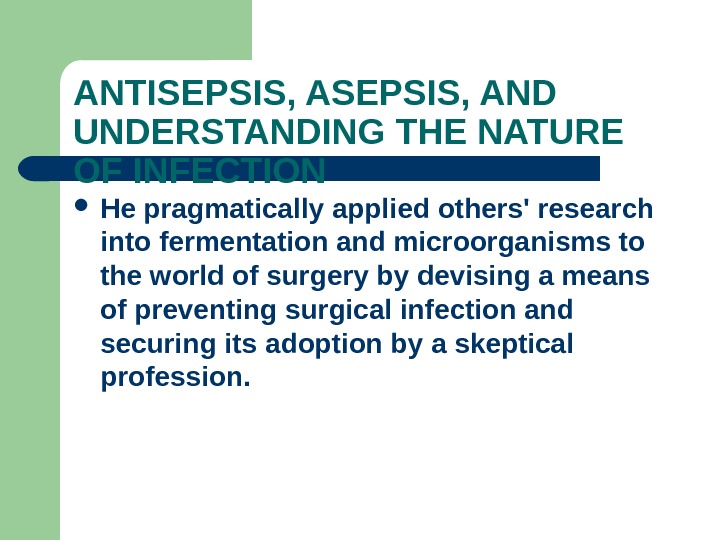
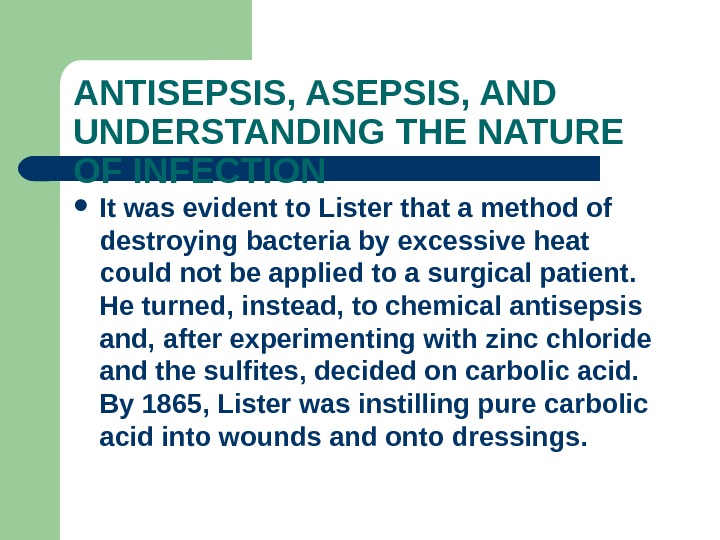
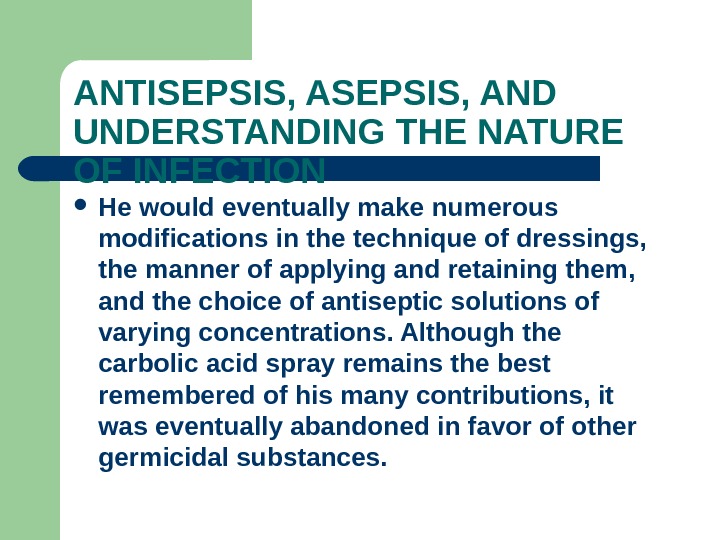
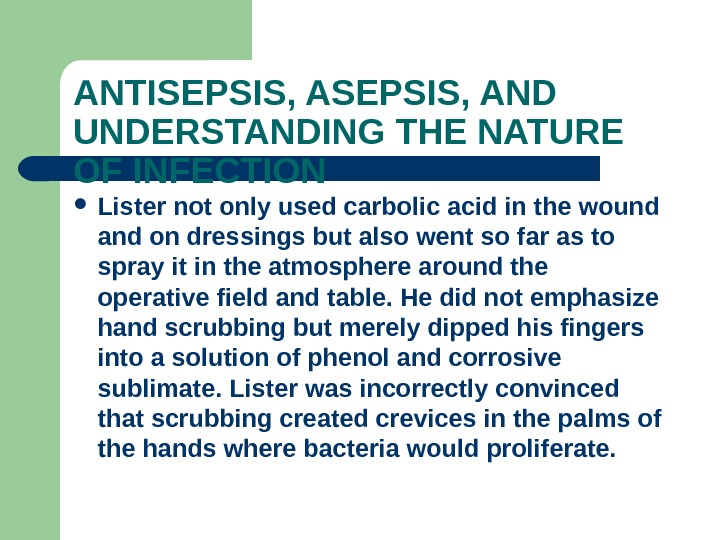
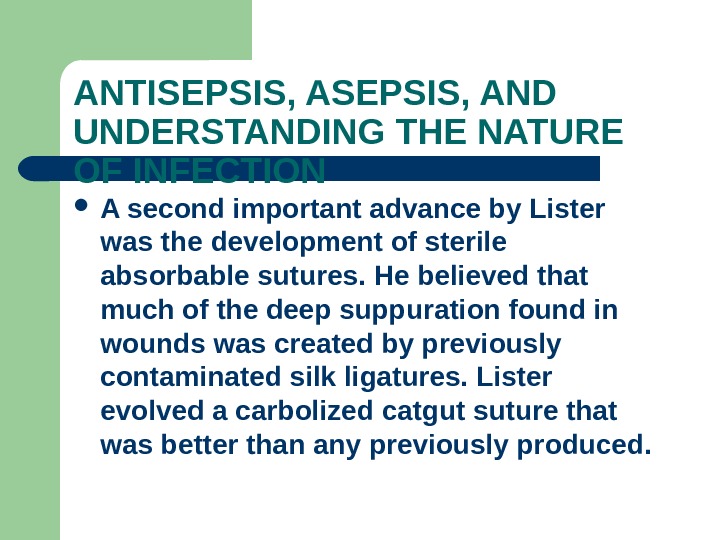
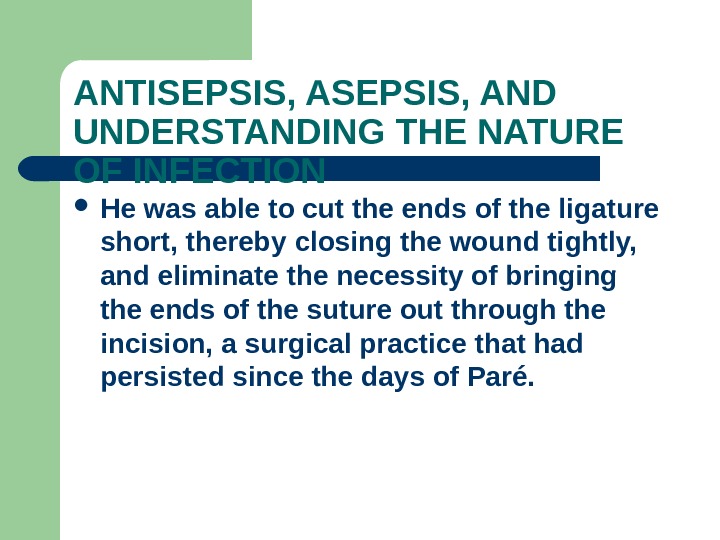
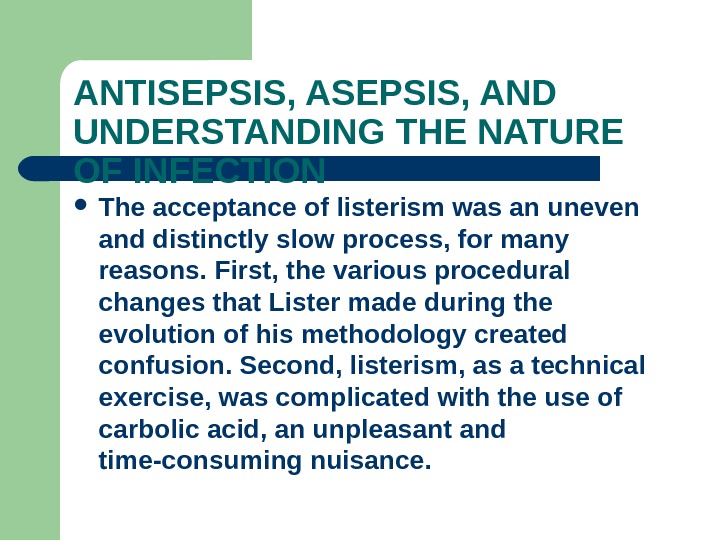
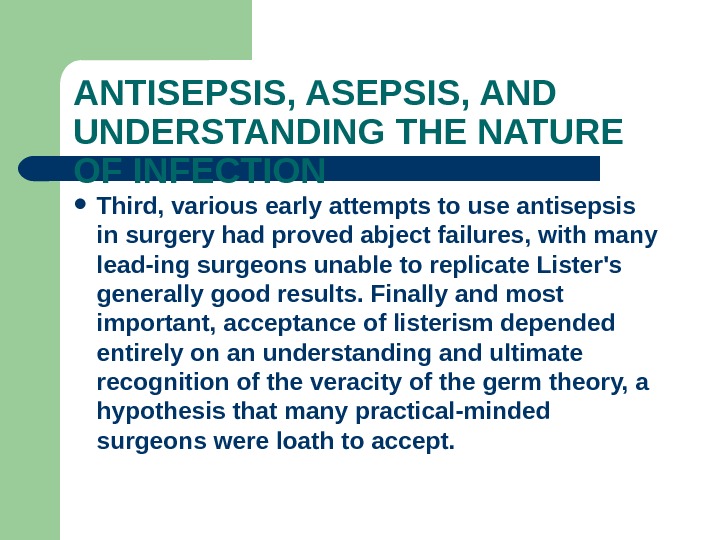
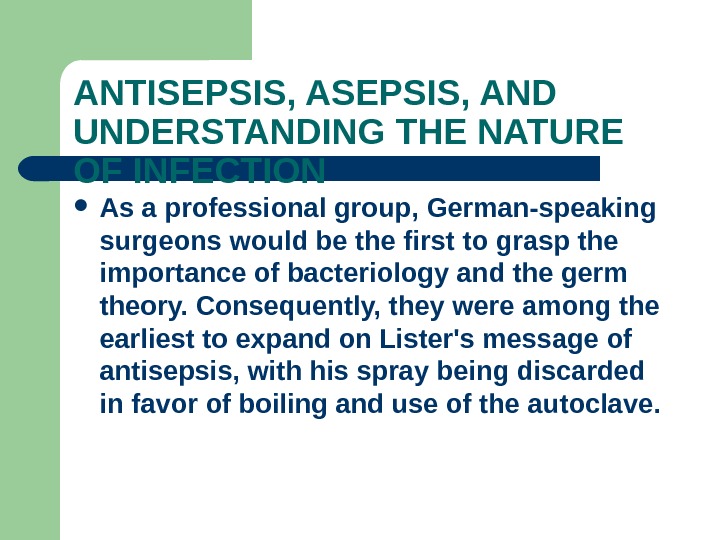
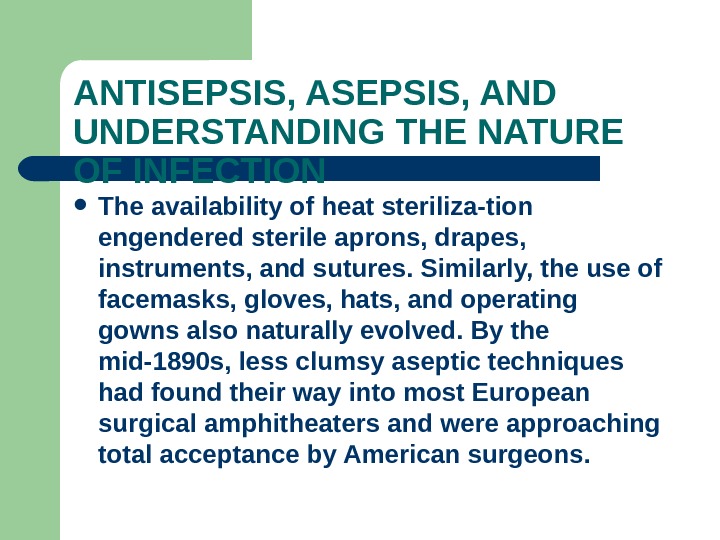
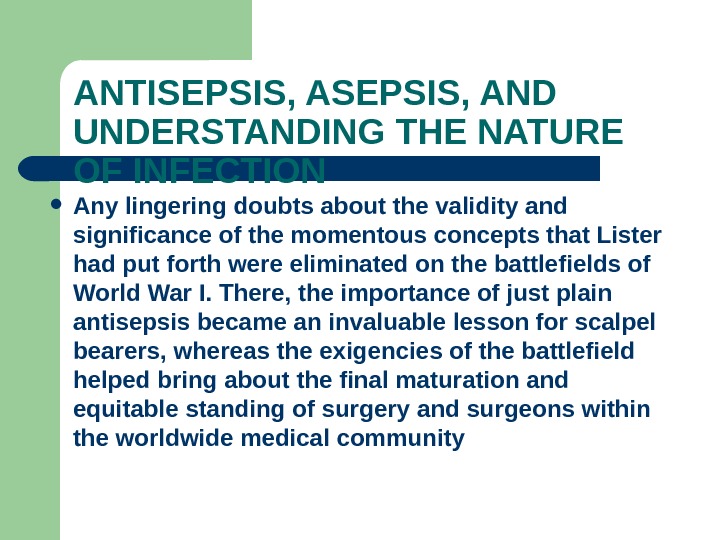
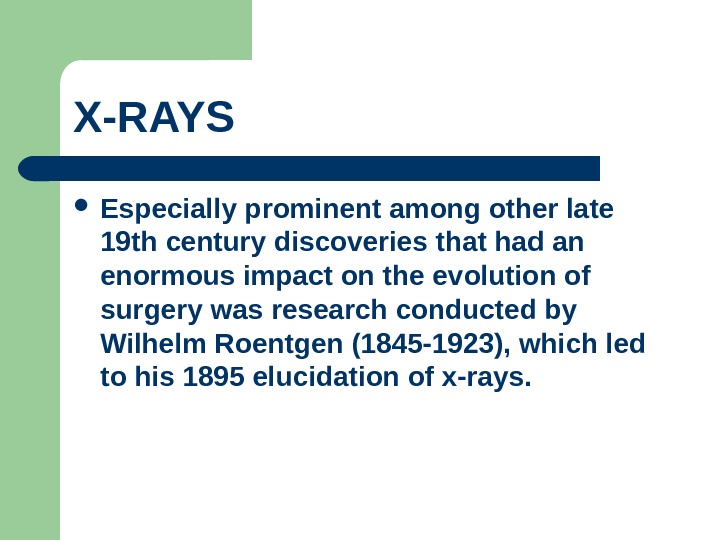
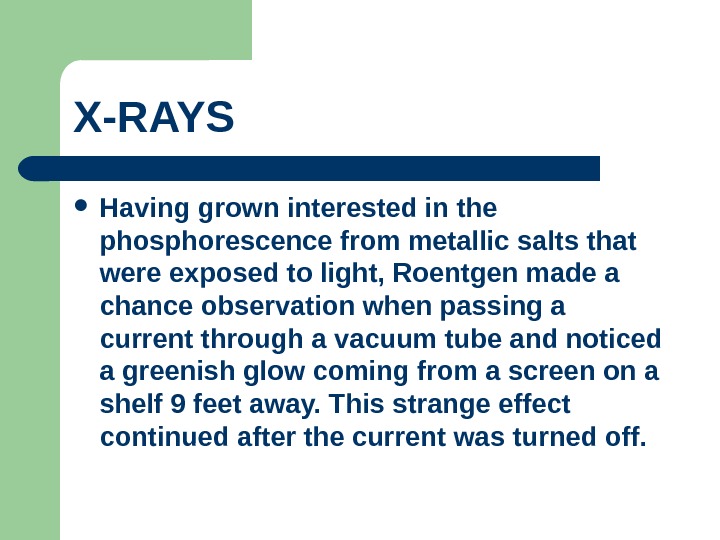
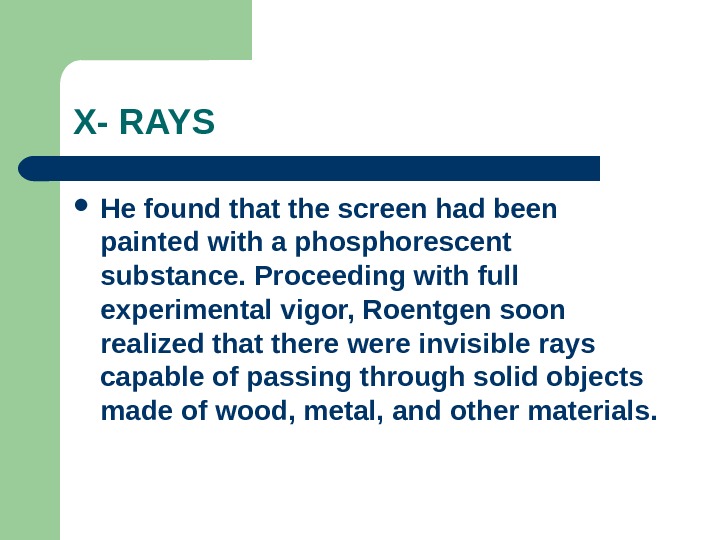
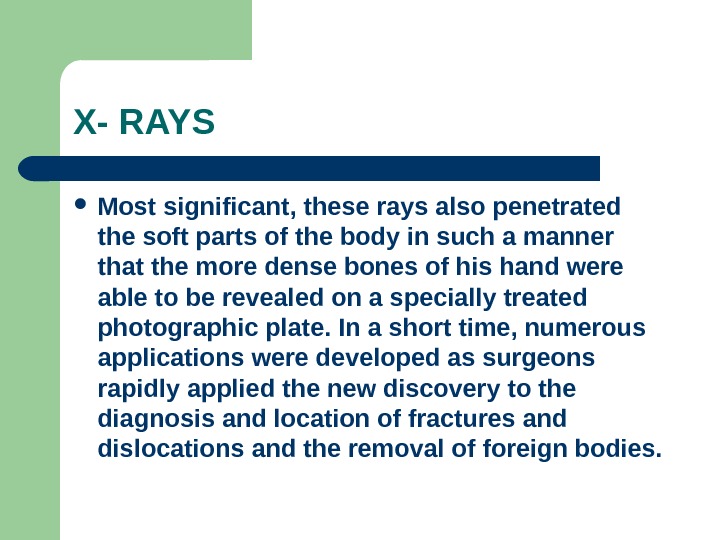
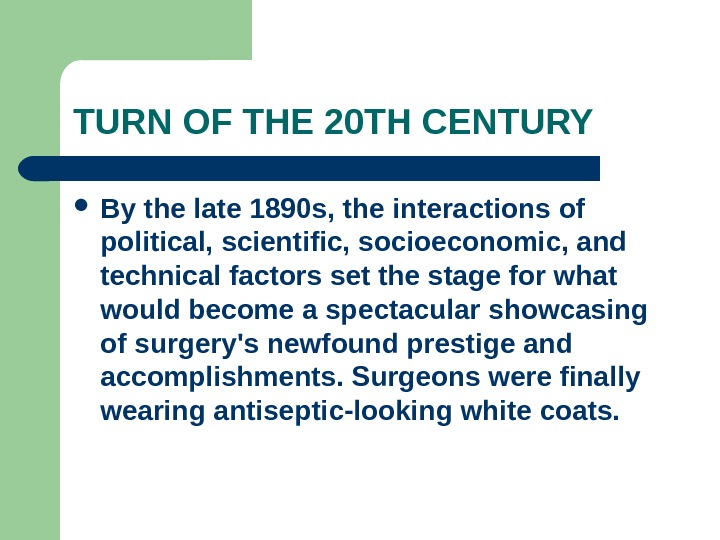
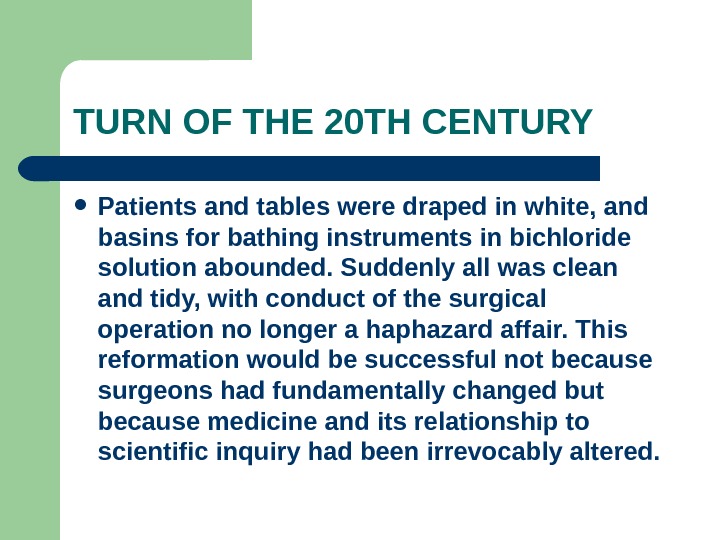
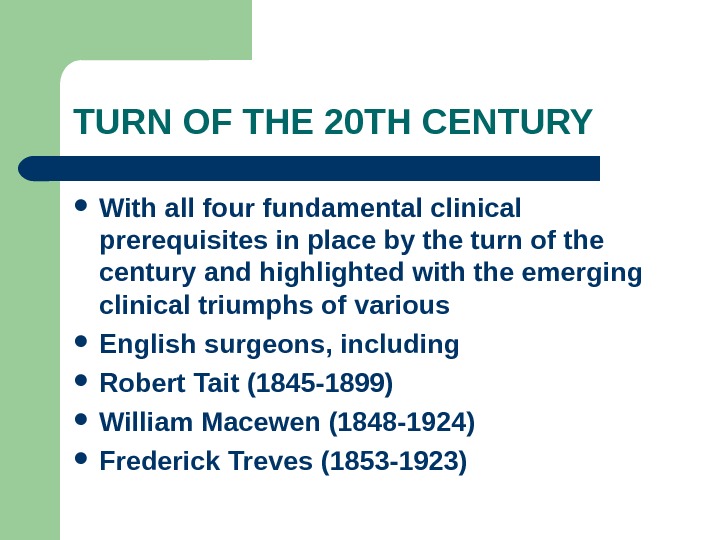
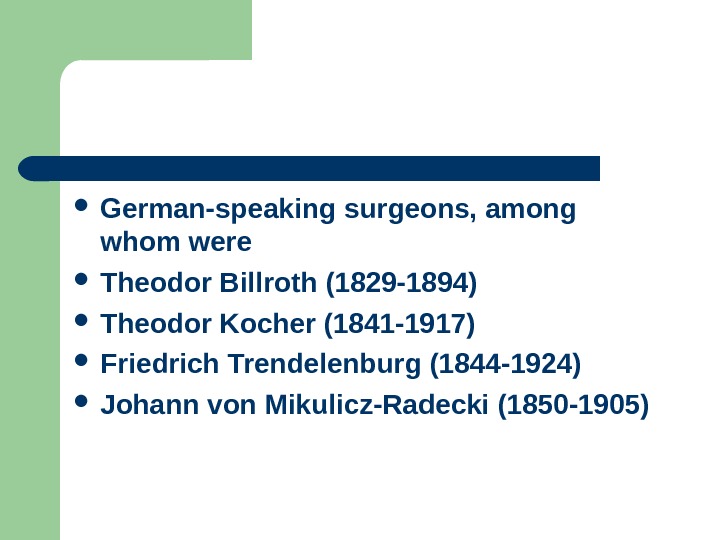
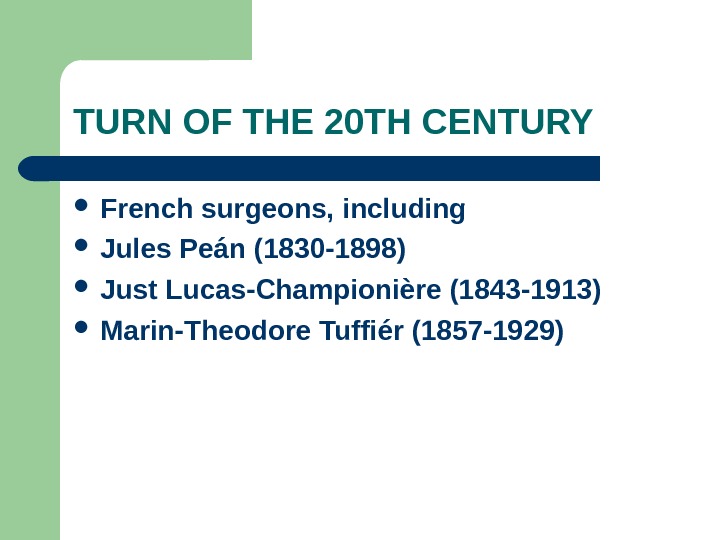

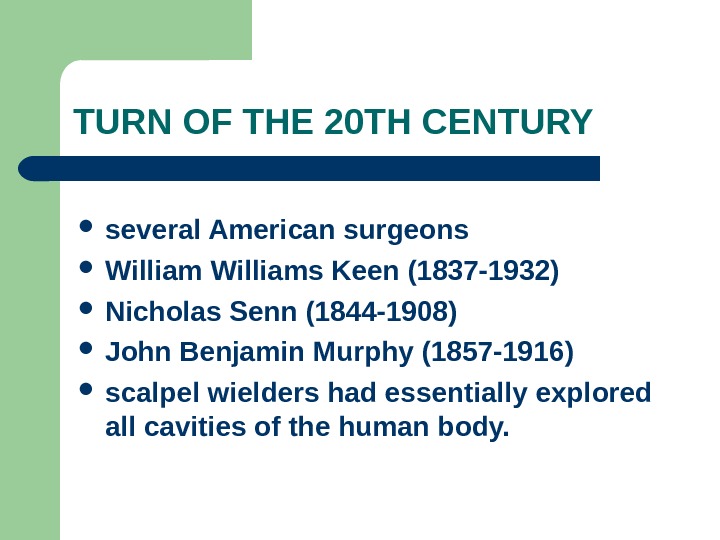

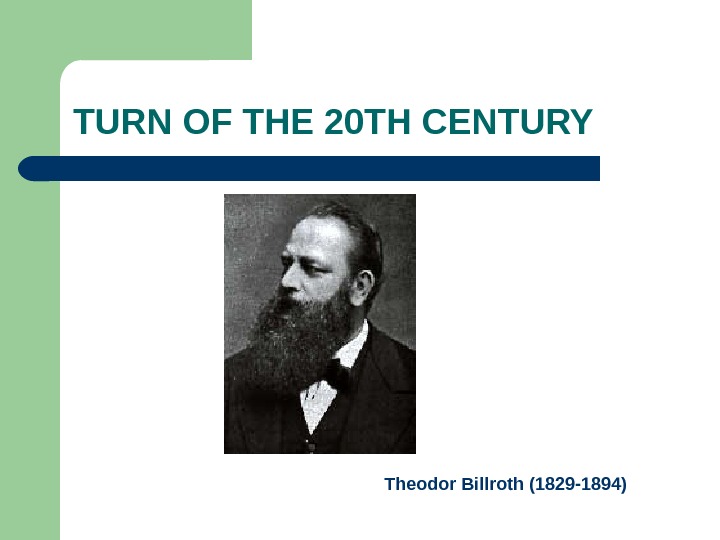
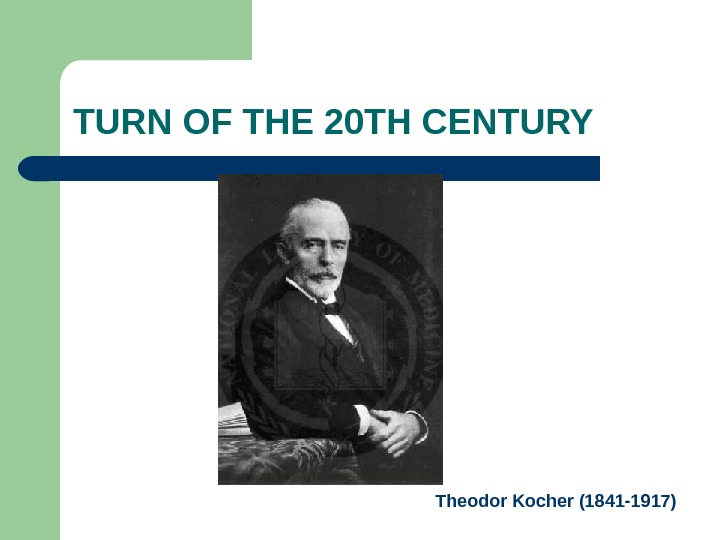
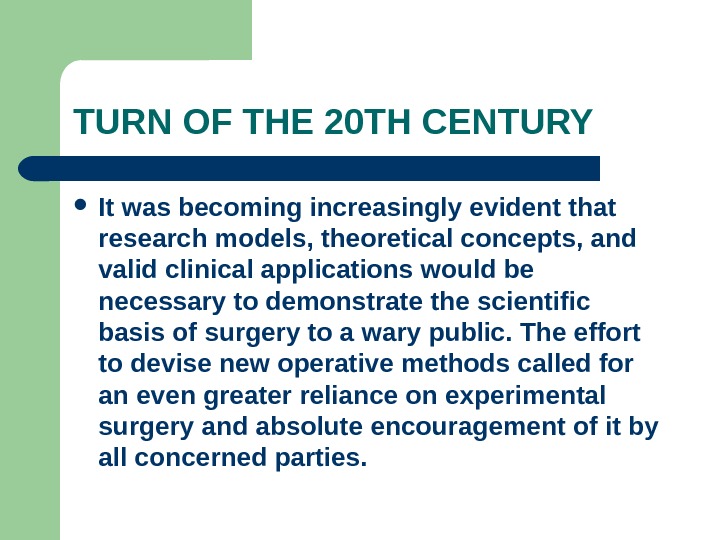
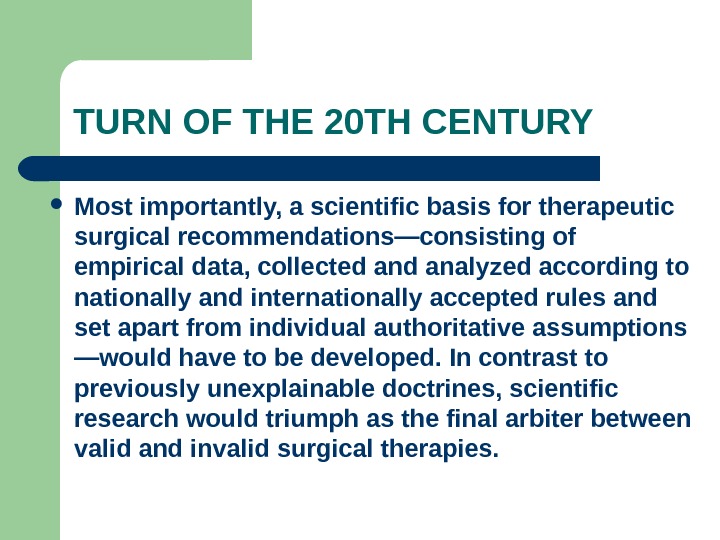

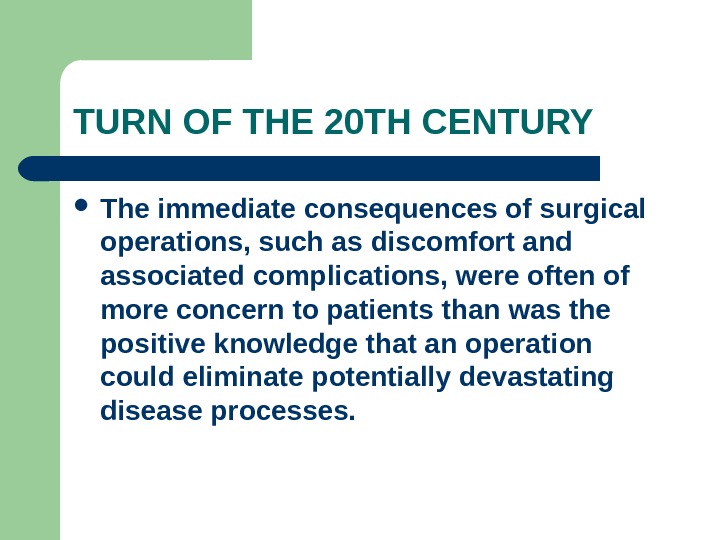
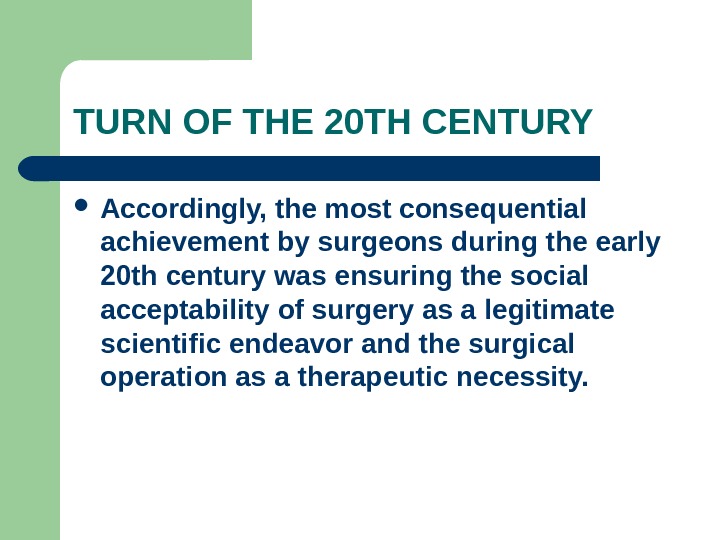

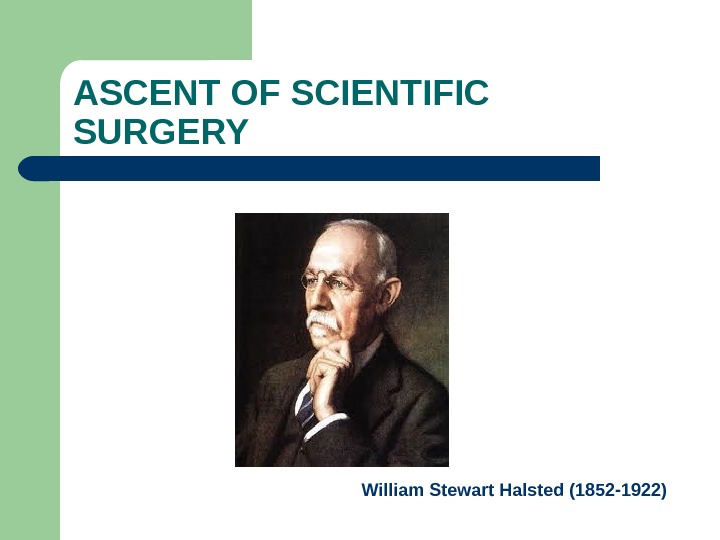
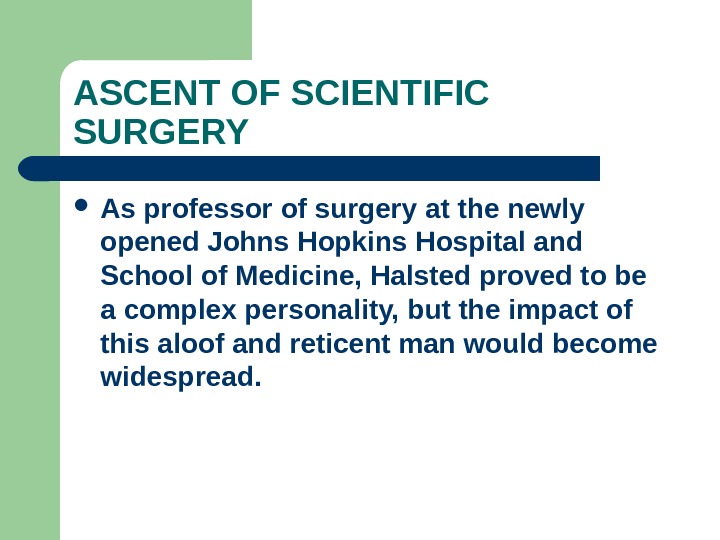
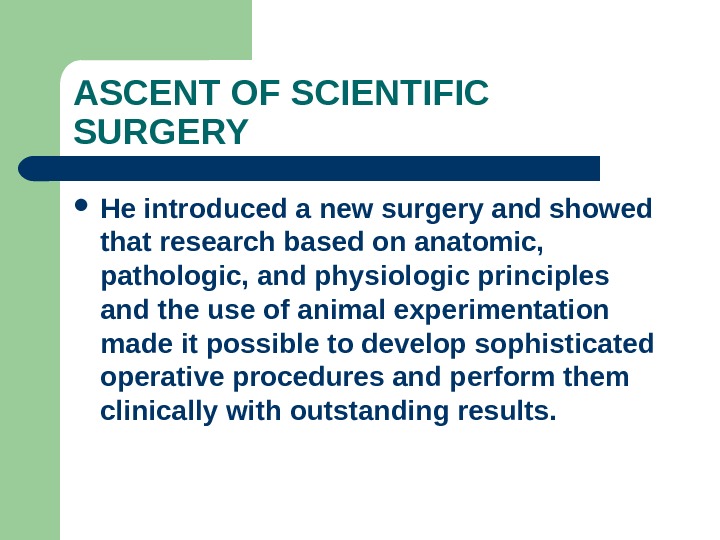
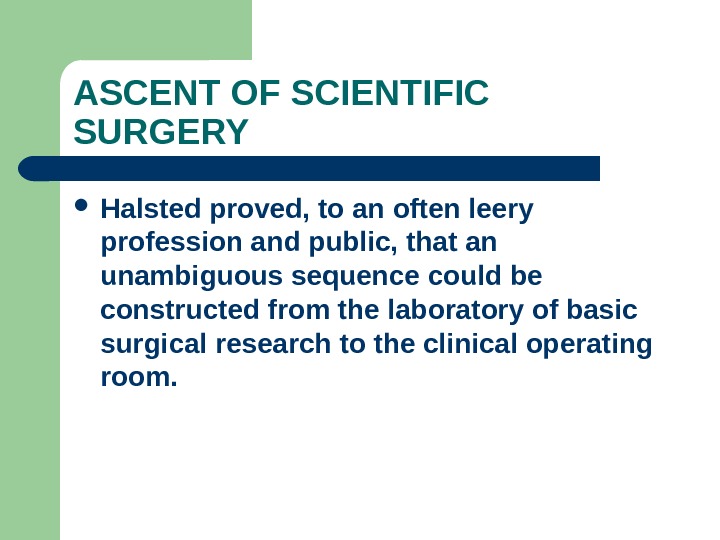
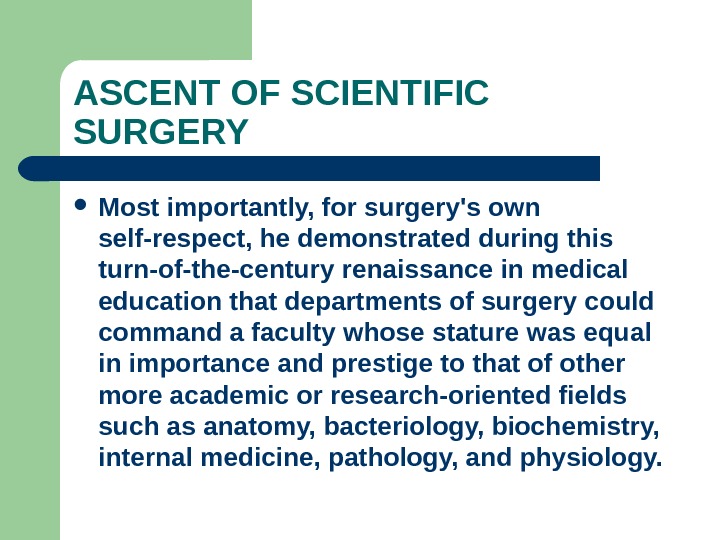
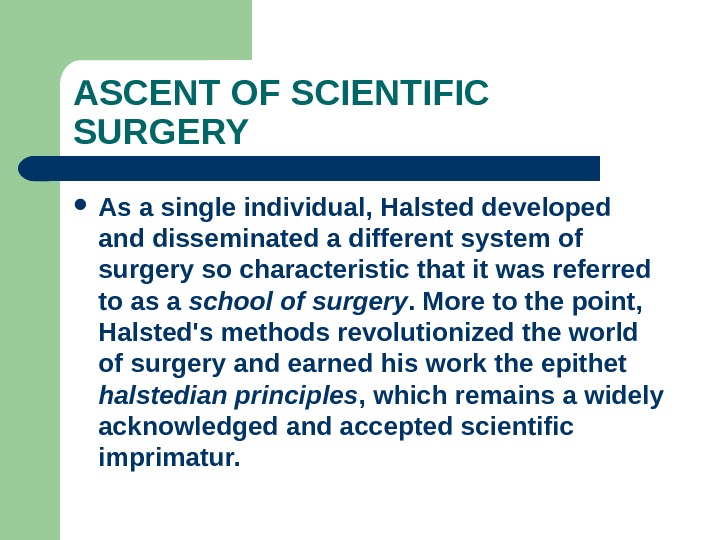
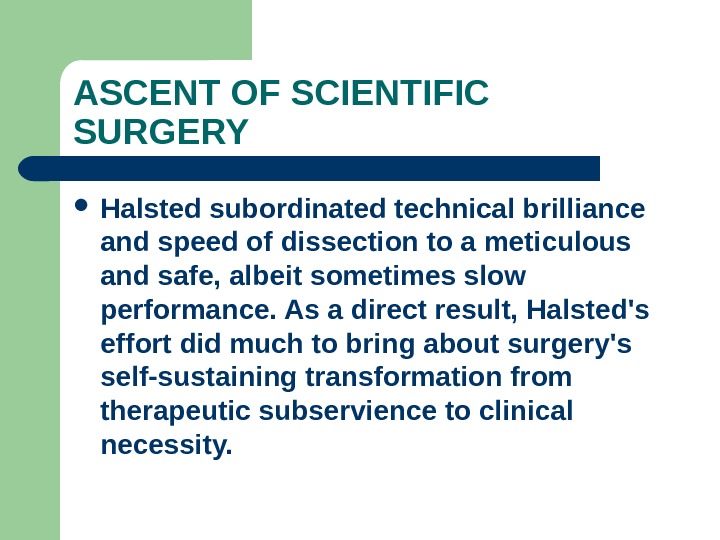

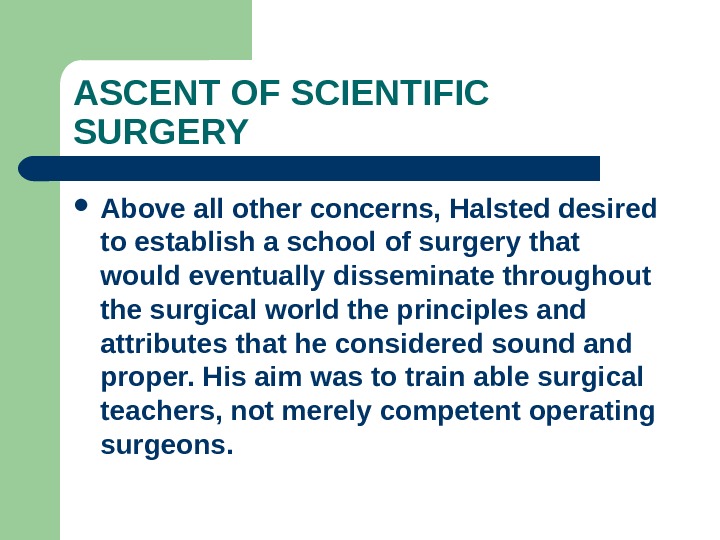

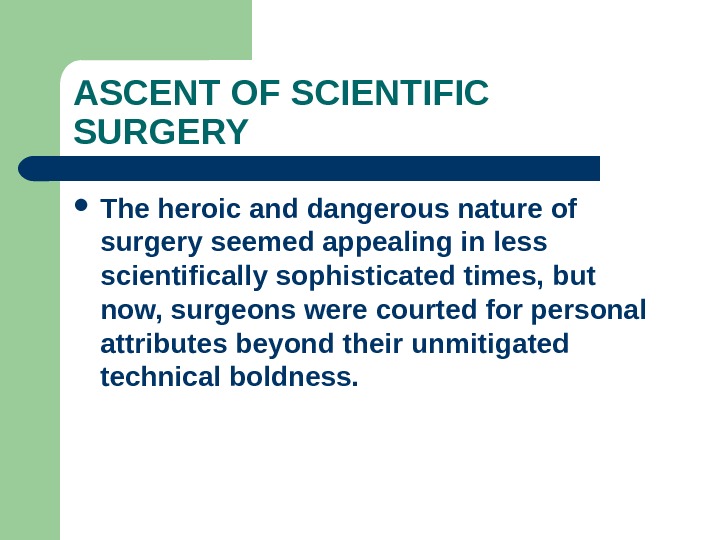
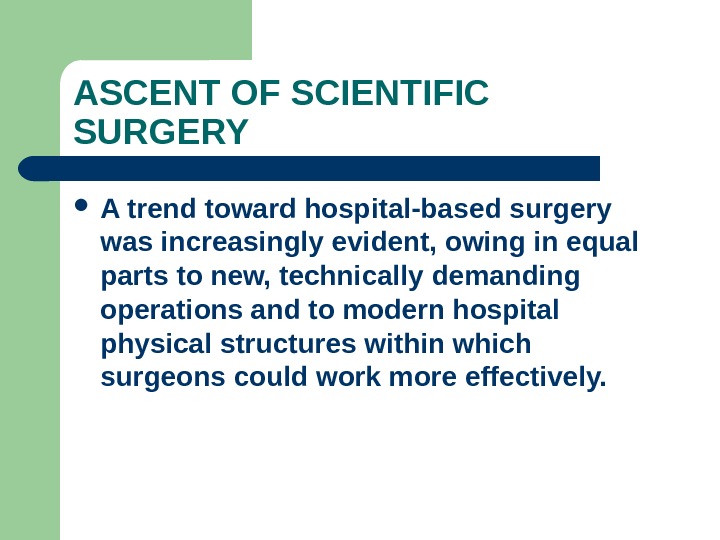
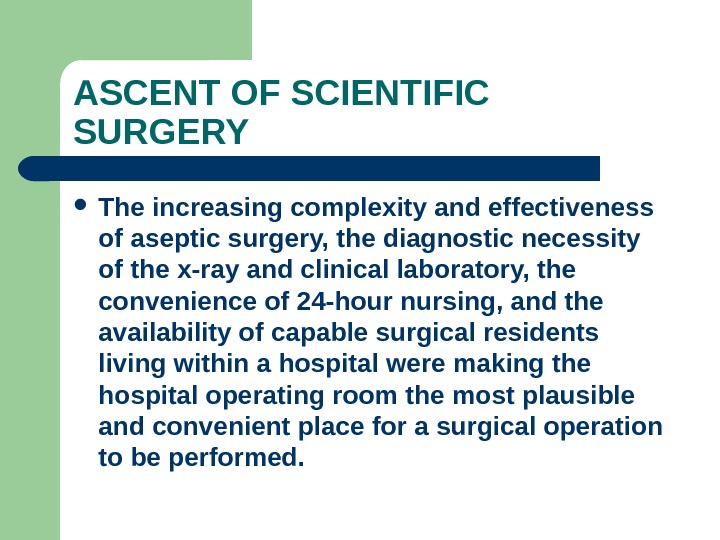
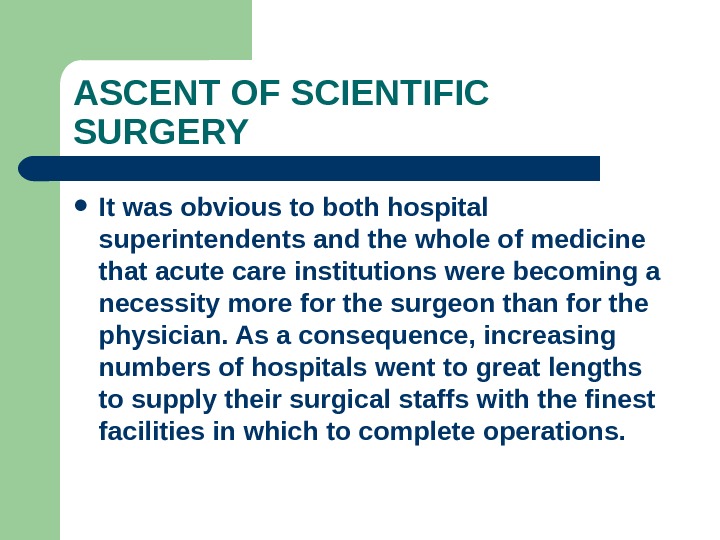
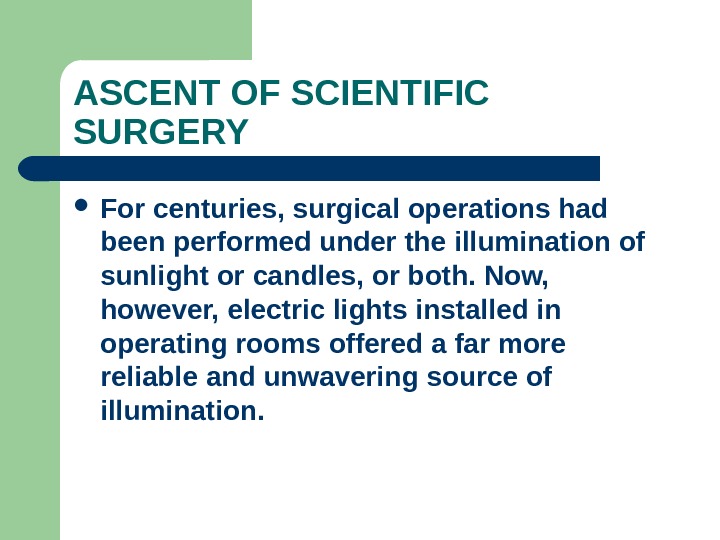


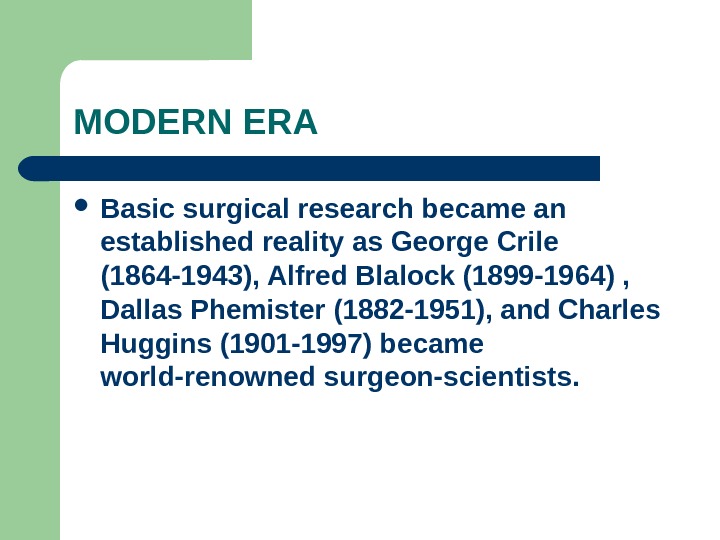
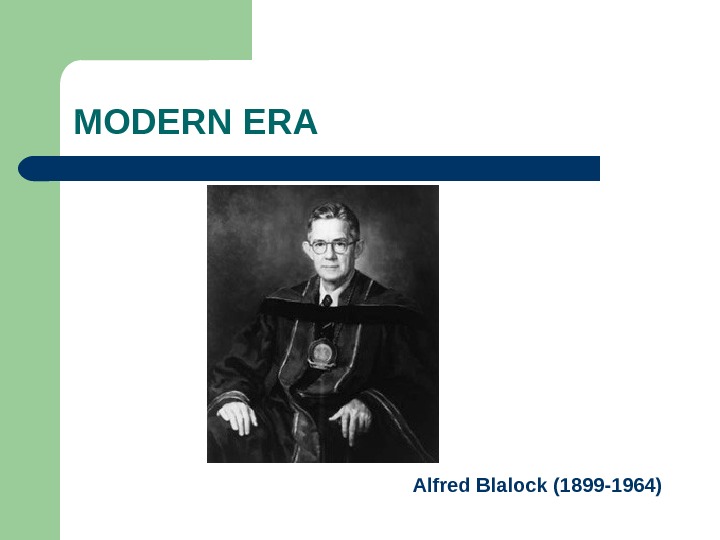
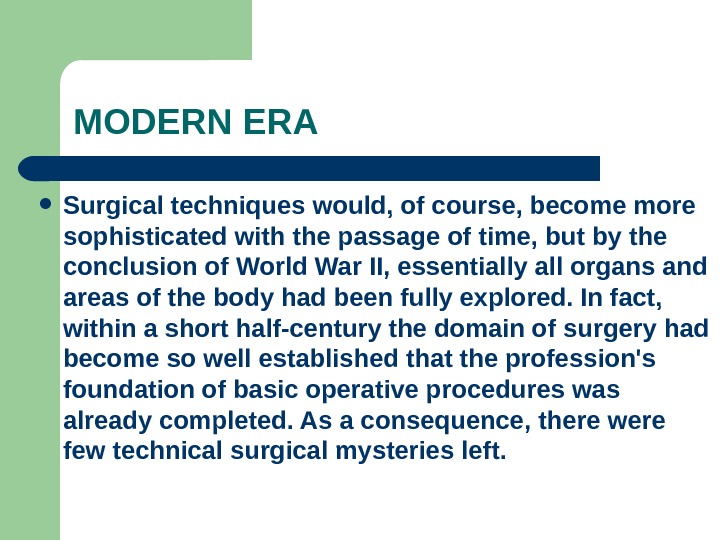
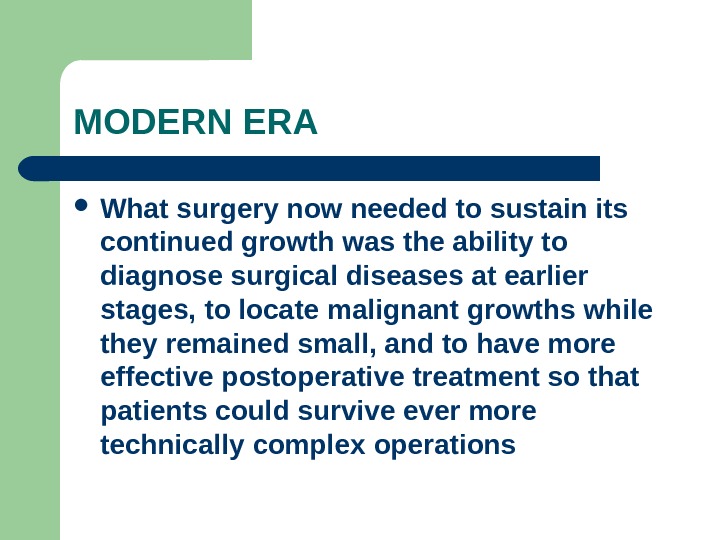
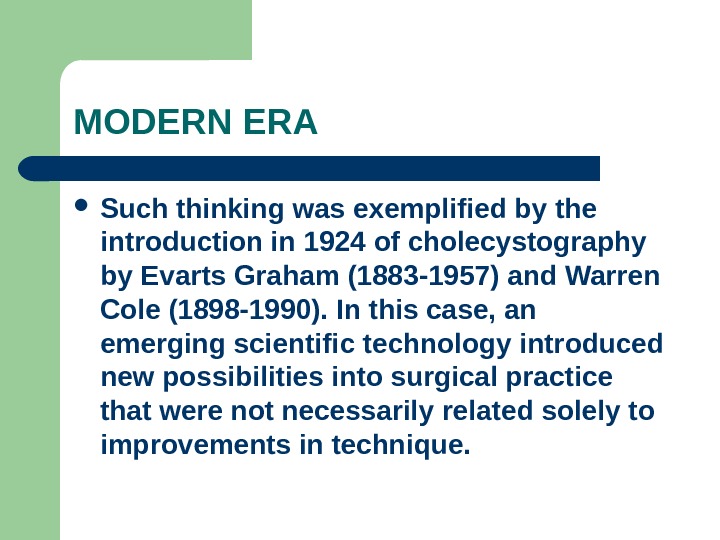
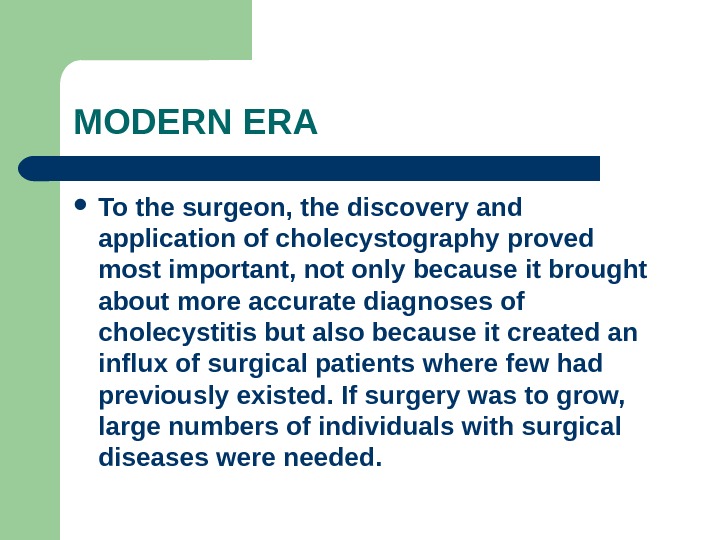
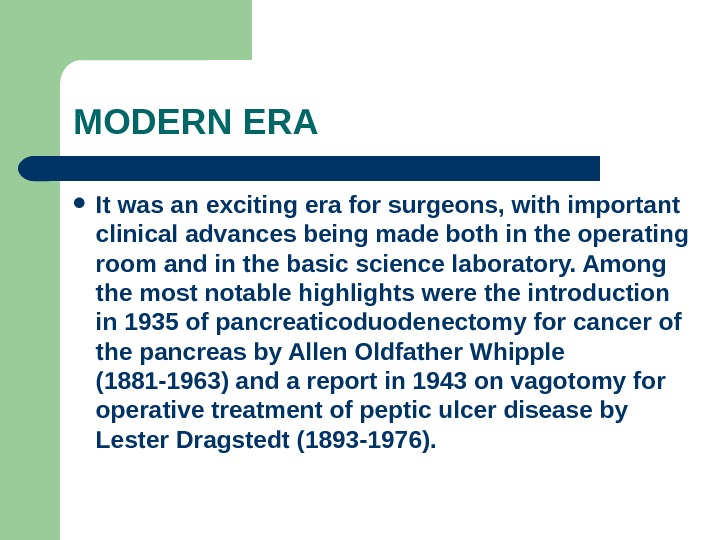
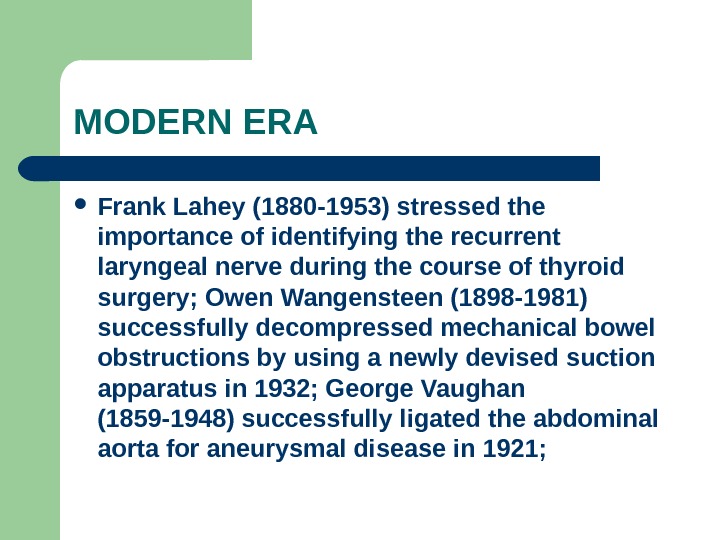
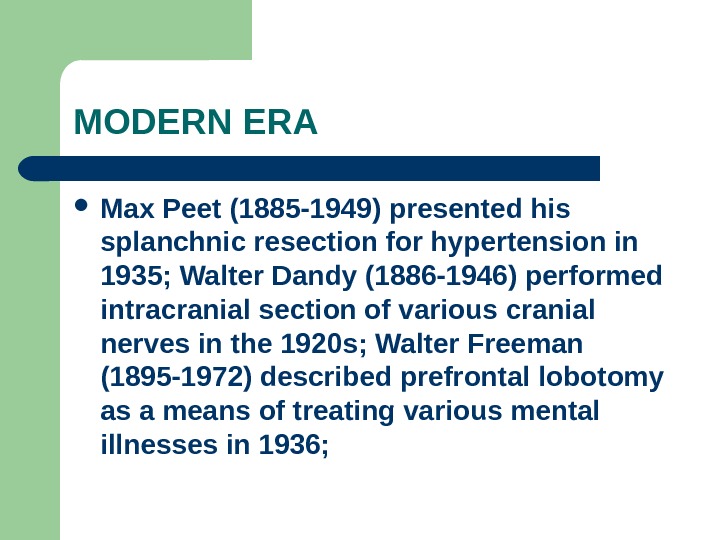
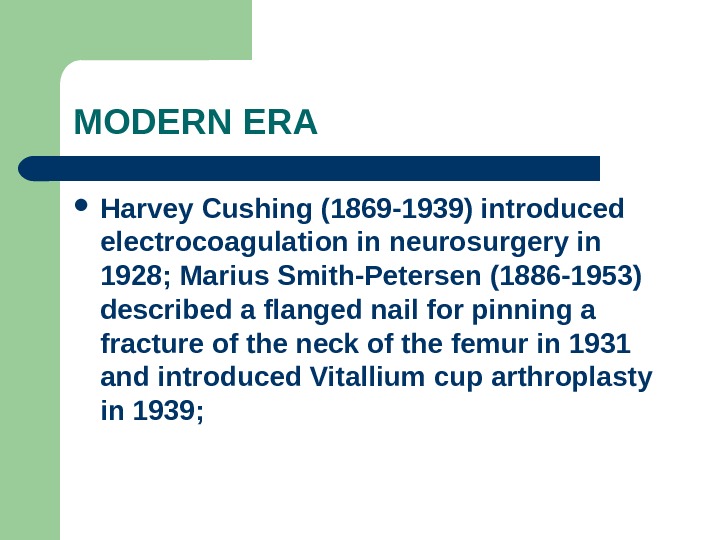

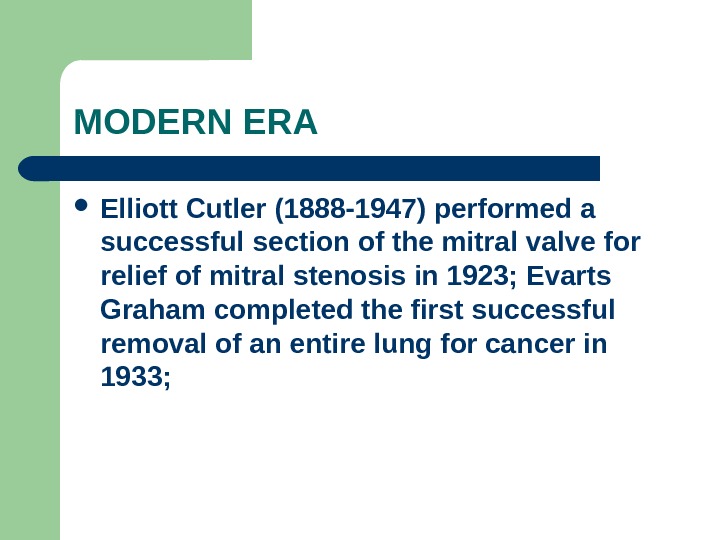

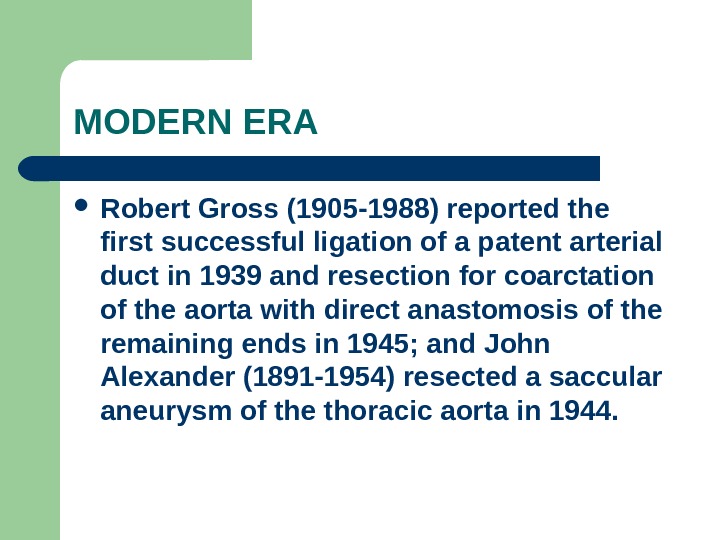
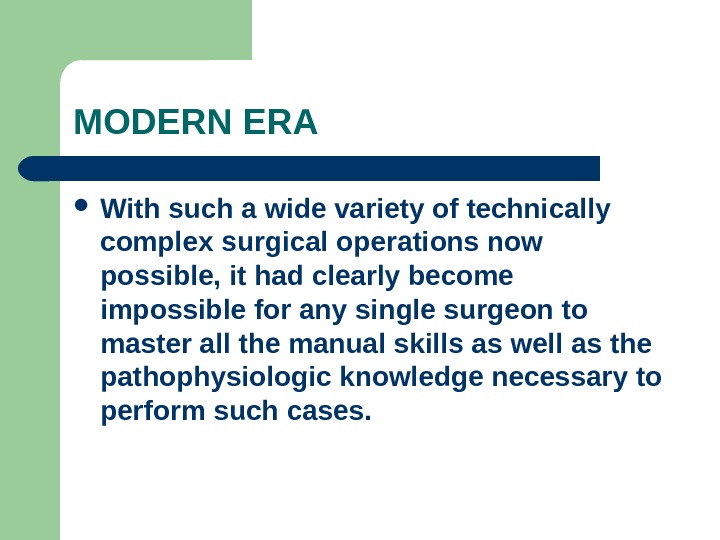
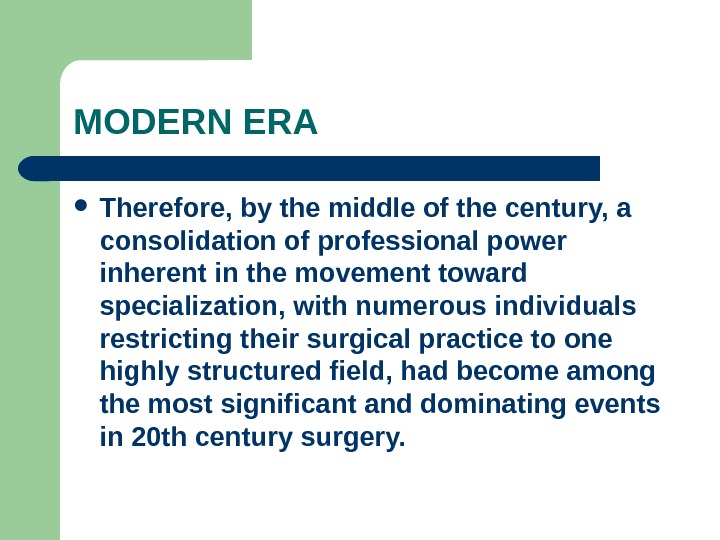
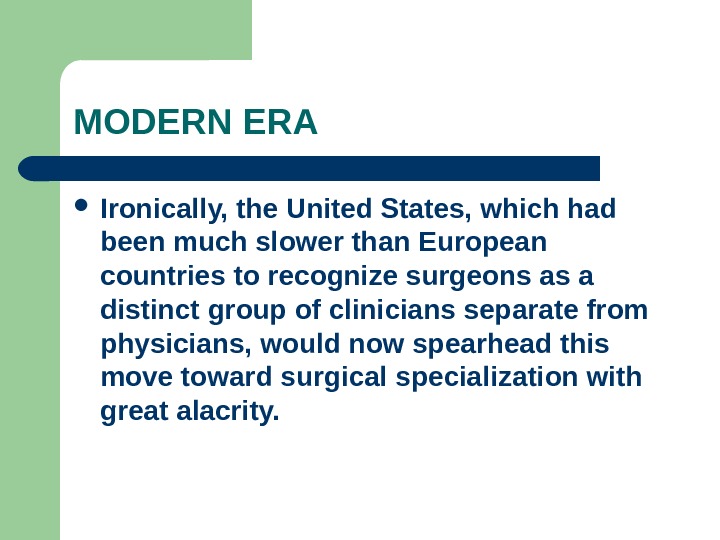
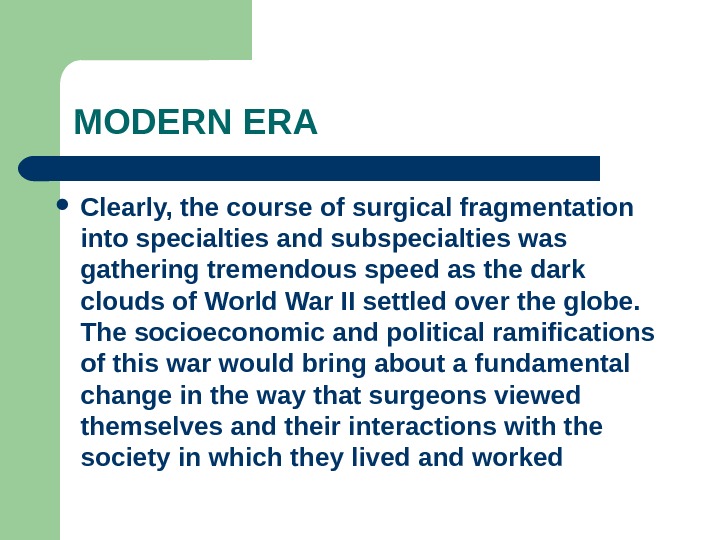
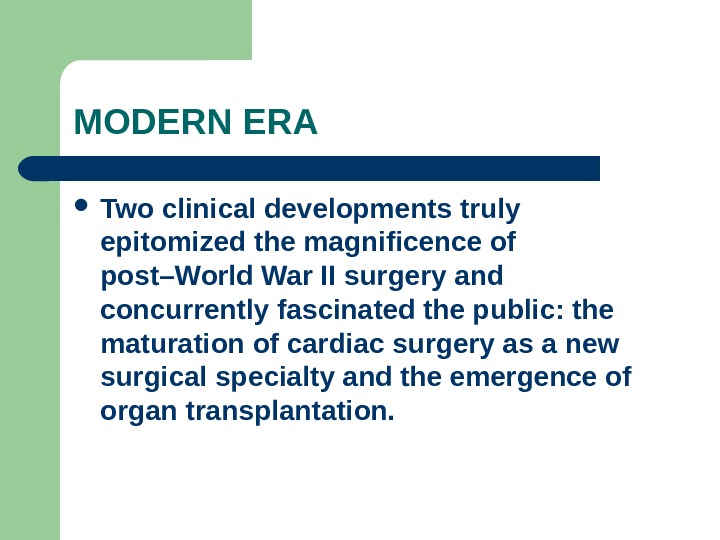
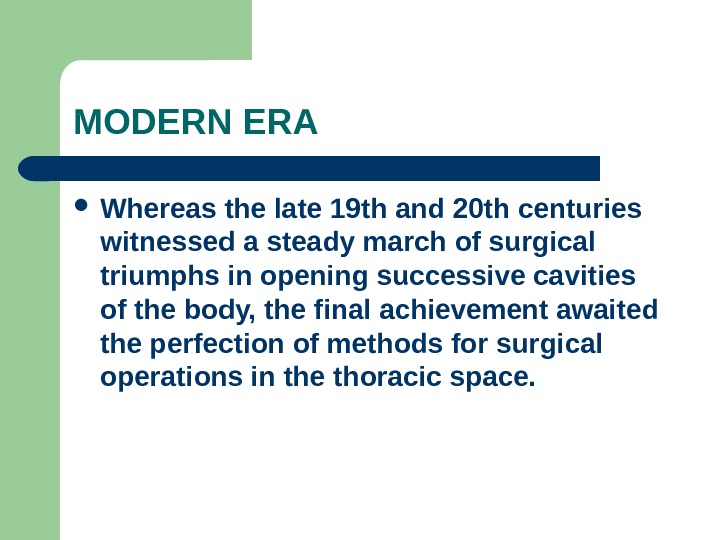
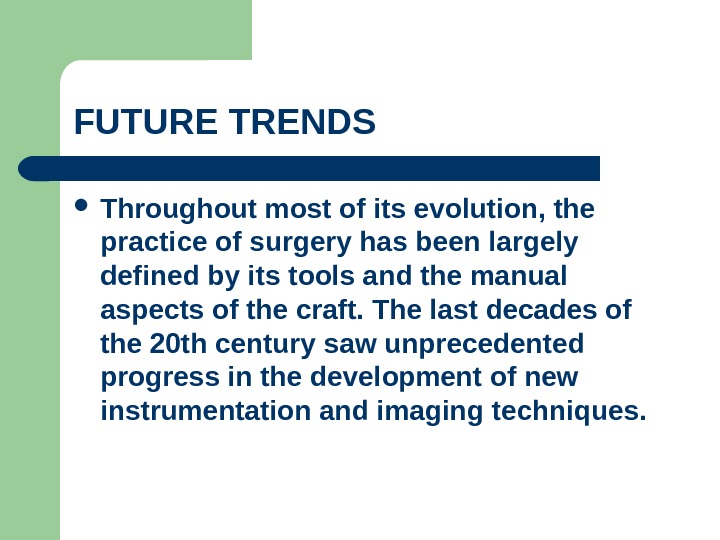
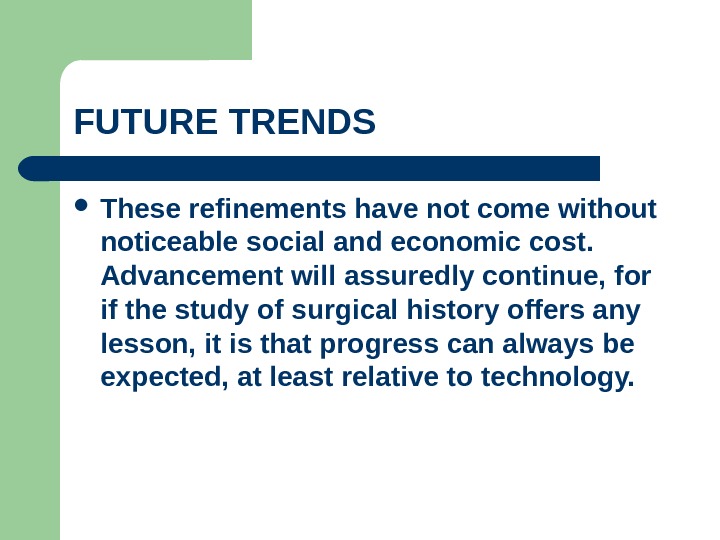
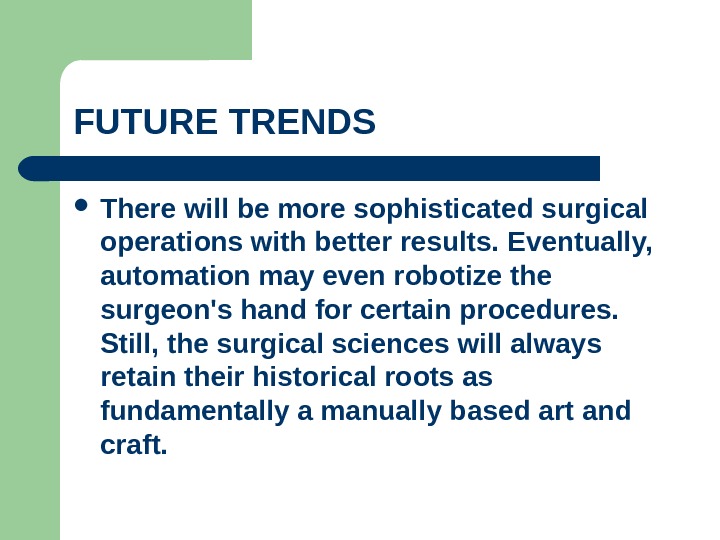

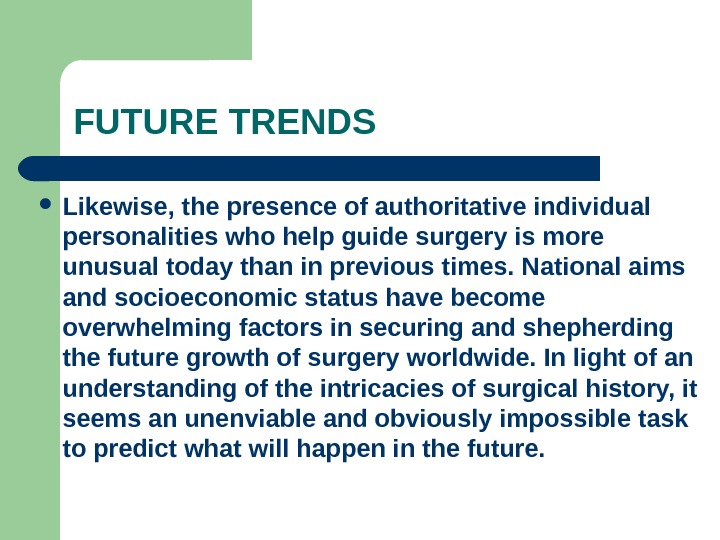
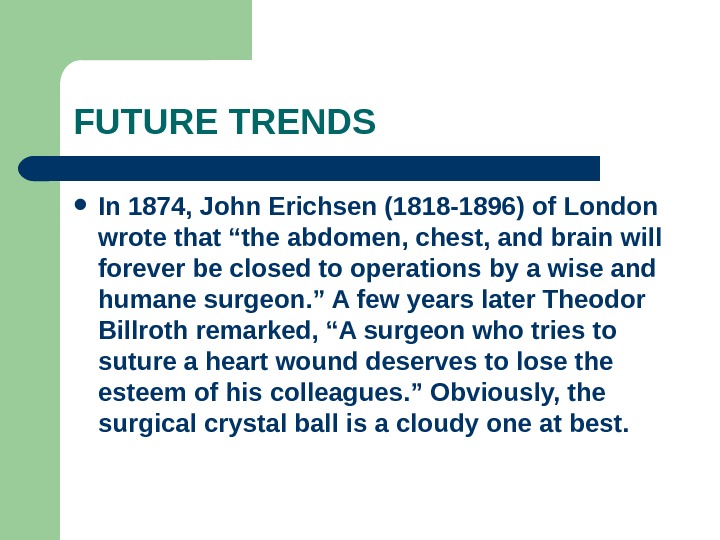
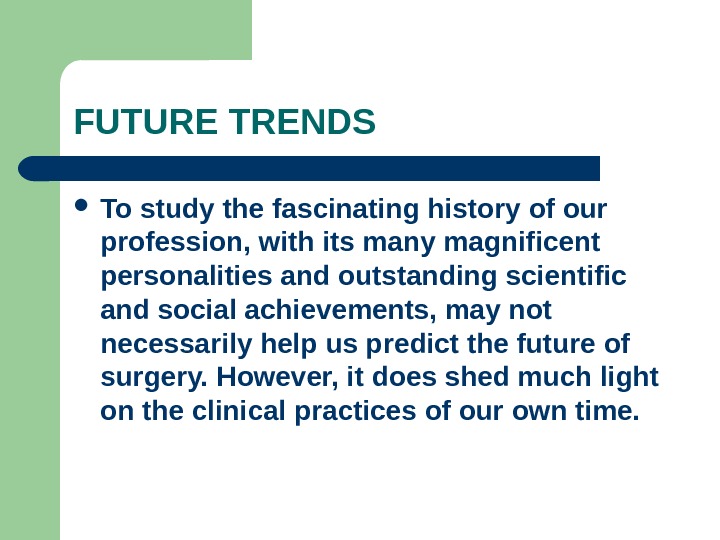
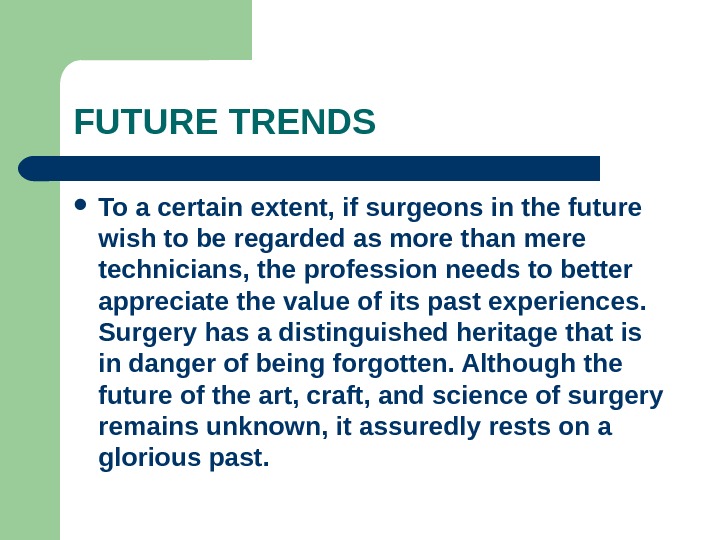
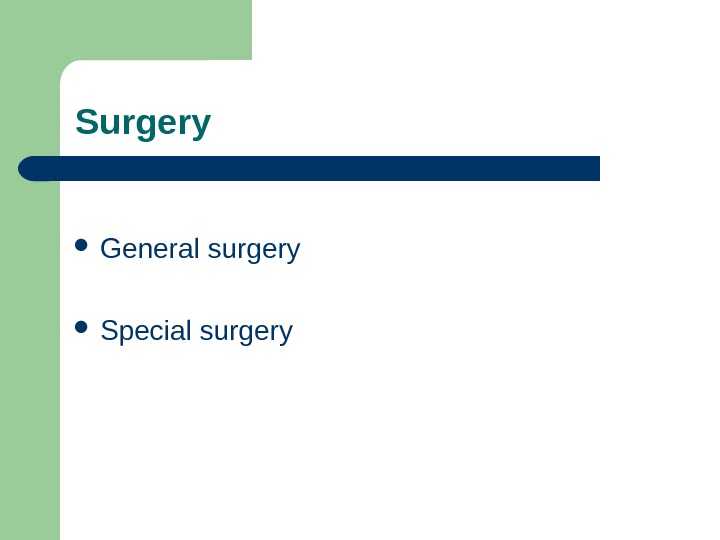
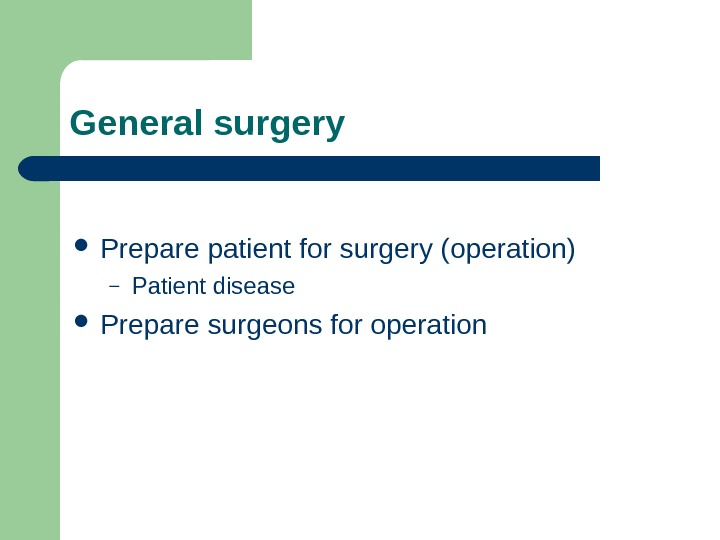
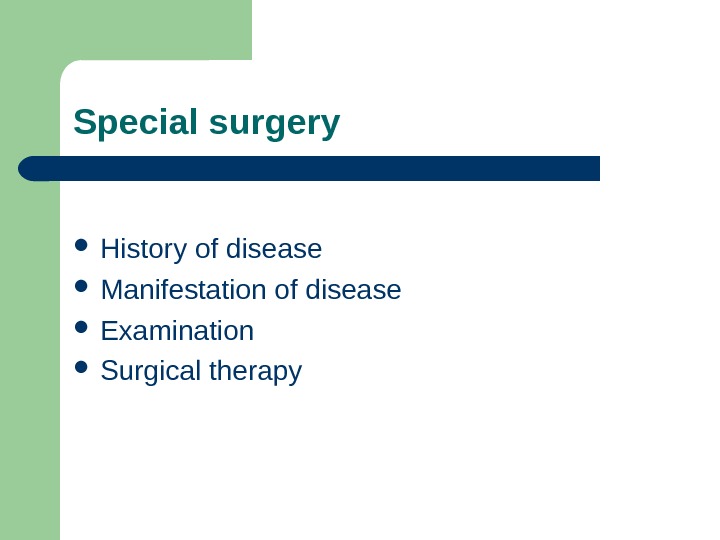
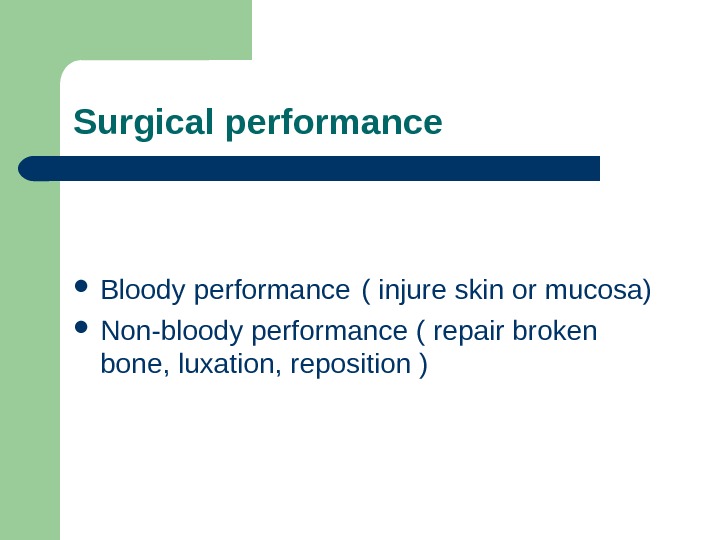
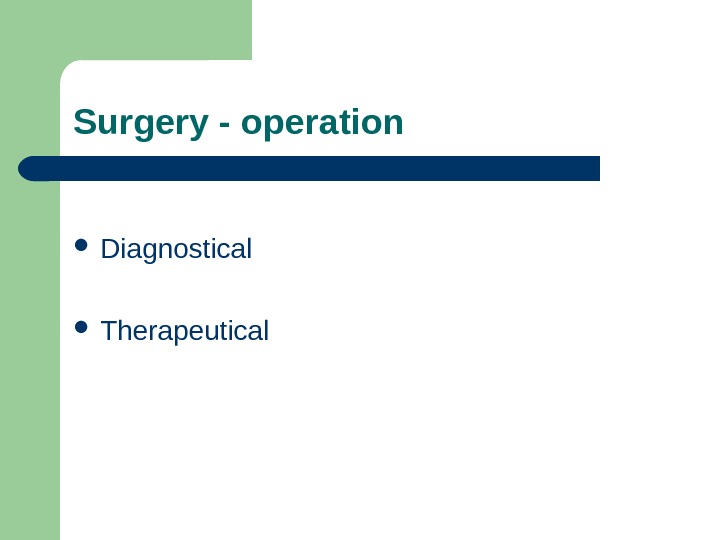
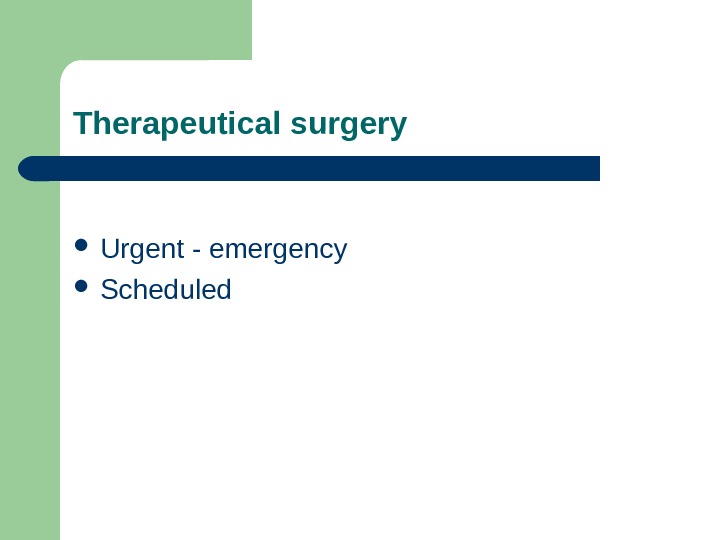
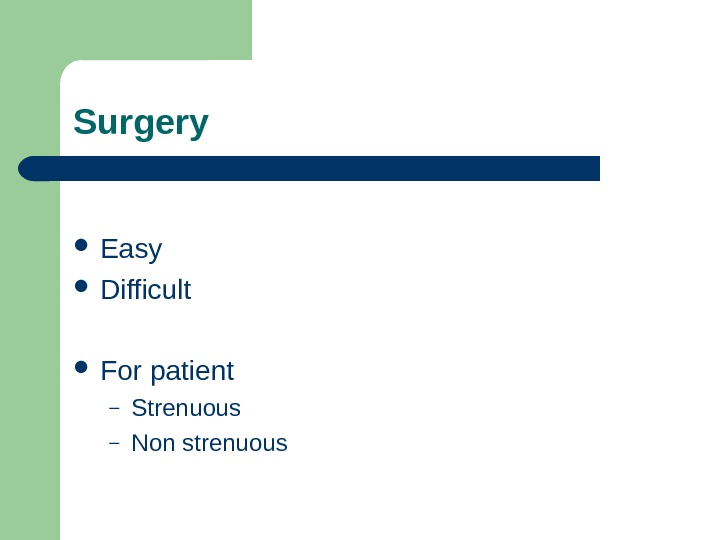
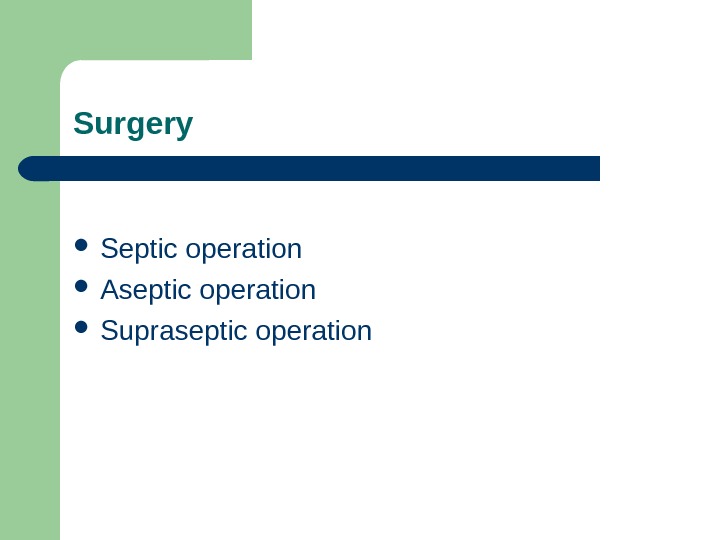
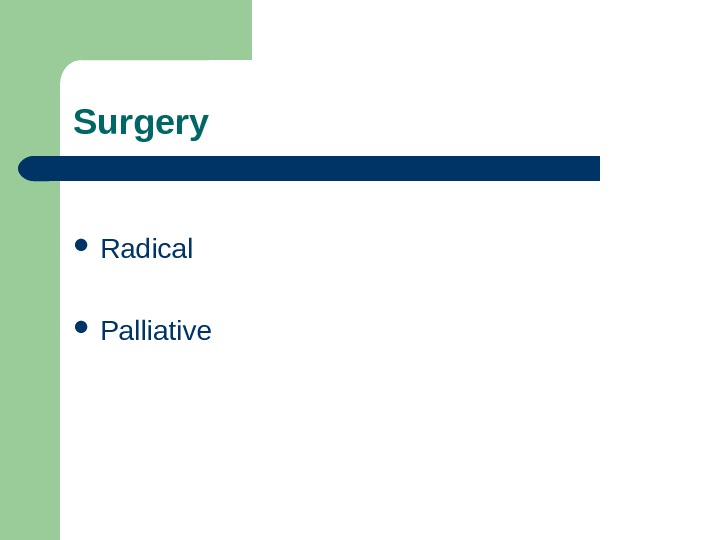
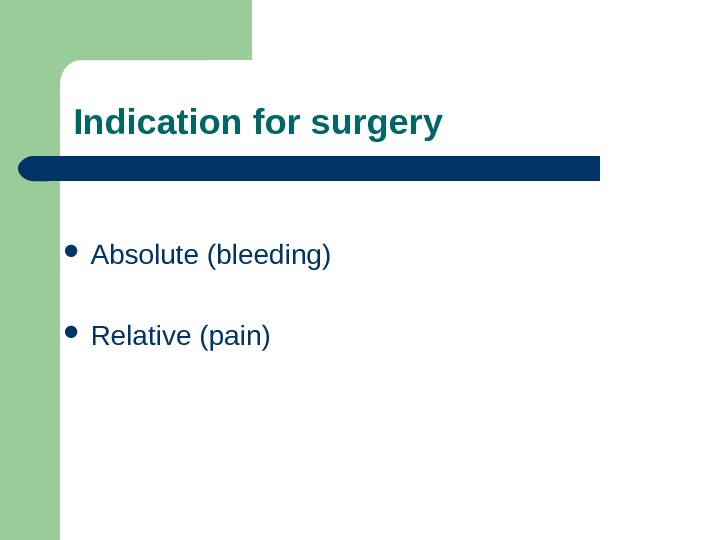
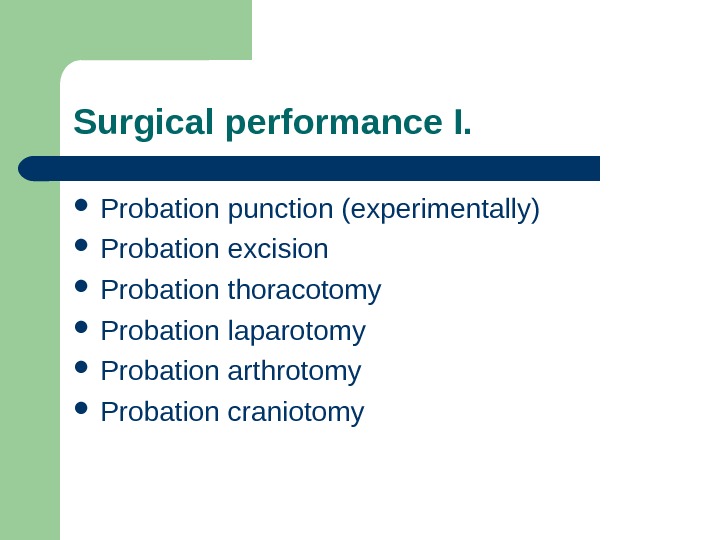
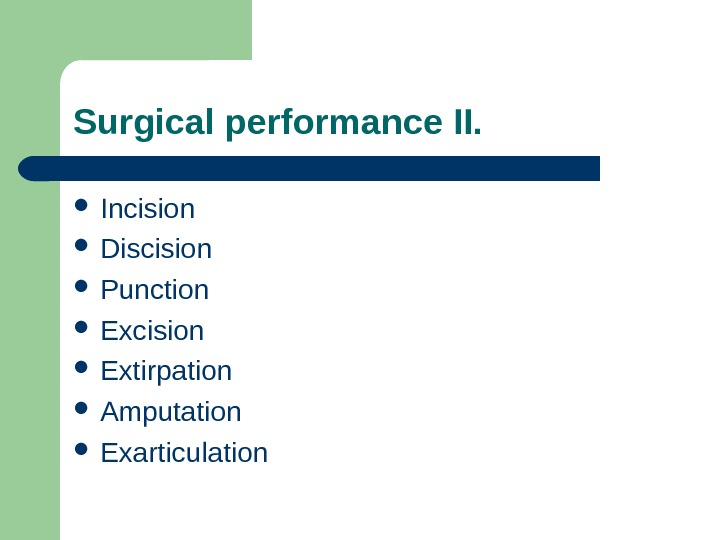
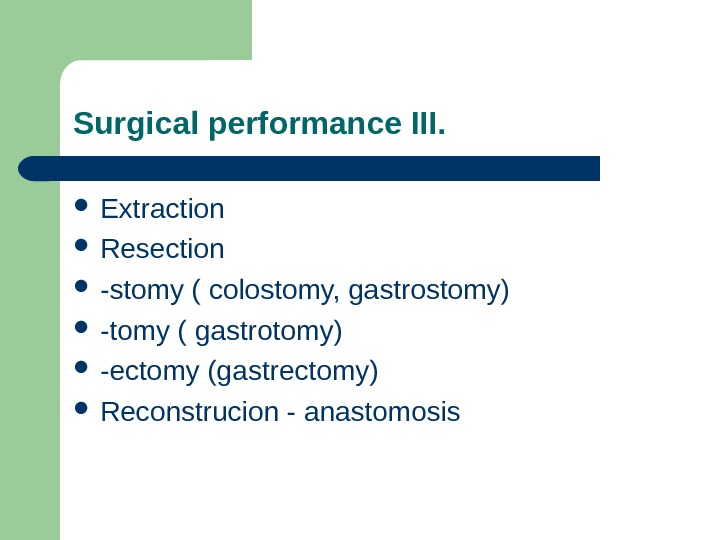
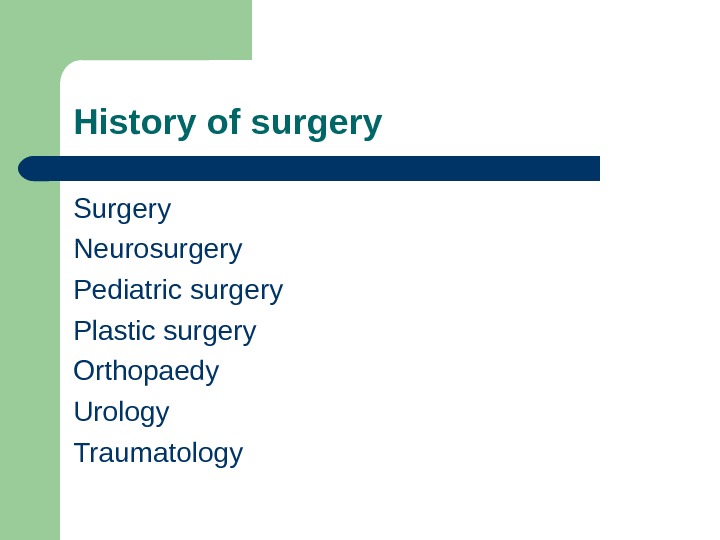

history-of-surgery.24.sept.2010.ppt
- Размер: 2.3 Mегабайта
- Количество слайдов: 147
Описание презентации History of surgery HISTORICAL RELATIONSHIP BETWEEN SURGERY по слайдам
 History of surgery
History of surgery
 HISTORICAL RELATIONSHIP BETWEEN SURGERY AND MEDICINE Despite outward appearances, it was actually not until the latter decades of the 19 th century that the surgeon truly emerged as a specialist within the whole of medicine to become a recognized and respected clinical practitioner. Similarly, it was not until the first decades of the 20 th century that surgery could be considered to have achieved the status of a bona fide profession.
HISTORICAL RELATIONSHIP BETWEEN SURGERY AND MEDICINE Despite outward appearances, it was actually not until the latter decades of the 19 th century that the surgeon truly emerged as a specialist within the whole of medicine to become a recognized and respected clinical practitioner. Similarly, it was not until the first decades of the 20 th century that surgery could be considered to have achieved the status of a bona fide profession.
 HISTORICAL RELATIONSHIP BETWEEN SURGERY AND MEDICINE Before this time, the scope of surgery remained quite limited. Surgeons, or at least those medical men who used the sobriquet surgeon , whether university educated or trained in private apprenticeships, at best treated only simple fractures, dislocations, and abscesses and occasionally performed amputations with dexterity but also with high mortality rates.
HISTORICAL RELATIONSHIP BETWEEN SURGERY AND MEDICINE Before this time, the scope of surgery remained quite limited. Surgeons, or at least those medical men who used the sobriquet surgeon , whether university educated or trained in private apprenticeships, at best treated only simple fractures, dislocations, and abscesses and occasionally performed amputations with dexterity but also with high mortality rates.
 HISTORICAL RELATIONSHIP BETWEEN SURGERY AND MEDICINE They managed to ligate major arteries for common and accessible aneurysms and made heroic attempts to excise external tumors.
HISTORICAL RELATIONSHIP BETWEEN SURGERY AND MEDICINE They managed to ligate major arteries for common and accessible aneurysms and made heroic attempts to excise external tumors.
 HISTORICAL RELATIONSHIP BETWEEN SURGERY AND MEDICINE Some individuals focused on the treatment of anal fistulas, hernias, cataracts, and bladder stones. Inept attempts at reduction of incarcerated and strangulated hernias were made, and hesitatingly, rather rudimentary colostomies or ileostomies were created by simply incising the skin over an expanding intra-abdominal mass, which represented the end stage of a long-standing intestinal obstruction.
HISTORICAL RELATIONSHIP BETWEEN SURGERY AND MEDICINE Some individuals focused on the treatment of anal fistulas, hernias, cataracts, and bladder stones. Inept attempts at reduction of incarcerated and strangulated hernias were made, and hesitatingly, rather rudimentary colostomies or ileostomies were created by simply incising the skin over an expanding intra-abdominal mass, which represented the end stage of a long-standing intestinal obstruction.
 HISTORICAL RELATIONSHIP BETWEEN SURGERY AND MEDICINE Compound fractures of the limbs with attendant sepsis remained mostly unmanageable, with staggering morbidity being a likely surgical outcome. Although a few bold surgeons endeavored to incise the abdomen in the hope of dividing obstructing bands and adhesions, abdominal and other intrabody surgery was virtually unknown.
HISTORICAL RELATIONSHIP BETWEEN SURGERY AND MEDICINE Compound fractures of the limbs with attendant sepsis remained mostly unmanageable, with staggering morbidity being a likely surgical outcome. Although a few bold surgeons endeavored to incise the abdomen in the hope of dividing obstructing bands and adhesions, abdominal and other intrabody surgery was virtually unknown.
 HISTORICAL RELATIONSHIP BETWEEN SURGERY AND MEDICINE Despite it all, including an ignorance of anesthesia and antisepsis tempered with the not uncommon result of the patient suffering from or succumbing to the effects of a surgical operation (or both), surgery was long considered an important and medically valid therapy.
HISTORICAL RELATIONSHIP BETWEEN SURGERY AND MEDICINE Despite it all, including an ignorance of anesthesia and antisepsis tempered with the not uncommon result of the patient suffering from or succumbing to the effects of a surgical operation (or both), surgery was long considered an important and medically valid therapy.
 HISTORICAL RELATIONSHIP BETWEEN SURGERY AND MEDICINE This seeming paradox, in view of the terrifying nature of surgical intervention, its limited technical scope, and its damning consequences before the development of modern conditions, is explained by the simple fact that surgical procedures were usually performed only for external difficulties that required an objective anatomic diagnosis.
HISTORICAL RELATIONSHIP BETWEEN SURGERY AND MEDICINE This seeming paradox, in view of the terrifying nature of surgical intervention, its limited technical scope, and its damning consequences before the development of modern conditions, is explained by the simple fact that surgical procedures were usually performed only for external difficulties that required an objective anatomic diagnosis.
 HISTORICAL RELATIONSHIP BETWEEN SURGERY AND MEDICINE Surgeons or followers of the surgical cause saw what needed to be fixed (e. g. , abscesses, broken bones, bulging tumors, cataracts, hernias) and would treat the problem in as rational a manner as the times permitted. Conversely, the physician was forced to render subjective care for disease processes that were neither visible nor understood.
HISTORICAL RELATIONSHIP BETWEEN SURGERY AND MEDICINE Surgeons or followers of the surgical cause saw what needed to be fixed (e. g. , abscesses, broken bones, bulging tumors, cataracts, hernias) and would treat the problem in as rational a manner as the times permitted. Conversely, the physician was forced to render subjective care for disease processes that were neither visible nor understood.
 HISTORICAL RELATIONSHIP BETWEEN SURGERY AND MEDICINE After all, it is a difficult task to treat the symptoms of illnesses such as arthritis, asthma, heart failure, and diabetes, to name but a few, if there is no scientific understanding or internal knowledge of what constitutes their basic pathologic and physiologic underpinnings.
HISTORICAL RELATIONSHIP BETWEEN SURGERY AND MEDICINE After all, it is a difficult task to treat the symptoms of illnesses such as arthritis, asthma, heart failure, and diabetes, to name but a few, if there is no scientific understanding or internal knowledge of what constitutes their basic pathologic and physiologic underpinnings.
 HISTORICAL RELATIONSHIP BETWEEN SURGERY AND MEDICINE With the breathtaking advances made in pathologic anatomy and experimental physiology during the 18 th and the first part of the 19 th centuries, physicians would soon adopt a therapeutic viewpoint that had long been prevalent among surgeons. It was no longer a question of just treating symptoms; the actual pathologic problem could ultimately be understood.
HISTORICAL RELATIONSHIP BETWEEN SURGERY AND MEDICINE With the breathtaking advances made in pathologic anatomy and experimental physiology during the 18 th and the first part of the 19 th centuries, physicians would soon adopt a therapeutic viewpoint that had long been prevalent among surgeons. It was no longer a question of just treating symptoms; the actual pathologic problem could ultimately be understood.
 HISTORICAL RELATIONSHIP BETWEEN SURGERY AND MEDICINE Internal disease processes that manifested themselves through difficult-to-treat external signs and symptoms were finally described via physiology-based experimentation or viewed pathologically through the lens of a microscope.
HISTORICAL RELATIONSHIP BETWEEN SURGERY AND MEDICINE Internal disease processes that manifested themselves through difficult-to-treat external signs and symptoms were finally described via physiology-based experimentation or viewed pathologically through the lens of a microscope.
 HISTORICAL RELATIONSHIP BETWEEN SURGERY AND MEDICINE Because this reorientation of internal medicine occurred within a relatively short time and brought about such dramatic results in the classification, diagnosis, and treatment of disease, the rapid ascent of mid-19 th century internal medicine might seem more impressive than the agonizingly slow, but steady advance of surgery.
HISTORICAL RELATIONSHIP BETWEEN SURGERY AND MEDICINE Because this reorientation of internal medicine occurred within a relatively short time and brought about such dramatic results in the classification, diagnosis, and treatment of disease, the rapid ascent of mid-19 th century internal medicine might seem more impressive than the agonizingly slow, but steady advance of surgery.
 HISTORICAL RELATIONSHIP BETWEEN SURGERY AND MEDICINE In a seeming contradiction of mid-19 th century scientific and social reality, medicine appeared as the more progressive branch, with surgery lagging behind. The art and craft of surgery, for all its practical possibilities, would be severely restricted until the discovery of anesthesia in 1846 and an understanding and acceptance of the need for surgical antisepsis and asepsis during the 1870 s and 1880 s.
HISTORICAL RELATIONSHIP BETWEEN SURGERY AND MEDICINE In a seeming contradiction of mid-19 th century scientific and social reality, medicine appeared as the more progressive branch, with surgery lagging behind. The art and craft of surgery, for all its practical possibilities, would be severely restricted until the discovery of anesthesia in 1846 and an understanding and acceptance of the need for surgical antisepsis and asepsis during the 1870 s and 1880 s.
 HISTORICAL RELATIONSHIP BETWEEN SURGERY AND MEDICINE Still, surgeons never needed a diagnostic and pathologic revolution in the manner of the physician. Despite the imperfection of their scientific knowledge, the pre–modern era surgeon did cure with some technical confidence.
HISTORICAL RELATIONSHIP BETWEEN SURGERY AND MEDICINE Still, surgeons never needed a diagnostic and pathologic revolution in the manner of the physician. Despite the imperfection of their scientific knowledge, the pre–modern era surgeon did cure with some technical confidence.
 HISTORICAL RELATIONSHIP BETWEEN SURGERY AND MEDICINE That the gradual evolution of surgery was superseded in the 1880 s and 1890 s by the rapid introduction of startling new technical advances was based on a simple culminating axiom—the four fundamental clinical prerequisites that were required before a surgical operation could ever be considered a truly viable therapeutic procedure had finally been identified and u nderstood:
HISTORICAL RELATIONSHIP BETWEEN SURGERY AND MEDICINE That the gradual evolution of surgery was superseded in the 1880 s and 1890 s by the rapid introduction of startling new technical advances was based on a simple culminating axiom—the four fundamental clinical prerequisites that were required before a surgical operation could ever be considered a truly viable therapeutic procedure had finally been identified and u nderstood:
 HISTORICAL RELATIONSHIP BETWEEN SURGERY AND MEDICINE 1. Knowledge of human anatomy 2. Method of controlling hemorrhage and maintaining intraoperative hemostasis 3. Anesthesia to permit the performance of pain-free procedures 4. Explanation of the nature of infection along with the elaboration of methods necessary to achieve an antiseptic and aseptic operating room environment
HISTORICAL RELATIONSHIP BETWEEN SURGERY AND MEDICINE 1. Knowledge of human anatomy 2. Method of controlling hemorrhage and maintaining intraoperative hemostasis 3. Anesthesia to permit the performance of pain-free procedures 4. Explanation of the nature of infection along with the elaboration of methods necessary to achieve an antiseptic and aseptic operating room environment
 HISTORICAL RELATIONSHIP BETWEEN SURGERY AND MEDICINE The first two prerequisites were essentially solved in the 16 th century, but the latter two would not be fully resolved until the ending decades of the 19 th century. In turn, the ascent of 20 th century scientific surgery would unify the profession and allow what had always been an art and craft to become a learned vocation.
HISTORICAL RELATIONSHIP BETWEEN SURGERY AND MEDICINE The first two prerequisites were essentially solved in the 16 th century, but the latter two would not be fully resolved until the ending decades of the 19 th century. In turn, the ascent of 20 th century scientific surgery would unify the profession and allow what had always been an art and craft to become a learned vocation.
 HISTORICAL RELATIONSHIP BETWEEN SURGERY AND MEDICINE Standardized postgraduate surgical education and training programs could be established to help produce a cadre of scientifically knowledgeable practitioners. Moreover, in a final snub to an unscientific past, newly established basic surgical research laboratories offered the means of proving or disproving the latest theories while providing a testing ground for bold and exciting clinical breakthroughs.
HISTORICAL RELATIONSHIP BETWEEN SURGERY AND MEDICINE Standardized postgraduate surgical education and training programs could be established to help produce a cadre of scientifically knowledgeable practitioners. Moreover, in a final snub to an unscientific past, newly established basic surgical research laboratories offered the means of proving or disproving the latest theories while providing a testing ground for bold and exciting clinical breakthroughs.
 KNOWLEDGE OF HUMAN ANATOMY Few individuals have had an influence on the history of surgery as overwhelmingly as that of the Brussels-born Andreas Vesalius (1514 -1564)
KNOWLEDGE OF HUMAN ANATOMY Few individuals have had an influence on the history of surgery as overwhelmingly as that of the Brussels-born Andreas Vesalius (1514 -1564)
 KNOWLEDGE OF HUMAN ANATOMY Andreas Vesalius (1514 -1564)
KNOWLEDGE OF HUMAN ANATOMY Andreas Vesalius (1514 -1564)
 KNOWLEDGE OF HUMAN ANATOMY As professor of anatomy and surgery in Padua, Italy, Vesalius taught that human anatomy could be learned only through the study of structures revealed by human dissection. In particular, his great anatomic treatise De Humani Corporis Fabrica Libri Septem (1543) provided fuller and more detailed descriptions of human anatomy than any of his illustrious predecessors did.
KNOWLEDGE OF HUMAN ANATOMY As professor of anatomy and surgery in Padua, Italy, Vesalius taught that human anatomy could be learned only through the study of structures revealed by human dissection. In particular, his great anatomic treatise De Humani Corporis Fabrica Libri Septem (1543) provided fuller and more detailed descriptions of human anatomy than any of his illustrious predecessors did.
 KNOWLEDGE OF HUMAN ANATOMY Most importantly, Vesalius corrected errors in traditional anatomic teachings propagated 13 centuries earlier by Greek and Roman authorities, whose findings were based on animal rather than human dissection.
KNOWLEDGE OF HUMAN ANATOMY Most importantly, Vesalius corrected errors in traditional anatomic teachings propagated 13 centuries earlier by Greek and Roman authorities, whose findings were based on animal rather than human dissection.
 KNOWLEDGE OF HUMAN ANATOMY Even more radical was Vesalius’ blunt assertion that anatomic dissection must be completed by physician/surgeons themselves—a direct renunciation of the long-standing doctrine that dissection was a grisly and loathsome task to be performed by a diener-like individual while from on high the perched physician/surgeon lectured by reading from an orthodox anatomic text.
KNOWLEDGE OF HUMAN ANATOMY Even more radical was Vesalius’ blunt assertion that anatomic dissection must be completed by physician/surgeons themselves—a direct renunciation of the long-standing doctrine that dissection was a grisly and loathsome task to be performed by a diener-like individual while from on high the perched physician/surgeon lectured by reading from an orthodox anatomic text.
 KNOWLEDGE OF HUMAN ANATOMY This principle of hands-on education would remain Vesalius’ most important and long-lasting contribution to the teaching of anatomy. Vesalius’ Latin literae scriptae ensured its accessibility to the most well-known physicians and scientists of the day.
KNOWLEDGE OF HUMAN ANATOMY This principle of hands-on education would remain Vesalius’ most important and long-lasting contribution to the teaching of anatomy. Vesalius’ Latin literae scriptae ensured its accessibility to the most well-known physicians and scientists of the day.
 KNOWLEDGE OF HUMAN ANATOMY Latin was the language of the intelligentsia and the Fabrica became instantly popular, so it was only natural that over the next 2 centuries the work would go through numerous adaptations, editions, and revisions, though always remaining an authoritative anatomic text.
KNOWLEDGE OF HUMAN ANATOMY Latin was the language of the intelligentsia and the Fabrica became instantly popular, so it was only natural that over the next 2 centuries the work would go through numerous adaptations, editions, and revisions, though always remaining an authoritative anatomic text.
 METHOD OF CONTROLLING HEMORRHAGE The position of Ambroise Paré (1510 -1590) in the evolution of surgery remains of supreme importance. He played the major role in reinvigorating and updating Renaissance surgery and represents severing of the final link between surgical thought and techniques of the ancients and the push toward more modern eras.
METHOD OF CONTROLLING HEMORRHAGE The position of Ambroise Paré (1510 -1590) in the evolution of surgery remains of supreme importance. He played the major role in reinvigorating and updating Renaissance surgery and represents severing of the final link between surgical thought and techniques of the ancients and the push toward more modern eras.
 METHOD OF CONTROLLING HEMORRHAGE From 1536 until just before his death, Paré was either engaged as an army surgeon, during which he accompanied different French armies on their military expeditions, or performing surgery in civilian practice in Paris.
METHOD OF CONTROLLING HEMORRHAGE From 1536 until just before his death, Paré was either engaged as an army surgeon, during which he accompanied different French armies on their military expeditions, or performing surgery in civilian practice in Paris.
 METHOD OF CONTROLLING HEMORRHAGE Ambroise Paré (1510 -1590 )
METHOD OF CONTROLLING HEMORRHAGE Ambroise Paré (1510 -1590 )
 METHOD OF CONTROLLING HEMORRHAGE Although other surgeons made similar observations about the difficulties and nonsensical aspects of using boiling oil as a means of cauterizing fresh gunshot wounds, Paré’s use of a less irritating emollient of egg yolk, rose oil, and turpentine brought him lasting fame and glory.
METHOD OF CONTROLLING HEMORRHAGE Although other surgeons made similar observations about the difficulties and nonsensical aspects of using boiling oil as a means of cauterizing fresh gunshot wounds, Paré’s use of a less irritating emollient of egg yolk, rose oil, and turpentine brought him lasting fame and glory.
 METHOD OF CONTROLLING HEMORRHAGE His ability to articulate such a finding in multiple textbooks, all written in the vernacular, allowed his writings to reach more than just the educated elite. Among Paré’s important corollary observations was that when performing an amputation, it was more efficacious to ligate individual blood vessels than to attempt to control hemorrhage by means of mass ligation of tissue or with hot oleum.
METHOD OF CONTROLLING HEMORRHAGE His ability to articulate such a finding in multiple textbooks, all written in the vernacular, allowed his writings to reach more than just the educated elite. Among Paré’s important corollary observations was that when performing an amputation, it was more efficacious to ligate individual blood vessels than to attempt to control hemorrhage by means of mass ligation of tissue or with hot oleum.
 METHOD OF CONTROLLING HEMORRHAGE Described in his Dix Livres de la Chirurgie avec le Magasin des Instruments Necessaires à Icelle (1564), the free or cut end of a blood vessel was doubly ligated and the ligature was allowed to remain undisturbed in situ until, as a result of local suppuration, it was cast off.
METHOD OF CONTROLLING HEMORRHAGE Described in his Dix Livres de la Chirurgie avec le Magasin des Instruments Necessaires à Icelle (1564), the free or cut end of a blood vessel was doubly ligated and the ligature was allowed to remain undisturbed in situ until, as a result of local suppuration, it was cast off.
 METHOD OF CONTROLLING HEMORRHAGE Paré humbly attributed his success with patients to God, as noted in his famous motto, “Je le pansay. Dieu le guérit, ” that is, “I treated him. God cured him. ”
METHOD OF CONTROLLING HEMORRHAGE Paré humbly attributed his success with patients to God, as noted in his famous motto, “Je le pansay. Dieu le guérit, ” that is, “I treated him. God cured him. ”
 PATHOPHYSIOLOGIC BASIS OF SURGICAL DISEASES Although it would be another 3 centuries before third desideratum, that of anesthesia, was discovered, much of the scientific understanding concerning efforts to relieve discomfort secondary to surgical operations was based on the 18 th century work of England’s premier surgical scientist, John Hunter (1728 -1793)
PATHOPHYSIOLOGIC BASIS OF SURGICAL DISEASES Although it would be another 3 centuries before third desideratum, that of anesthesia, was discovered, much of the scientific understanding concerning efforts to relieve discomfort secondary to surgical operations was based on the 18 th century work of England’s premier surgical scientist, John Hunter (1728 -1793)
 PATHOPHYSIOLOGIC BASIS OF SURGICAL DISEASES John Hunter (1728 -1793)
PATHOPHYSIOLOGIC BASIS OF SURGICAL DISEASES John Hunter (1728 -1793)
 PATHOPHYSIOLOGIC BASIS OF SURGICAL DISEASES Considered one of the most influential surgeons of all time, his endeavors stand out because of the prolificacy of his written word and the quality of his research, especially in using experimental animal surgery as a way to understand the pathophysiologic basis of surgical diseases.
PATHOPHYSIOLOGIC BASIS OF SURGICAL DISEASES Considered one of the most influential surgeons of all time, his endeavors stand out because of the prolificacy of his written word and the quality of his research, especially in using experimental animal surgery as a way to understand the pathophysiologic basis of surgical diseases.
 PATHOPHYSIOLOGIC BASIS OF SURGICAL DISEASES Most impressively, Hunter relied little on theories of past authorities but rather on personal observations, with his fundamental pathologic studies first described in the renowned textbook A Treatise on the Blood, Inflammation, and Gun-Shot Wounds (1794)
PATHOPHYSIOLOGIC BASIS OF SURGICAL DISEASES Most impressively, Hunter relied little on theories of past authorities but rather on personal observations, with his fundamental pathologic studies first described in the renowned textbook A Treatise on the Blood, Inflammation, and Gun-Shot Wounds (1794)
 PATHOPHYSIOLOGIC BASIS OF SURGICAL DISEASES Ultimately, his voluminous research and clinical work resulted in a collection of more than 13, 000 specimens, which became one of his most important legacies to the world of surgery. It represented a unique warehousing of separate organ systems, with comparisons of these systems, from the simplest animal or plant to humans, demonstrating the interaction of structure and function.
PATHOPHYSIOLOGIC BASIS OF SURGICAL DISEASES Ultimately, his voluminous research and clinical work resulted in a collection of more than 13, 000 specimens, which became one of his most important legacies to the world of surgery. It represented a unique warehousing of separate organ systems, with comparisons of these systems, from the simplest animal or plant to humans, demonstrating the interaction of structure and function.
 PATHOPHYSIOLOGIC BASIS OF SURGICAL DISEASES For decades, Hunter’s collection, housed in England’s Royal College of Surgeons, remained the outstanding museum of comparative anatomy and pathology in the world. That was until a World War II Nazi bombing attack of London created a conflagration that destroyed most of Hunter’s assemblage.
PATHOPHYSIOLOGIC BASIS OF SURGICAL DISEASES For decades, Hunter’s collection, housed in England’s Royal College of Surgeons, remained the outstanding museum of comparative anatomy and pathology in the world. That was until a World War II Nazi bombing attack of London created a conflagration that destroyed most of Hunter’s assemblage.
 ANESTHESIA Since time immemorial, the inability of surgeons to complete pain-free operations had been among the most terrifying of medical problems. In the preanesthetic era, surgeons were forced to be more concerned about the speed with which an operation was completed than with the clinical efficacy of their dissection.
ANESTHESIA Since time immemorial, the inability of surgeons to complete pain-free operations had been among the most terrifying of medical problems. In the preanesthetic era, surgeons were forced to be more concerned about the speed with which an operation was completed than with the clinical efficacy of their dissection.
 ANESTHESIA In a similar vein, patients refused or delayed surgical procedures for as long as possible to avoid the personal horror of experiencing the surgeon’s knife. Analgesic, narcotic, and soporific agents such as hashish, mandrake, and opium had been put to use for thousands of years.
ANESTHESIA In a similar vein, patients refused or delayed surgical procedures for as long as possible to avoid the personal horror of experiencing the surgeon’s knife. Analgesic, narcotic, and soporific agents such as hashish, mandrake, and opium had been put to use for thousands of years.
 ANESTHESIA However, the systematic operative invasion of body cavities and the inevitable progression of surgical history could not occur until an effective means of rendering a patient insensitive to pain was developed.
ANESTHESIA However, the systematic operative invasion of body cavities and the inevitable progression of surgical history could not occur until an effective means of rendering a patient insensitive to pain was developed.
 ANESTHESIA As anatomic knowledge and surgical techniques improved, the search for safe methods to prevent pain became more pressing. By the early 1830 s, chloroform, ether, and nitrous oxide had been discovered and so-called laughing gas parties and ether frolics were in vogue, especially in America.
ANESTHESIA As anatomic knowledge and surgical techniques improved, the search for safe methods to prevent pain became more pressing. By the early 1830 s, chloroform, ether, and nitrous oxide had been discovered and so-called laughing gas parties and ether frolics were in vogue, especially in America.
 ANESTHESIA Young people were amusing themselves with the pleasant side effects of these compounds as itinerant so-called professors of chemistry traveled to hamlets, towns, and cities to lecture on and demonstrate the exhilarating effects of these new gases. It soon became evident to various physicians and dentists that the pain-relieving qualities of ether and nitrous oxide could be applicable to surgical operations and tooth extraction.
ANESTHESIA Young people were amusing themselves with the pleasant side effects of these compounds as itinerant so-called professors of chemistry traveled to hamlets, towns, and cities to lecture on and demonstrate the exhilarating effects of these new gases. It soon became evident to various physicians and dentists that the pain-relieving qualities of ether and nitrous oxide could be applicable to surgical operations and tooth extraction.
 ANESTHESIA On October 16, 1846, William T. G. Morton (1819 -1868), a Boston dentist, persuaded John Collins Warren (1778 -1856), professor of surgery at the Massachusetts General Hospital, to let him administer sulfuric ether to a surgical patient from whom Warren went on to painlessly remove a small, congenital vascular tumor of the neck.
ANESTHESIA On October 16, 1846, William T. G. Morton (1819 -1868), a Boston dentist, persuaded John Collins Warren (1778 -1856), professor of surgery at the Massachusetts General Hospital, to let him administer sulfuric ether to a surgical patient from whom Warren went on to painlessly remove a small, congenital vascular tumor of the neck.
 ANESTHESIA After the operation, Warren, greatly impressed with the new discovery, uttered his famous words: “Gentlemen, this is no humbug. ”
ANESTHESIA After the operation, Warren, greatly impressed with the new discovery, uttered his famous words: “Gentlemen, this is no humbug. ”
 ANESTHESIA Few medical discoveries have been so readily accepted as inhalational anesthesia. News of the momentous event spread rapidly throughout the United States and Europe, and a new era in the history of surgery had begun. Within a few months after the first public demonstration in Boston, ether was used in hospitals throughout the world.
ANESTHESIA Few medical discoveries have been so readily accepted as inhalational anesthesia. News of the momentous event spread rapidly throughout the United States and Europe, and a new era in the history of surgery had begun. Within a few months after the first public demonstration in Boston, ether was used in hospitals throughout the world.
 ANESTHESIA Yet no matter how much it contributed to the relief of pain during surgical operations and decreased the surgeon’s angst, the discovery did not immediately further the scope of elective surgery.
ANESTHESIA Yet no matter how much it contributed to the relief of pain during surgical operations and decreased the surgeon’s angst, the discovery did not immediately further the scope of elective surgery.
 ANESTHESIA Such technical triumphs awaited the recognition and acceptance of antisepsis and asepsis. Anesthesia helped make the illusion of surgical cures more seductive, but it could not bring forth the final prerequisite: all-important hygienic reforms.
ANESTHESIA Such technical triumphs awaited the recognition and acceptance of antisepsis and asepsis. Anesthesia helped make the illusion of surgical cures more seductive, but it could not bring forth the final prerequisite: all-important hygienic reforms.
 ANESTHESIA Still, by the mid-19 th century, both doctors and patients were coming to hold surgery in relatively high regard for its pragmatic appeal, technologic virtuosity, and unambiguously measurable results. After all, surgery appeared to some a mystical craft. To be allowed to consensually cut into another human’s body, to gaze at the depth of that person’s suffering, and to excise the demon of disease seemed an awesome responsibility.
ANESTHESIA Still, by the mid-19 th century, both doctors and patients were coming to hold surgery in relatively high regard for its pragmatic appeal, technologic virtuosity, and unambiguously measurable results. After all, surgery appeared to some a mystical craft. To be allowed to consensually cut into another human’s body, to gaze at the depth of that person’s suffering, and to excise the demon of disease seemed an awesome responsibility.
 ANESTHESIA Yet it was this very mysticism, long associated with religious overtones, that so fascinated the public and their own feared but inevitable date with a surgeon’s knife.
ANESTHESIA Yet it was this very mysticism, long associated with religious overtones, that so fascinated the public and their own feared but inevitable date with a surgeon’s knife.
 ANESTHESIA Surgeons had finally begun to view themselves as combining art and nature, essentially assisting nature in its continual process of destruction and rebuilding. This regard for the natural would spring from the eventual, though preternaturally slow, understanding and use of Joseph Lister’s (1827 -1912) techniques.
ANESTHESIA Surgeons had finally begun to view themselves as combining art and nature, essentially assisting nature in its continual process of destruction and rebuilding. This regard for the natural would spring from the eventual, though preternaturally slow, understanding and use of Joseph Lister’s (1827 -1912) techniques.
 Joseph Lister (1827 -1912)
Joseph Lister (1827 -1912)
 ANTISEPSIS, AND UNDERSTANDING THE NATURE OF INFECTION In many respects, the recognition of antisepsis and asepsis was a more important event in the evolution of surgical history than the advent of inhalational anesthesia was. There was no arguing that deadening of pain permitted a surgical operation to be conducted in a more efficacious manner. Haste was no longer of prime concern.
ANTISEPSIS, AND UNDERSTANDING THE NATURE OF INFECTION In many respects, the recognition of antisepsis and asepsis was a more important event in the evolution of surgical history than the advent of inhalational anesthesia was. There was no arguing that deadening of pain permitted a surgical operation to be conducted in a more efficacious manner. Haste was no longer of prime concern.
 ANTISEPSIS, AND UNDERSTANDING THE NATURE OF INFECTION However, if anesthesia had never been conceived, a surgical procedure could still be performed, albeit with much difficulty. Such was not the case with listerism. Without antisepsis and asepsis, major surgical operations more than likely ended in death rather than just pain. Clearly, surgery needed both anesthesia and antisepsis, but in terms of overall importance, antisepsis proved to be of greater singular impact.
ANTISEPSIS, AND UNDERSTANDING THE NATURE OF INFECTION However, if anesthesia had never been conceived, a surgical procedure could still be performed, albeit with much difficulty. Such was not the case with listerism. Without antisepsis and asepsis, major surgical operations more than likely ended in death rather than just pain. Clearly, surgery needed both anesthesia and antisepsis, but in terms of overall importance, antisepsis proved to be of greater singular impact.
 ANTISEPSIS, AND UNDERSTANDING THE NATURE OF INFECTION In the long evolution of world surgery, the contributions of several individuals stand out as being preeminent. Lister, an English surgeon, can be placed on such a select list because of his monumental efforts to introduce systematic, scientifically based antisepsis in the treatment of wounds and the performance of surgical operations.
ANTISEPSIS, AND UNDERSTANDING THE NATURE OF INFECTION In the long evolution of world surgery, the contributions of several individuals stand out as being preeminent. Lister, an English surgeon, can be placed on such a select list because of his monumental efforts to introduce systematic, scientifically based antisepsis in the treatment of wounds and the performance of surgical operations.
 ANTISEPSIS, AND UNDERSTANDING THE NATURE OF INFECTION He pragmatically applied others’ research into fermentation and microorganisms to the world of surgery by devising a means of preventing surgical infection and securing its adoption by a skeptical profession.
ANTISEPSIS, AND UNDERSTANDING THE NATURE OF INFECTION He pragmatically applied others’ research into fermentation and microorganisms to the world of surgery by devising a means of preventing surgical infection and securing its adoption by a skeptical profession.
 ANTISEPSIS, AND UNDERSTANDING THE NATURE OF INFECTION It was evident to Lister that a method of destroying bacteria by excessive heat could not be applied to a surgical patient. He turned, instead, to chemical antisepsis and, after experimenting with zinc chloride and the sulfites, decided on carbolic acid. By 1865, Lister was instilling pure carbolic acid into wounds and onto dressings.
ANTISEPSIS, AND UNDERSTANDING THE NATURE OF INFECTION It was evident to Lister that a method of destroying bacteria by excessive heat could not be applied to a surgical patient. He turned, instead, to chemical antisepsis and, after experimenting with zinc chloride and the sulfites, decided on carbolic acid. By 1865, Lister was instilling pure carbolic acid into wounds and onto dressings.
 ANTISEPSIS, AND UNDERSTANDING THE NATURE OF INFECTION He would eventually make numerous modifications in the technique of dressings, the manner of applying and retaining them, and the choice of antiseptic solutions of varying concentrations. Although the carbolic acid spray remains the best remembered of his many contributions, it was eventually abandoned in favor of other germicidal substances.
ANTISEPSIS, AND UNDERSTANDING THE NATURE OF INFECTION He would eventually make numerous modifications in the technique of dressings, the manner of applying and retaining them, and the choice of antiseptic solutions of varying concentrations. Although the carbolic acid spray remains the best remembered of his many contributions, it was eventually abandoned in favor of other germicidal substances.
 ANTISEPSIS, AND UNDERSTANDING THE NATURE OF INFECTION Lister not only used carbolic acid in the wound and on dressings but also went so far as to spray it in the atmosphere around the operative field and table. He did not emphasize hand scrubbing but merely dipped his fingers into a solution of phenol and corrosive sublimate. Lister was incorrectly convinced that scrubbing created crevices in the palms of the hands where bacteria would proliferate.
ANTISEPSIS, AND UNDERSTANDING THE NATURE OF INFECTION Lister not only used carbolic acid in the wound and on dressings but also went so far as to spray it in the atmosphere around the operative field and table. He did not emphasize hand scrubbing but merely dipped his fingers into a solution of phenol and corrosive sublimate. Lister was incorrectly convinced that scrubbing created crevices in the palms of the hands where bacteria would proliferate.
 ANTISEPSIS, AND UNDERSTANDING THE NATURE OF INFECTION A second important advance by Lister was the development of sterile absorbable sutures. He believed that much of the deep suppuration found in wounds was created by previously contaminated silk ligatures. Lister evolved a carbolized catgut suture that was better than any previously produced.
ANTISEPSIS, AND UNDERSTANDING THE NATURE OF INFECTION A second important advance by Lister was the development of sterile absorbable sutures. He believed that much of the deep suppuration found in wounds was created by previously contaminated silk ligatures. Lister evolved a carbolized catgut suture that was better than any previously produced.
 ANTISEPSIS, AND UNDERSTANDING THE NATURE OF INFECTION He was able to cut the ends of the ligature short, thereby closing the wound tightly, and eliminate the necessity of bringing the ends of the suture out through the incision, a surgical practice that had persisted since the days of Paré.
ANTISEPSIS, AND UNDERSTANDING THE NATURE OF INFECTION He was able to cut the ends of the ligature short, thereby closing the wound tightly, and eliminate the necessity of bringing the ends of the suture out through the incision, a surgical practice that had persisted since the days of Paré.
 ANTISEPSIS, AND UNDERSTANDING THE NATURE OF INFECTION The acceptance of listerism was an uneven and distinctly slow process, for many reasons. First, the various procedural changes that Lister made during the evolution of his methodology created confusion. Second, listerism, as a technical exercise, was complicated with the use of carbolic acid, an unpleasant and time-consuming nuisance.
ANTISEPSIS, AND UNDERSTANDING THE NATURE OF INFECTION The acceptance of listerism was an uneven and distinctly slow process, for many reasons. First, the various procedural changes that Lister made during the evolution of his methodology created confusion. Second, listerism, as a technical exercise, was complicated with the use of carbolic acid, an unpleasant and time-consuming nuisance.
 ANTISEPSIS, AND UNDERSTANDING THE NATURE OF INFECTION Third, various early attempts to use antisepsis in surgery had proved abject failures, with many lead-ing surgeons unable to replicate Lister’s generally good results. Finally and most important, acceptance of listerism depended entirely on an understanding and ultimate recognition of the veracity of the germ theory, a hypothesis that many practical-minded surgeons were loath to accept.
ANTISEPSIS, AND UNDERSTANDING THE NATURE OF INFECTION Third, various early attempts to use antisepsis in surgery had proved abject failures, with many lead-ing surgeons unable to replicate Lister’s generally good results. Finally and most important, acceptance of listerism depended entirely on an understanding and ultimate recognition of the veracity of the germ theory, a hypothesis that many practical-minded surgeons were loath to accept.
 ANTISEPSIS, AND UNDERSTANDING THE NATURE OF INFECTION As a professional group, German-speaking surgeons would be the first to grasp the importance of bacteriology and the germ theory. Consequently, they were among the earliest to expand on Lister’s message of antisepsis, with his spray being discarded in favor of boiling and use of the autoclave.
ANTISEPSIS, AND UNDERSTANDING THE NATURE OF INFECTION As a professional group, German-speaking surgeons would be the first to grasp the importance of bacteriology and the germ theory. Consequently, they were among the earliest to expand on Lister’s message of antisepsis, with his spray being discarded in favor of boiling and use of the autoclave.
 ANTISEPSIS, AND UNDERSTANDING THE NATURE OF INFECTION The availability of heat steriliza-tion engendered sterile aprons, drapes, instruments, and sutures. Similarly, the use of facemasks, gloves, hats, and operating gowns also naturally evolved. By the mid-1890 s, less clumsy aseptic techniques had found their way into most European surgical amphitheaters and were approaching total acceptance by American surgeons.
ANTISEPSIS, AND UNDERSTANDING THE NATURE OF INFECTION The availability of heat steriliza-tion engendered sterile aprons, drapes, instruments, and sutures. Similarly, the use of facemasks, gloves, hats, and operating gowns also naturally evolved. By the mid-1890 s, less clumsy aseptic techniques had found their way into most European surgical amphitheaters and were approaching total acceptance by American surgeons.
 ANTISEPSIS, AND UNDERSTANDING THE NATURE OF INFECTION Any lingering doubts about the validity and significance of the momentous concepts that Lister had put forth were eliminated on the battlefields of World War I. There, the importance of just plain antisepsis became an invaluable lesson for scalpel bearers, whereas the exigencies of the battlefield helped bring about the final maturation and equitable standing of surgery and surgeons within the worldwide medical community
ANTISEPSIS, AND UNDERSTANDING THE NATURE OF INFECTION Any lingering doubts about the validity and significance of the momentous concepts that Lister had put forth were eliminated on the battlefields of World War I. There, the importance of just plain antisepsis became an invaluable lesson for scalpel bearers, whereas the exigencies of the battlefield helped bring about the final maturation and equitable standing of surgery and surgeons within the worldwide medical community
 X-RAYS Especially prominent among other late 19 th century discoveries that had an enormous impact on the evolution of surgery was research conducted by Wilhelm Roentgen (1845 -1923), which led to his 1895 elucidation of x-rays.
X-RAYS Especially prominent among other late 19 th century discoveries that had an enormous impact on the evolution of surgery was research conducted by Wilhelm Roentgen (1845 -1923), which led to his 1895 elucidation of x-rays.
 X-RAYS Having grown interested in the phosphorescence from metallic salts that were exposed to light, Roentgen made a chance observation when passing a current through a vacuum tube and noticed a greenish glow coming from a screen on a shelf 9 feet away. This strange effect continued after the current was turned off.
X-RAYS Having grown interested in the phosphorescence from metallic salts that were exposed to light, Roentgen made a chance observation when passing a current through a vacuum tube and noticed a greenish glow coming from a screen on a shelf 9 feet away. This strange effect continued after the current was turned off.
 X- RAYS He found that the screen had been painted with a phosphorescent substance. Proceeding with full experimental vigor, Roentgen soon realized that there were invisible rays capable of passing through solid objects made of wood, metal, and other materials.
X- RAYS He found that the screen had been painted with a phosphorescent substance. Proceeding with full experimental vigor, Roentgen soon realized that there were invisible rays capable of passing through solid objects made of wood, metal, and other materials.
 X- RAYS Most significant, these rays also penetrated the soft parts of the body in such a manner that the more dense bones of his hand were able to be revealed on a specially treated photographic plate. In a short time, numerous applications were developed as surgeons rapidly applied the new discovery to the diagnosis and location of fractures and dislocations and the removal of foreign bodies.
X- RAYS Most significant, these rays also penetrated the soft parts of the body in such a manner that the more dense bones of his hand were able to be revealed on a specially treated photographic plate. In a short time, numerous applications were developed as surgeons rapidly applied the new discovery to the diagnosis and location of fractures and dislocations and the removal of foreign bodies.
 TURN OF THE 20 TH CENTURY By the late 1890 s, the interactions of political, scientific, socioeconomic, and technical factors set the stage for what would become a spectacular showcasing of surgery’s newfound prestige and accomplishments. Surgeons were finally wearing antiseptic-looking white coats.
TURN OF THE 20 TH CENTURY By the late 1890 s, the interactions of political, scientific, socioeconomic, and technical factors set the stage for what would become a spectacular showcasing of surgery’s newfound prestige and accomplishments. Surgeons were finally wearing antiseptic-looking white coats.
 TURN OF THE 20 TH CENTURY Patients and tables were draped in white, and basins for bathing instruments in bichloride solution abounded. Suddenly all was clean and tidy, with conduct of the surgical operation no longer a haphazard affair. This reformation would be successful not because surgeons had fundamentally changed but because medicine and its relationship to scientific inquiry had been irrevocably altered.
TURN OF THE 20 TH CENTURY Patients and tables were draped in white, and basins for bathing instruments in bichloride solution abounded. Suddenly all was clean and tidy, with conduct of the surgical operation no longer a haphazard affair. This reformation would be successful not because surgeons had fundamentally changed but because medicine and its relationship to scientific inquiry had been irrevocably altered.
 TURN OF THE 20 TH CENTURY With all four fundamental clinical prerequisites in place by the turn of the century and highlighted with the emerging clinical triumphs of various English surgeons, including Robert Tait (1845 -1899) William Macewen (1848 -1924) Frederick Treves (1853 -1923)
TURN OF THE 20 TH CENTURY With all four fundamental clinical prerequisites in place by the turn of the century and highlighted with the emerging clinical triumphs of various English surgeons, including Robert Tait (1845 -1899) William Macewen (1848 -1924) Frederick Treves (1853 -1923)
 German-speaking surgeons, among whom were Theodor Billroth (1829 -1894) Theodor Kocher (1841 -1917) Friedrich Trendelenburg (1844 -1924) Johann von Mikulicz-Radecki (1850 -1905)
German-speaking surgeons, among whom were Theodor Billroth (1829 -1894) Theodor Kocher (1841 -1917) Friedrich Trendelenburg (1844 -1924) Johann von Mikulicz-Radecki (1850 -1905)
 TURN OF THE 20 TH CENTURY French surgeons, including Jules Peán (1830 -1898) Just Lucas-Championière (1843 -1913) Marin-Theodore Tuffiér (1857 -1929)
TURN OF THE 20 TH CENTURY French surgeons, including Jules Peán (1830 -1898) Just Lucas-Championière (1843 -1913) Marin-Theodore Tuffiér (1857 -1929)
 TURN OF THE 20 TH CENTURY the Italians, most notably Eduardo Bassini (1844 -1924) A ntonio Ceci (1852 -1920)
TURN OF THE 20 TH CENTURY the Italians, most notably Eduardo Bassini (1844 -1924) A ntonio Ceci (1852 -1920)
 TURN OF THE 20 TH CENTURY several American surgeons Williams Keen (1837 -1932) Nicholas Senn (1844 -1908) John Benjamin Murphy (1857 -1916) scalpel wielders had essentially explored all cavities of the human body.
TURN OF THE 20 TH CENTURY several American surgeons Williams Keen (1837 -1932) Nicholas Senn (1844 -1908) John Benjamin Murphy (1857 -1916) scalpel wielders had essentially explored all cavities of the human body.
 TURN OF THE 20 TH CENTURY Nonetheless, surgeons retained a lingering sense of professional and social discomfort and continued to be pejoratively described by nouveau scientific physicians as nonthinkers who worked in little more than an inferior and crude manual craft.
TURN OF THE 20 TH CENTURY Nonetheless, surgeons retained a lingering sense of professional and social discomfort and continued to be pejoratively described by nouveau scientific physicians as nonthinkers who worked in little more than an inferior and crude manual craft.
 TURN OF THE 20 TH CENTURY Theodor Billroth (1829 -1894)
TURN OF THE 20 TH CENTURY Theodor Billroth (1829 -1894)
 TURN OF THE 20 TH CENTURY Theodor Kocher (1841 -1917)
TURN OF THE 20 TH CENTURY Theodor Kocher (1841 -1917)
 TURN OF THE 20 TH CENTURY It was becoming increasingly evident that research models, theoretical concepts, and valid clinical applications would be necessary to demonstrate the scientific basis of surgery to a wary public. The effort to devise new operative methods called for an even greater reliance on experimental surgery and absolute encouragement of it by all concerned parties.
TURN OF THE 20 TH CENTURY It was becoming increasingly evident that research models, theoretical concepts, and valid clinical applications would be necessary to demonstrate the scientific basis of surgery to a wary public. The effort to devise new operative methods called for an even greater reliance on experimental surgery and absolute encouragement of it by all concerned parties.
 TURN OF THE 20 TH CENTURY Most importantly, a scientific basis for therapeutic surgical recommendations—consisting of empirical data, collected analyzed according to nationally and internationally accepted rules and set apart from individual authoritative assumptions —would have to be developed. In contrast to previously unexplainable doctrines, scientific research would triumph as the final arbiter between valid and invalid surgical therapies.
TURN OF THE 20 TH CENTURY Most importantly, a scientific basis for therapeutic surgical recommendations—consisting of empirical data, collected analyzed according to nationally and internationally accepted rules and set apart from individual authoritative assumptions —would have to be developed. In contrast to previously unexplainable doctrines, scientific research would triumph as the final arbiter between valid and invalid surgical therapies.
 TURN OF THE 20 TH CENTURY In turn, surgeons had no choice but to allay society’s fear of the surgical unknown by presenting surgery as an accepted part of a newly established medical armamentarium. This would not be an easy task.
TURN OF THE 20 TH CENTURY In turn, surgeons had no choice but to allay society’s fear of the surgical unknown by presenting surgery as an accepted part of a newly established medical armamentarium. This would not be an easy task.
 TURN OF THE 20 TH CENTURY The immediate consequences of surgical operations, such as discomfort and associated complications, were often of more concern to patients than was the positive knowledge that an operation could eliminate potentially devastating disease processes.
TURN OF THE 20 TH CENTURY The immediate consequences of surgical operations, such as discomfort and associated complications, were often of more concern to patients than was the positive knowledge that an operation could eliminate potentially devastating disease processes.
 TURN OF THE 20 TH CENTURY Accordingly, the most consequential achievement by surgeons during the early 20 th century was ensuring the social acceptability of surgery as a legitimate scientific endeavor and the surgical operation as a therapeutic necessity.
TURN OF THE 20 TH CENTURY Accordingly, the most consequential achievement by surgeons during the early 20 th century was ensuring the social acceptability of surgery as a legitimate scientific endeavor and the surgical operation as a therapeutic necessity.
 ASCENT OF SCIENTIFIC SURGERY William Stewart Halsted (1852 -1922), more than any other surgeon, set the scientific tone for this most important period in surgical history. He moved surgery from the melodramatics of the 19 th century operating theater to the starkness and sterility of the modern operating room , commingled with the privacy and soberness of the research laboratory.
ASCENT OF SCIENTIFIC SURGERY William Stewart Halsted (1852 -1922), more than any other surgeon, set the scientific tone for this most important period in surgical history. He moved surgery from the melodramatics of the 19 th century operating theater to the starkness and sterility of the modern operating room , commingled with the privacy and soberness of the research laboratory.
 ASCENT OF SCIENTIFIC SURGERY William Stewart Halsted (1852 -1922)
ASCENT OF SCIENTIFIC SURGERY William Stewart Halsted (1852 -1922)
 ASCENT OF SCIENTIFIC SURGERY As professor of surgery at the newly opened Johns Hopkins Hospital and School of Medicine, Halsted proved to be a complex personality, but the impact of this aloof and reticent man would become widespread.
ASCENT OF SCIENTIFIC SURGERY As professor of surgery at the newly opened Johns Hopkins Hospital and School of Medicine, Halsted proved to be a complex personality, but the impact of this aloof and reticent man would become widespread.
 ASCENT OF SCIENTIFIC SURGERY He introduced a new surgery and showed that research based on anatomic, pathologic, and physiologic principles and the use of animal experimentation made it possible to develop sophisticated operative procedures and perform them clinically with outstanding results.
ASCENT OF SCIENTIFIC SURGERY He introduced a new surgery and showed that research based on anatomic, pathologic, and physiologic principles and the use of animal experimentation made it possible to develop sophisticated operative procedures and perform them clinically with outstanding results.
 ASCENT OF SCIENTIFIC SURGERY Halsted proved, to an often leery profession and public, that an unambiguous sequence could be constructed from the laboratory of basic surgical research to the clinical operating room.
ASCENT OF SCIENTIFIC SURGERY Halsted proved, to an often leery profession and public, that an unambiguous sequence could be constructed from the laboratory of basic surgical research to the clinical operating room.
 ASCENT OF SCIENTIFIC SURGERY Most importantly, for surgery’s own self-respect, he demonstrated during this turn-of-the-century renaissance in medical education that departments of surgery could command a faculty whose stature was equal in importance and prestige to that of other more academic or research-oriented fields such as anatomy, bacteriology, biochemistry, internal medicine, pathology, and physiology.
ASCENT OF SCIENTIFIC SURGERY Most importantly, for surgery’s own self-respect, he demonstrated during this turn-of-the-century renaissance in medical education that departments of surgery could command a faculty whose stature was equal in importance and prestige to that of other more academic or research-oriented fields such as anatomy, bacteriology, biochemistry, internal medicine, pathology, and physiology.
 ASCENT OF SCIENTIFIC SURGERY As a single individual, Halsted developed and disseminated a different system of surgery so characteristic that it was referred to as a school of surgery. More to the point, Halsted’s methods revolutionized the world of surgery and earned his work the epithet halstedian principles , which remains a widely acknowledged and accepted scientific imprimatur.
ASCENT OF SCIENTIFIC SURGERY As a single individual, Halsted developed and disseminated a different system of surgery so characteristic that it was referred to as a school of surgery. More to the point, Halsted’s methods revolutionized the world of surgery and earned his work the epithet halstedian principles , which remains a widely acknowledged and accepted scientific imprimatur.
 ASCENT OF SCIENTIFIC SURGERY Halsted subordinated technical brilliance and speed of dissection to a meticulous and safe, albeit sometimes slow performance. As a direct result, Halsted’s effort did much to bring about surgery’s self-sustaining transformation from therapeutic subservience to clinical necessity.
ASCENT OF SCIENTIFIC SURGERY Halsted subordinated technical brilliance and speed of dissection to a meticulous and safe, albeit sometimes slow performance. As a direct result, Halsted’s effort did much to bring about surgery’s self-sustaining transformation from therapeutic subservience to clinical necessity.
 ASCENT OF SCIENTIFIC SURGERY Despite his demeanor as a professional recluse, Halsted’s clinical and research achievements were overwhelming in number and scope. His residency system of training surgeons was not merely the first such program of its kind; it was unique in its primary purpose.
ASCENT OF SCIENTIFIC SURGERY Despite his demeanor as a professional recluse, Halsted’s clinical and research achievements were overwhelming in number and scope. His residency system of training surgeons was not merely the first such program of its kind; it was unique in its primary purpose.
 ASCENT OF SCIENTIFIC SURGERY Above all other concerns, Halsted desired to establish a school of surgery that would eventually disseminate throughout the surgical world the principles and attributes that he considered sound and proper. His aim was to train able surgical teachers, not merely competent operating surgeons.
ASCENT OF SCIENTIFIC SURGERY Above all other concerns, Halsted desired to establish a school of surgery that would eventually disseminate throughout the surgical world the principles and attributes that he considered sound and proper. His aim was to train able surgical teachers, not merely competent operating surgeons.
 ASCENT OF SCIENTIFIC SURGERY There is little doubt that Halsted achieved his stated goal of producing “not only surgeons but surgeons of the highest type, men who will stimulate the first youth of our country to study surgery and to devote their energies and their lives to raising the standards of surgical science. ” So fundamental were his contributions that without them, surgery might never have fully developed and could have remained mired in a quasi-professional state.
ASCENT OF SCIENTIFIC SURGERY There is little doubt that Halsted achieved his stated goal of producing “not only surgeons but surgeons of the highest type, men who will stimulate the first youth of our country to study surgery and to devote their energies and their lives to raising the standards of surgical science. ” So fundamental were his contributions that without them, surgery might never have fully developed and could have remained mired in a quasi-professional state.
 ASCENT OF SCIENTIFIC SURGERY The heroic and dangerous nature of surgery seemed appealing in less scientifically sophisticated times, but now, surgeons were courted for personal attributes beyond their unmitigated technical boldness.
ASCENT OF SCIENTIFIC SURGERY The heroic and dangerous nature of surgery seemed appealing in less scientifically sophisticated times, but now, surgeons were courted for personal attributes beyond their unmitigated technical boldness.
 ASCENT OF SCIENTIFIC SURGERY A trend toward hospital-based surgery was increasingly evident, owing in equal parts to new, technically demanding operations and to modern hospital physical structures within which surgeons could work more effectively.
ASCENT OF SCIENTIFIC SURGERY A trend toward hospital-based surgery was increasingly evident, owing in equal parts to new, technically demanding operations and to modern hospital physical structures within which surgeons could work more effectively.
 ASCENT OF SCIENTIFIC SURGERY The increasing complexity and effectiveness of aseptic surgery, the diagnostic necessity of the x-ray and clinical laboratory, the convenience of 24 -hour nursing, and the availability of capable surgical residents living within a hospital were making the hospital operating room the most plausible and convenient place for a surgical operation to be performed.
ASCENT OF SCIENTIFIC SURGERY The increasing complexity and effectiveness of aseptic surgery, the diagnostic necessity of the x-ray and clinical laboratory, the convenience of 24 -hour nursing, and the availability of capable surgical residents living within a hospital were making the hospital operating room the most plausible and convenient place for a surgical operation to be performed.
 ASCENT OF SCIENTIFIC SURGERY It was obvious to both hospital superintendents and the whole of medicine that acute care institutions were becoming a necessity more for the surgeon than for the physician. As a consequence, increasing numbers of hospitals went to great lengths to supply their surgical staffs with the finest facilities in which to complete operations.
ASCENT OF SCIENTIFIC SURGERY It was obvious to both hospital superintendents and the whole of medicine that acute care institutions were becoming a necessity more for the surgeon than for the physician. As a consequence, increasing numbers of hospitals went to great lengths to supply their surgical staffs with the finest facilities in which to complete operations.
 ASCENT OF SCIENTIFIC SURGERY For centuries, surgical operations had been performed under the illumination of sunlight or candles, or both. Now, however, electric lights installed in operating rooms offered a far more reliable and unwavering source of illumination.
ASCENT OF SCIENTIFIC SURGERY For centuries, surgical operations had been performed under the illumination of sunlight or candles, or both. Now, however, electric lights installed in operating rooms offered a far more reliable and unwavering source of illumination.
 ASCENT OF SCIENTIFIC SURGERY Surgery became a more proficient craft because surgical operations could be completed on stormy summer mornings, as well as on wet winter afternoons.
ASCENT OF SCIENTIFIC SURGERY Surgery became a more proficient craft because surgical operations could be completed on stormy summer mornings, as well as on wet winter afternoons.
 MODERN ERA Despite the global economic depression in the aftermath of World War I, the 1920 s and 1930 s signaled the ascent of American surgery to its current position of international leadership. Highlighted by educational reforms in its medical schools, Halsted’s redefinition of surgical residency programs, and the growth of surgical specialties, the stage was set for the blossoming of scientific surgery.
MODERN ERA Despite the global economic depression in the aftermath of World War I, the 1920 s and 1930 s signaled the ascent of American surgery to its current position of international leadership. Highlighted by educational reforms in its medical schools, Halsted’s redefinition of surgical residency programs, and the growth of surgical specialties, the stage was set for the blossoming of scientific surgery.
 MODERN ERA Basic surgical research became an established reality as George Crile (1864 -1943), Alfred Blalock (1899 -1964) , Dallas Phemister (1882 -1951), and Charles Huggins (1901 -1997) became world-renowned surgeon-scientists.
MODERN ERA Basic surgical research became an established reality as George Crile (1864 -1943), Alfred Blalock (1899 -1964) , Dallas Phemister (1882 -1951), and Charles Huggins (1901 -1997) became world-renowned surgeon-scientists.
 MODERN ERA Alfred Blalock (1899 -1964)
MODERN ERA Alfred Blalock (1899 -1964)
 MODERN ERA Surgical techniques would, of course, become more sophisticated with the passage of time, but by the conclusion of World War II, essentially all organs and areas of the body had been fully explored. In fact, within a short half-century the domain of surgery had become so well established that the profession’s foundation of basic operative procedures was already completed. As a consequence, there were few technical surgical mysteries left.
MODERN ERA Surgical techniques would, of course, become more sophisticated with the passage of time, but by the conclusion of World War II, essentially all organs and areas of the body had been fully explored. In fact, within a short half-century the domain of surgery had become so well established that the profession’s foundation of basic operative procedures was already completed. As a consequence, there were few technical surgical mysteries left.
 MODERN ERA What surgery now needed to sustain its continued growth was the ability to diagnose surgical diseases at earlier stages, to locate malignant growths while they remained small, and to have more effective postoperative treatment so that patients could survive ever more technically complex operations
MODERN ERA What surgery now needed to sustain its continued growth was the ability to diagnose surgical diseases at earlier stages, to locate malignant growths while they remained small, and to have more effective postoperative treatment so that patients could survive ever more technically complex operations
 MODERN ERA Such thinking was exemplified by the introduction in 1924 of cholecystography by Evarts Graham (1883 -1957) and Warren Cole (1898 -1990). In this case, an emerging scientific technology introduced new possibilities into surgical practice that were not necessarily related solely to improvements in technique.
MODERN ERA Such thinking was exemplified by the introduction in 1924 of cholecystography by Evarts Graham (1883 -1957) and Warren Cole (1898 -1990). In this case, an emerging scientific technology introduced new possibilities into surgical practice that were not necessarily related solely to improvements in technique.
 MODERN ERA To the surgeon, the discovery and application of cholecystography proved most important, not only because it brought about more accurate diagnoses of cholecystitis but also because it created an influx of surgical patients where few had previously existed. If surgery was to grow, large numbers of individuals with surgical diseases were needed.
MODERN ERA To the surgeon, the discovery and application of cholecystography proved most important, not only because it brought about more accurate diagnoses of cholecystitis but also because it created an influx of surgical patients where few had previously existed. If surgery was to grow, large numbers of individuals with surgical diseases were needed.
 MODERN ERA It was an exciting era for surgeons, with important clinical advances being made both in the operating room and in the basic science laboratory. Among the most notable highlights were the introduction in 1935 of pancreaticoduodenectomy for cancer of the pancreas by Allen Oldfather Whipple (1881 -1963) and a report in 1943 on vagotomy for operative treatment of peptic ulcer disease by Lester Dragstedt (1893 -1976).
MODERN ERA It was an exciting era for surgeons, with important clinical advances being made both in the operating room and in the basic science laboratory. Among the most notable highlights were the introduction in 1935 of pancreaticoduodenectomy for cancer of the pancreas by Allen Oldfather Whipple (1881 -1963) and a report in 1943 on vagotomy for operative treatment of peptic ulcer disease by Lester Dragstedt (1893 -1976).
 MODERN ERA Frank Lahey (1880 -1953) stressed the importance of identifying the recurrent laryngeal nerve during the course of thyroid surgery; Owen Wangensteen (1898 -1981) successfully decompressed mechanical bowel obstructions by using a newly devised suction apparatus in 1932; George Vaughan (1859 -1948) successfully ligated the abdominal aorta for aneurysmal disease in 1921;
MODERN ERA Frank Lahey (1880 -1953) stressed the importance of identifying the recurrent laryngeal nerve during the course of thyroid surgery; Owen Wangensteen (1898 -1981) successfully decompressed mechanical bowel obstructions by using a newly devised suction apparatus in 1932; George Vaughan (1859 -1948) successfully ligated the abdominal aorta for aneurysmal disease in 1921;
 MODERN ERA Max Peet (1885 -1949) presented his splanchnic resection for hypertension in 1935; Walter Dandy (1886 -1946) performed intracranial section of various cranial nerves in the 1920 s; Walter Freeman (1895 -1972) described prefrontal lobotomy as a means of treating various mental illnesses in 1936;
MODERN ERA Max Peet (1885 -1949) presented his splanchnic resection for hypertension in 1935; Walter Dandy (1886 -1946) performed intracranial section of various cranial nerves in the 1920 s; Walter Freeman (1895 -1972) described prefrontal lobotomy as a means of treating various mental illnesses in 1936;
 MODERN ERA Harvey Cushing (1869 -1939) introduced electrocoagulation in neurosurgery in 1928; Marius Smith-Petersen (1886 -1953) described a flanged nail for pinning a fracture of the neck of the femur in 1931 and introduced Vitallium cup arthroplasty in 1939;
MODERN ERA Harvey Cushing (1869 -1939) introduced electrocoagulation in neurosurgery in 1928; Marius Smith-Petersen (1886 -1953) described a flanged nail for pinning a fracture of the neck of the femur in 1931 and introduced Vitallium cup arthroplasty in 1939;
 MODERN ERA Vilray Blair (1871 -1955) and James Brown (1899 -1971) popularized the use of split-skin grafts to cover large areas of granulating wounds; Earl Padgett (1893 -1946) devised an operative dermatome that allowed calibration of the thickness of skin grafts in 1939;
MODERN ERA Vilray Blair (1871 -1955) and James Brown (1899 -1971) popularized the use of split-skin grafts to cover large areas of granulating wounds; Earl Padgett (1893 -1946) devised an operative dermatome that allowed calibration of the thickness of skin grafts in 1939;
 MODERN ERA Elliott Cutler (1888 -1947) performed a successful section of the mitral valve for relief of mitral stenosis in 1923; Evarts Graham completed the first successful removal of an entire lung for cancer in 1933;
MODERN ERA Elliott Cutler (1888 -1947) performed a successful section of the mitral valve for relief of mitral stenosis in 1923; Evarts Graham completed the first successful removal of an entire lung for cancer in 1933;
 MODERN ERA Claude Beck (1894 -1971) implanted pectoral muscle into the pericardium and attached a pedicled omental graft to the surface of the heart, thus providing collateral circulation to that organ, in 1935;
MODERN ERA Claude Beck (1894 -1971) implanted pectoral muscle into the pericardium and attached a pedicled omental graft to the surface of the heart, thus providing collateral circulation to that organ, in 1935;
 MODERN ERA Robert Gross (1905 -1988) reported the first successful ligation of a patent arterial duct in 1939 and resection for coarctation of the aorta with direct anastomosis of the remaining ends in 1945; and John Alexander (1891 -1954) resected a saccular aneurysm of the thoracic aorta in 1944.
MODERN ERA Robert Gross (1905 -1988) reported the first successful ligation of a patent arterial duct in 1939 and resection for coarctation of the aorta with direct anastomosis of the remaining ends in 1945; and John Alexander (1891 -1954) resected a saccular aneurysm of the thoracic aorta in 1944.
 MODERN ERA With such a wide variety of technically complex surgical operations now possible, it had clearly become impossible for any single surgeon to master all the manual skills as well as the pathophysiologic knowledge necessary to perform such cases.
MODERN ERA With such a wide variety of technically complex surgical operations now possible, it had clearly become impossible for any single surgeon to master all the manual skills as well as the pathophysiologic knowledge necessary to perform such cases.
 MODERN ERA Therefore, by the middle of the century, a consolidation of professional power inherent in the movement toward specialization, with numerous individuals restricting their surgical practice to one highly structured field, had become among the most significant and dominating events in 20 th century surgery.
MODERN ERA Therefore, by the middle of the century, a consolidation of professional power inherent in the movement toward specialization, with numerous individuals restricting their surgical practice to one highly structured field, had become among the most significant and dominating events in 20 th century surgery.
 MODERN ERA Ironically, the United States, which had been much slower than European countries to recognize surgeons as a distinct group of clinicians separate from physicians, would now spearhead this move toward surgical specialization with great alacrity.
MODERN ERA Ironically, the United States, which had been much slower than European countries to recognize surgeons as a distinct group of clinicians separate from physicians, would now spearhead this move toward surgical specialization with great alacrity.
 MODERN ERA Clearly, the course of surgical fragmentation into specialties and subspecialties was gathering tremendous speed as the dark clouds of World War II settled over the globe. The socioeconomic and political ramifications of this war would bring about a fundamental change in the way that surgeons viewed themselves and their interactions with the society in which they lived and worked
MODERN ERA Clearly, the course of surgical fragmentation into specialties and subspecialties was gathering tremendous speed as the dark clouds of World War II settled over the globe. The socioeconomic and political ramifications of this war would bring about a fundamental change in the way that surgeons viewed themselves and their interactions with the society in which they lived and worked
 MODERN ERA Two clinical developments truly epitomized the magnificence of post–World War II surgery and concurrently fascinated the public: the maturation of cardiac surgery as a new surgical specialty and the emergence of organ transplantation.
MODERN ERA Two clinical developments truly epitomized the magnificence of post–World War II surgery and concurrently fascinated the public: the maturation of cardiac surgery as a new surgical specialty and the emergence of organ transplantation.
 MODERN ERA Whereas the late 19 th and 20 th centuries witnessed a steady march of surgical triumphs in opening successive cavities of the body, the final achievement awaited the perfection of methods for surgical operations in the thoracic space.
MODERN ERA Whereas the late 19 th and 20 th centuries witnessed a steady march of surgical triumphs in opening successive cavities of the body, the final achievement awaited the perfection of methods for surgical operations in the thoracic space.
 FUTURE TRENDS Throughout most of its evolution, the practice of surgery has been largely defined by its tools and the manual aspects of the craft. The last decades of the 20 th century saw unprecedented progress in the development of new instrumentation and imaging techniques.
FUTURE TRENDS Throughout most of its evolution, the practice of surgery has been largely defined by its tools and the manual aspects of the craft. The last decades of the 20 th century saw unprecedented progress in the development of new instrumentation and imaging techniques.
 FUTURE TRENDS These refinements have not come without noticeable social and economic cost. Advancement will assuredly continue, for if the study of surgical history offers any lesson, it is that progress can always be expected, at least relative to technology.
FUTURE TRENDS These refinements have not come without noticeable social and economic cost. Advancement will assuredly continue, for if the study of surgical history offers any lesson, it is that progress can always be expected, at least relative to technology.
 FUTURE TRENDS There will be more sophisticated surgical operations with better results. Eventually, automation may even robotize the surgeon’s hand for certain procedures. Still, the surgical sciences will always retain their historical roots as fundamentally a manually based art and craft.
FUTURE TRENDS There will be more sophisticated surgical operations with better results. Eventually, automation may even robotize the surgeon’s hand for certain procedures. Still, the surgical sciences will always retain their historical roots as fundamentally a manually based art and craft.
 FUTURE TRENDS In many respects, the surgeon’s most difficult future challenges are not in the clinical realm but instead in better understanding the socioeconomic forces that affect the practice of surgery and in learning how to effectively manage them. Many splendid schools of surgery now exist in virtually every major industrialized city, but none can lay claim to dominance in all the disciplines that make up surgery.
FUTURE TRENDS In many respects, the surgeon’s most difficult future challenges are not in the clinical realm but instead in better understanding the socioeconomic forces that affect the practice of surgery and in learning how to effectively manage them. Many splendid schools of surgery now exist in virtually every major industrialized city, but none can lay claim to dominance in all the disciplines that make up surgery.
 FUTURE TRENDS Likewise, the presence of authoritative individual personalities who help guide surgery is more unusual today than in previous times. National aims and socioeconomic status have become overwhelming factors in securing and shepherding the future growth of surgery worldwide. In light of an understanding of the intricacies of surgical history, it seems an unenviable and obviously impossible task to predict what will happen in the future.
FUTURE TRENDS Likewise, the presence of authoritative individual personalities who help guide surgery is more unusual today than in previous times. National aims and socioeconomic status have become overwhelming factors in securing and shepherding the future growth of surgery worldwide. In light of an understanding of the intricacies of surgical history, it seems an unenviable and obviously impossible task to predict what will happen in the future.
 FUTURE TRENDS In 1874, John Erichsen (1818 -1896) of London wrote that “the abdomen, chest, and brain will forever be closed to operations by a wise and humane surgeon. ” A few years later Theodor Billroth remarked, “A surgeon who tries to suture a heart wound deserves to lose the esteem of his colleagues. ” Obviously, the surgical crystal ball is a cloudy one at best.
FUTURE TRENDS In 1874, John Erichsen (1818 -1896) of London wrote that “the abdomen, chest, and brain will forever be closed to operations by a wise and humane surgeon. ” A few years later Theodor Billroth remarked, “A surgeon who tries to suture a heart wound deserves to lose the esteem of his colleagues. ” Obviously, the surgical crystal ball is a cloudy one at best.
 FUTURE TRENDS To study the fascinating history of our profession, with its many magnificent personalities and outstanding scientific and social achievements, may not necessarily help us predict the future of surgery. However, it does shed much light on the clinical practices of our own time.
FUTURE TRENDS To study the fascinating history of our profession, with its many magnificent personalities and outstanding scientific and social achievements, may not necessarily help us predict the future of surgery. However, it does shed much light on the clinical practices of our own time.
 FUTURE TRENDS To a certain extent, if surgeons in the future wish to be regarded as more than mere technicians, the profession needs to better appreciate the value of its past experiences. Surgery has a distinguished heritage that is in danger of being forgotten. Although the future of the art, craft, and science of surgery remains unknown, it assuredly rests on a glorious past.
FUTURE TRENDS To a certain extent, if surgeons in the future wish to be regarded as more than mere technicians, the profession needs to better appreciate the value of its past experiences. Surgery has a distinguished heritage that is in danger of being forgotten. Although the future of the art, craft, and science of surgery remains unknown, it assuredly rests on a glorious past.
 Surgery General surgery Special surgery
Surgery General surgery Special surgery
 General surgery Prepare patient for surgery (operation) – Patient disease Prepare surgeons for operation
General surgery Prepare patient for surgery (operation) – Patient disease Prepare surgeons for operation
 History of disease Manifestation of disease Examination Surgical therapy. Special surgery
History of disease Manifestation of disease Examination Surgical therapy. Special surgery
 Surgical performance Bloody performance ( injure skin or mucosa) Non-bloody performance ( repair broken bone, luxation, reposition )
Surgical performance Bloody performance ( injure skin or mucosa) Non-bloody performance ( repair broken bone, luxation, reposition )
 Diagnostical Therapeutical. Surgery — operation
Diagnostical Therapeutical. Surgery — operation
 Therapeutical surgery Urgent — emergency Scheduled
Therapeutical surgery Urgent — emergency Scheduled
 Easy Difficult For patient – Strenuous – Non strenuous Surgery
Easy Difficult For patient – Strenuous – Non strenuous Surgery
 Surgery Septic operation Aseptic operation Supraseptic operation
Surgery Septic operation Aseptic operation Supraseptic operation
 Radical Palliative. Surgery
Radical Palliative. Surgery
 Absolute (bleeding) Relative (pain)Indication for surgery
Absolute (bleeding) Relative (pain)Indication for surgery
 Surgical performance I. Probation punction (experimentally) Probation excision Probation thoracotomy Probation laparotomy Probation arthrotomy Probation craniotomy
Surgical performance I. Probation punction (experimentally) Probation excision Probation thoracotomy Probation laparotomy Probation arthrotomy Probation craniotomy
 Incision Discision Punction Excision Extirpation Amputation Exarticulation. Surgical performance II.
Incision Discision Punction Excision Extirpation Amputation Exarticulation. Surgical performance II.
 Surgical performance III. Extraction Resection -stomy ( colostomy, gastrostomy) -tomy ( gastrotomy) -ectomy (gastrectomy) Reconstrucion — anastomosis
Surgical performance III. Extraction Resection -stomy ( colostomy, gastrostomy) -tomy ( gastrotomy) -ectomy (gastrectomy) Reconstrucion — anastomosis
 Surgery Neurosurgery Pediatric surgery Plastic surgery Orthopaedy Urology Traumatology. History of surgery
Surgery Neurosurgery Pediatric surgery Plastic surgery Orthopaedy Urology Traumatology. History of surgery
 Thank you for your attention!
Thank you for your attention!

